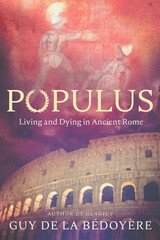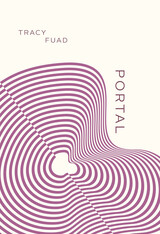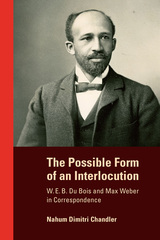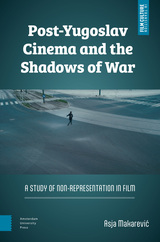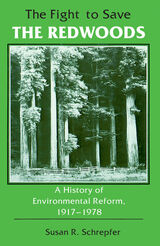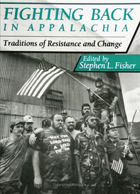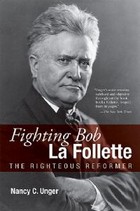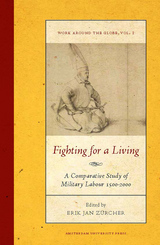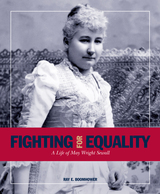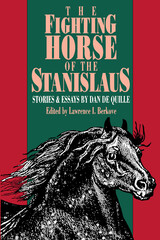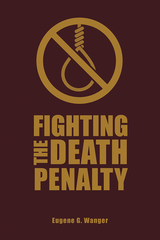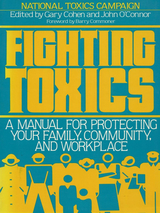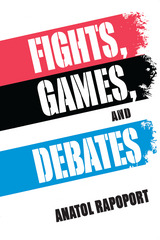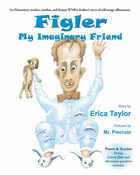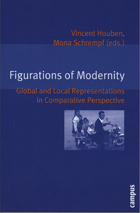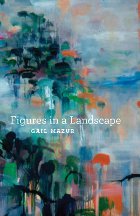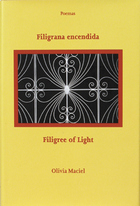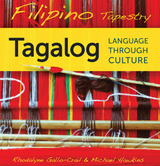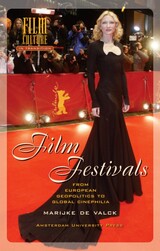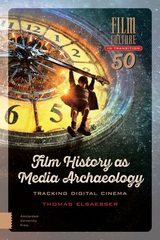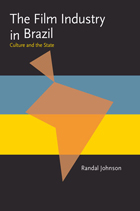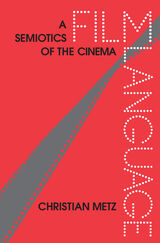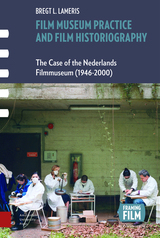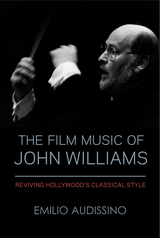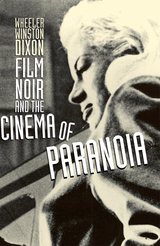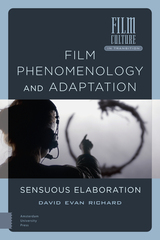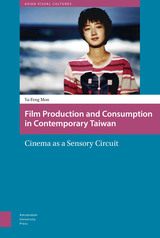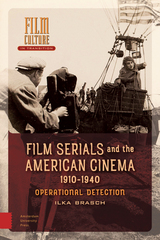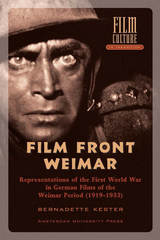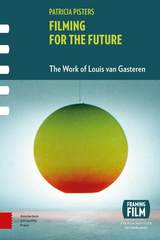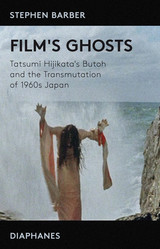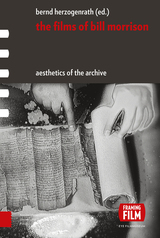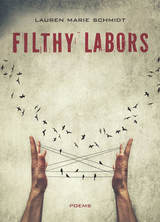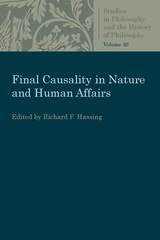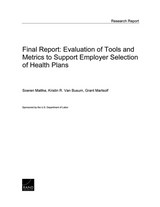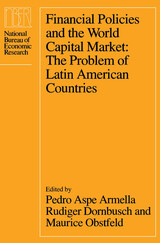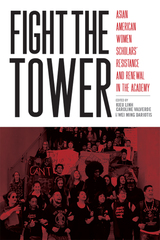 Fight the Tower: Asian American Women Scholars’ Resistance and Renewal in the Academy
Kieu Linh Caroline Valverde
Rutgers University Press, 2020 Asian American women scholars experience shockingly low rates of tenure and promotion because of the particular ways they are marginalized by the intersectionalities of race and gender in academia. Although Asian American studies critics have long since debunked the model minority myth that constructs Asian Americans as the ideal academic subject, university administrators still treat Asian American women in academia as though they will simply show up and shut up. Consequently, because silent complicity is expected, power holders will punish and oppress Asian American women severely when they question or critique the system.
However, change is in the air. Fight the Tower is a continuation of the Fight the Tower movement, which supports women standing up for their rights to claim their earned place in academia and to work for positive change for all within academic institutions. The essays provide powerful portraits, reflections, and analyses of a population often rendered invisible by the lies that sustain intersectional injustices in order to operate an oppressive system.
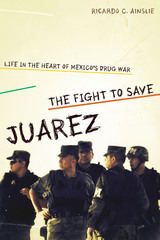 The Fight to Save Juárez: Life in the Heart of Mexico's Drug War
By Ricardo C. Ainslie
University of Texas Press, 2013 The city of Juárez is ground zero for the drug war that is raging across Mexico and has claimed close to 60,000 lives since 2007. Almost a quarter of the federal forces that former President Felipe Calderón deployed in the war were sent to Juárez, and nearly 20 percent of the country’s drug-related executions have taken place in the city, a city that can be as unforgiving as the hardest places on earth. It is here that the Mexican government came to turn the tide. Whatever happens in Juárez will have lasting repercussions for both Mexico and the United States. Ricardo Ainslie went to Juárez to try to understand what was taking place behind the headlines of cartel executions and other acts of horrific brutality. In The Fight to Save Juárez, he takes us into the heart of Mexico’s bloodiest city through the lives of four people who experienced the drug war from very different perspectives—Mayor José Reyes Ferriz, a mid-level cartel player’s mistress, a human rights activist, and a photojournalist. Ainslie also interviewed top Mexican government strategists, including members of Calderón’s security cabinet, as well as individuals within U.S. law enforcement. The dual perspective of life on the ground in the drug war and the “big picture” views of officials who are responsible for the war’s strategy, creates a powerful, intimate portrait of an embattled city, its people, and the efforts to rescue Juárez from the abyss.
The Fight to Save the Redwoods: A History of the Environmental Reform, 1917–1978
Susan R. Schrepfer
University of Wisconsin Press, 1983 "This is not a simple or ordinary history of a conservation crusade. Schrepfer very ably traces the changes in scientific wisdom from nineteenth-century romanticism and teleological evolutionism to more current ecological dynamism—and the influence of those intellectual developments on political history. . . . The subject is important—much broader than the title suggests—and so is the book."—American Historical Review
 Fighter Aircraft Combat Debuts, 1915–1945: Innovation in Air Warfare Before the Jet Age
Jon Guttman
Westholme Publishing, 2014 An International History of the Development, Competition, and Deployment of High-Speed, Maneuverable, Fighter Aircraft During the Era of the World Wars
Of all military aircraft, fighter planes hold a mystique all their own. Perhaps it is because fighters can afford the least compromise: when the goal is to seize and maintain control of the air, the confrontation is direct. During World War I, the concept of air superiority took hold and in the ensuing decades the development of fighter aircraft became an ongoing back-and-forth battle, with adversaries trying to gain an upper hand through innovations in aerodynamics, powerplants, and armament. Fighter Aircraft Combat Debuts, 1915–1945: Innovation in Air Warfare Before the Jet Age by prominent aviation expert Jon Guttman explores the first combats for a variety of fighters of World War I, the conflicts of the so-called "interwar years," and World War II—a thirty-year period that saw the birth of the fighter concept and its maturity on the threshold of the Jet Age. Most of the aircraft described are fairly well known to aviation historians and a few names, such as Sopwith Camel, Fokker Triplane, Messerschmitt Me-109, Mitsubishi Zero, North American Mustang, and Supermarine Spitfire, are familiar even to the most nonaviation- minded persons. Not so well-known are the circumstances of their combat debuts, in which some, such as the Zero, made their mark almost from the outset, but in which others, like the British Bristol F.2A, showed rather less promise than they would ultimately realize. While a certain amount of space must be devoted to the technical development of these famous fighters, these studies of first combats serve as a reminder that it is the human factor, with all its special quirks, that inevitably came into play when these deadly flying machines first fired their guns. Profusely illustrated, Fighter Aircraft Combat Debuts is an authoritative history of one of the most enduring subjects in military aviation.
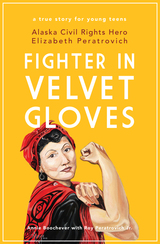 Fighter in Velvet Gloves: Alaska Civil Rights Hero Elizabeth Peratrovich
Annie Boochever with Roy Peratrovich Jr.
University of Alaska Press, 2019 “No Natives or Dogs Allowed,” blared the storefront sign at Elizabeth Peratrovich, then a young Alaska Native Tlingit. The sting of those words would stay with her all her life. Years later, after becoming a seasoned fighter for equality, she would deliver her own powerful message: one that helped change Alaska and the nation forever.
In 1945, Peratrovich stood before the Alaska Territorial Legislative Session and gave a powerful speech about her childhood and her experiences being treated as a second-class citizen. Her heartfelt testimony led to the passing of the landmark Alaska Anti-Discrimination Act, America’s first civil rights legislation. Today, Alaska celebrates Elizabeth Peratrovich Day every February 16, and she was honored on the gold one-dollar coin in 2020.
Annie Boochever worked with Elizabeth’s eldest son, Roy Peratrovich Jr., to bring Elizabeth’s story to life in the first book written for young teens on this remarkable Alaska Native woman.
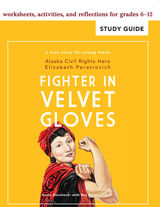 Fighter in Velvet Gloves: Study Guide
Annie Boochever
University of Alaska Press, 2021 In 1945, Elizabeth Peratrovich stood before the Alaska Territorial Legislative Session and gave a powerful speech about her childhood and her experiences being treated as a second-class citizen. Her heartfelt testimony led to the passing of the landmark Alaska Anti-Discrimination Act, America’s first civil rights legislation. Today, Alaska celebrates Elizabeth Peratrovich Day every February 16, and Elizabeth Peratrovich was honored on the gold dollar coin in 2020.
Annie Boochever worked with Elizabeth’s eldest son, Roy Peratrovich Jr., to bring Elizabeth’s story to life in the first book written for young teens on this remarkable Alaska Native woman. Written about an Alaska Native civil rights leader, Fighter in Velvet Gloves has been incorporated in school curricula around the country, and won the 2019 Lumen Award for Literary Excellence, in addition to receiving many other national recognitions. This study guide is a custom work designed to help instructors teach the story of Elizabeth Peratrovich to students in grades 6 through 12.
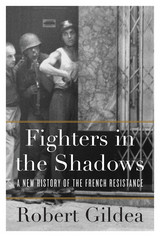 Fighters in the Shadows: A New History of the French Resistance
Robert Gildea
Harvard University Press, 2015 The French Resistance has an iconic status in the struggle to liberate Nazi-occupied Europe, but its story is entangled in myths. Gaining a true understanding of the Resistance means recognizing how its image has been carefully curated through a combination of French politics and pride, ever since jubilant crowds celebrated Paris’s liberation in August 1944. Robert Gildea’s penetrating history of resistance in France during World War II sweeps aside “the French Resistance” of a thousand clichés, showing that much more was at stake than freeing a single nation from Nazi tyranny.
As Fighters in the Shadows makes clear, French resistance was part of a Europe-wide struggle against fascism, carried out by an extraordinarily diverse group: not only French men and women but Spanish Republicans, Italian anti-fascists, French and foreign Jews, British and American agents, and even German opponents of Hitler. In France, resistance skirted the edge of civil war between right and left, pitting non-communists who wanted to drive out the Germans and eliminate the Vichy regime while avoiding social revolution at all costs against communist advocates of national insurrection. In French colonial Africa and the Near East, battle was joined between de Gaulle’s Free French and forces loyal to Vichy before they combined to liberate France.
Based on a riveting reading of diaries, memoirs, letters, and interviews of contemporaries, Fighters in the Shadows gives authentic voice to the resisters themselves, revealing the diversity of their struggles for freedom in the darkest hours of occupation and collaboration.
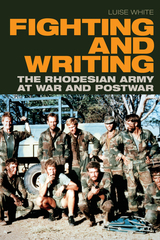 Fighting and Writing: The Rhodesian Army at War and Postwar
Luise White
Duke University Press, 2021 In Fighting and Writing Luise White brings the force of her historical insight to bear on the many war memoirs published by white soldiers who fought for Rhodesia during the 1964–1979 Zimbabwean liberation struggle. In the memoirs of white soldiers fighting to defend white minority rule in Africa long after other countries were independent, White finds a robust and contentious conversation about race, difference, and the war itself. These are writings by men who were ambivalent conscripts, generally aware of the futility of their fight—not brutal pawns flawlessly executing the orders and parroting the rhetoric of a racist regime. Moreover, most of these men insisted that the most important aspects of fighting a guerrilla war—tracking and hunting, knowledge of the land and of the ways of African society—were learned from black playmates in idealized rural childhoods. In these memoirs, African guerrillas never lost their association with the wild, even as white soldiers boasted of bringing Africans into the intimate spaces of regiment and regime.
Fighting Back in Appalachia: Traditions of Resistance and Change
edited by Stephen L. Fisher
Temple University Press, 1993 Sixteen original essays document the extent and variety of citizen resistance and struggle in the Appalachian region since 1960. The contributors-all organizers or activist intellectuals-describe how and why some of the dramatic Appalachian resistance efforts and strategies have arisen. Contributors: Bill Allen, Mary K. Anglin, Fran Ansley, Alan Banks, Dwight Billings, Mary Beth Bingman, Sherry Cable, Guy and Candie Carawan, Richard A. Couto, Stephen William Foster, John M. Glen, Hal Hamilton, Bennett M. Judkins, Don Manning-Miller, Ellen Ryan, Jim Sessions, Joe Szakos, Karen Tice, Chris Weiss, and the editor.
Fighting Bob La Follette: The Righteous Reformer
Nancy C Unger
Wisconsin Historical Society Press, 2008 Now in paperback with a new preface, this comprehensive biography weaves the triumph and the tragedy of the public and private lives of the most famous of Wisconsin leaders, Robert "Fighting Bob" La Follette. As a U.S. representative, governor of Wisconsin, and U.S. Senator, La Follette's political legacies have been long lasting; among them are the election of senators by constituents, creation of the Department of Labor and the Federal Trade Commission, women's suffrage, and workers' compensation. Through the personal letters, diaries, and documents of the La Follette family, Unger uses the private life of La Follette as a means for understanding the public figure. Thoroughly researched and documented, Fighting Bob La Follette: The Righteous Reformer is a testament to the progressive tradition in Wisconsin and its premier leader.
 Fighting Corporate Abuse: Beyond Predatory Capitalism
Corporate Reform Collective
Pluto Press, 2014 Fighting Corporate Abuse demonstrates, through compelling and revelatory analysis, the legislation and regulation needed to deal with the abuses in the corporate sector that have been revealed in recent years. It highlights the more general contribution of company law and practice to the current crisis in capitalism.
The first section develops a controversial argument, using detailed illustrations and vivid examples which show how the various abuses of predatory capitalism have been carried out through the manipulation of the corporate form and the creation of highly complex corporate groups. The group of authors, all experts in their fields, tackle head-on the issues of tax evasion, extraction of value and asset stripping, environmental destruction and managerial self-interest. In doing so, they paint a picture of a system that is abusive, and degenerated, but also a system which can be reformed.
In the run up to the UK general election, the authors develop of a set of practical proposals for an incoming government, outlining how each of these abuses could be curtailed and how a more acceptable and accountable form of corporate capitalism can be developed through national and international action.
Drawing on the group’s activism, as well as their academic experience in law, politics, economics and human rights, this will be an authoritative as well as a highly practical book.
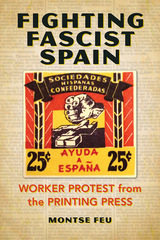 Fighting Fascist Spain: Worker Protest from the Printing Press
Montse Feu
University of Illinois Press, 2020 In the 1930s, anarchists and socialists among Spanish immigrants living in the United States created España Libre ( Free Spain) as a response to the Nationalist takeover in their homeland. Worker-oriented and avowedly antifascist, the grassroots periodical raised money for refugees and political prisoners while advancing left-wing culture and politics. España Libre proved both visionary and durable, charting an alternate path toward a modern Spain and enduring until democracy's return to the country in 1977. Montse Feu merges España Libre's story with the drama of the Spanish immigrant community's fight against fascism. The periodical emerged as part of a transnational effort to link migrants and new exiles living in the United States to antifascist networks abroad. In addition to showing how workers' culture and politics shaped their antifascism, Feu brings to light creative works that ranged from literature to satire to cartoons to theater. As España Libre opened up radical practices, it encouraged allies to reject violence in favor of social revolution's potential for joy and inclusion.
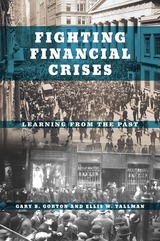 Fighting Financial Crises: Learning from the Past
Gary B. Gorton and Ellis W. Tallman
University of Chicago Press, 2018 If you’ve got money in the bank, chances are you’ve never seriously worried about not being able to withdraw it. But there was a time in the United States, an era that ended just over a hundred years ago, when bank customers had to pay close attention to the solvency of the banking system, knowing they might have to rush to retrieve their savings before the bank collapsed. During the National Banking Era (1863–1913), before the establishment of the Federal Reserve, widespread banking panics were indeed rather common.
Yet these pre-Fed banking panics, as Gary B. Gorton and Ellis W. Tallman show, bear striking similarities to our recent financial crisis. Fighting Financial Crises thus turns to the past to better understand our uncertain present, investigating how panics during the National Banking Era played out and how they were eventually quelled and prevented. The authors then consider the Fed’s and the SEC’s reactions to the recent crisis, building an informative new perspective on how the modern economy works.
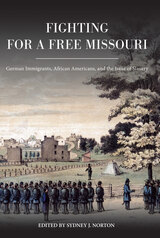 Fighting for a Free Missouri: German Immigrants, African Americans, and the Issue of Slavery
Sydney J. Norton
University of Missouri Press, 2023 Missouri is well-known for its German American heritage, but the story of nineteenth-century German immigrant abolitionists is often neglected in discussions of the state’s history. This collection of ten original essays (with a foreword by renowned Missouri historian Gary Kremer), relates what unfolded when idealistic Germans, many of whom were highly educated and devoted to the ideals of freedom and democracy, left their homeland and settled in a pre–Civil War slave state. Fleeing political persecution during the 1830s and 1840s, immigrants such as Friedrich Münch, Eduard Mühl, Heinrich Boernstein, and Arnold Krekel arrived in the area now known as the Missouri German Heritage Corridor in hopes of finding a land more congenial to their democratic ideals. When they witnessed the state of enslaved Blacks, many of them became abolitionist activists and fervent supporters of Abraham Lincoln and the Union in the emerging Civil War. Editor Sydney Norton and the other contributing authors to Fighting for a Free Missouri explore the Germans’ abolitionist mission, their relationships with African Americans, and their activity in the radical wing of the Republican Party.
Fighting for a Living: A Comparative Study of Military Labour 1500-2000
Edited by Erik Jan Zürcher
Amsterdam University Press, 2014 Though fighting is clearly hard work, historians have not paid much attention to warfare and military service as forms of labor. This collection does just that, bringing together the usually disparate fields of military and labor history. The contributors—including Robert Johnson, Frank Tallett, and Gilles Veinstein—undertake the first systematic comparative analysis of military labor across Europe, Africa, America, the Middle East, and Asia. In doing so, they explore the circumstances that have produced starkly different systems of recruiting and employing soldiers in different parts of the globe over the last five hundred years.
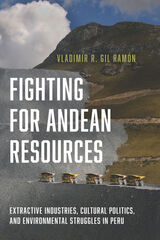 Fighting for Andean Resources: Extractive Industries, Cultural Politics, and Environmental Struggles in Peru
Vladimir R. Gil Ramón, Foreword by Enrique Mayer
University of Arizona Press, 2020 2021 American Anthropological Association´s, finalist of the Association for Political and Legal Anthropology Book Prize in Critical Anthropology
Mining investment in Peru has been presented as necessary for national progress; however, it also has brought socioenvironmental costs, left unfulfilled hopes for development, and has become a principal source of confrontation and conflict. Fighting for Andean Resources focuses on the competing agendas for mining benefits and the battles over their impact on proximate communities in the recent expansion of the Peruvian mining frontier. The book complements renewed scrutiny of how globalization nurtures not solely antagonism but also negotiation and participation. Having mastered an intimate knowledge of Peru, Vladimir R. Gil Ramón insightfully documents how social technologies of power are applied through social technical protocols of accountability invoked in defense of nature and vulnerable livelihoods. Although analyses point to improvements in human well-being, a political and technical debate has yet to occur in practice that would define what such improvements would be, the best way to achieve and measure them, and how to integrate dimensions such as sustainability and equity. Many confrontations stem from frustrated expectations, environmental impacts, and the virtual absence of state apparatus in the locations where new projects emerged. This book presents a multifaceted perspective on the processes of representation, the strategies in conflicts and negotiations of development and nature management, and the underlying political actions in sites affected by mining.
Fighting for Equality: A Life of May Wright Sewall
Ray E. Boomhower
Indiana Historical Society Press, 2007 This young readers' biography showcases educator, woman's rights pioneer, and peace activist May Wright Sewall's important contributions to the history of Indianapolis, Indiana, the United States, and the world. Sewall helped to establish such Indianapolis institutions as the Girls' Classical School, the Indianapolis Woman's Club, the Contemporary Club, the Art Association of Indianapolis (today known as the Indianapolis Museum of Art) and the Indianapolis Propylaeum. She served as a valuable ally to such national suffrage leaders as Susan B. Anthony and Elizabeth Cady Stanton and gave the woman's movement a worldwide focus through her pioneering involvement with the American National Council of Women and the International Council of Women.
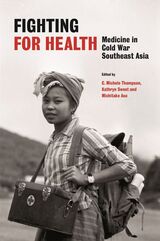 Fighting for Health: Medicine in Cold War Southeast Asia
Edited by C. Michele Thompson, Kathryn Sweet, and Michitake Aso
National University of Singapore Press, 2024 An overlooked history of Southeast Asia’s varied healthcare regimes during the Cold War.
For far too long, Southeast Asia has been treated as a static backdrop for the exploits and discoveries of Western biomedical doctors. Yet, Southeast Asians have been vital to the significant developments in the prevention and treatment of diseases that have taken place in the region and beyond. Many of the institutions and people that shaped subsequent responses to outbreaks, epidemics, and pandemics first began their work in Southeast Asia during the Cold War. The diversity of approaches to health and medicine during that era also reminds us of the possibilities, and limits, of human intervention in the face of political, social, economic, and microbial realities. The people and places of Southeast Asia have provided clinical trials for different health regimes. Fighting for Health highlights new perspectives and methods that have evolved from research presented at regional conferences, including the History of Medicine in Southeast Asia (HOMSEA) series. These insights serve to challenge dominant models of the medical humanities.
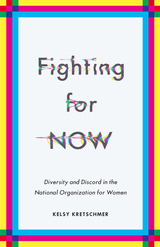 Fighting for NOW: Diversity and Discord in the National Organization for Women
Kelsy Kretschmer
University of Minnesota Press, 2019 An unparalleled exploration of NOW’s trajectory, from its founding to the present—and its future
A new wave of feminist energy has swept the globe since 2016—from women’s marches and the #MeToo movement to transwomen’s inclusion and exclusion in feminism and participation in institutional politics. Amid all this, an organization declared dead or dying for thirty years—the National Organization for Women—has seen a membership boom. NOW presents an intriguing puzzle for scholars and activists alike. Considered one of the most stable organizations in the feminist movement, it has experienced much conflict and schism. Scholars have long argued that factionalism is the death knell of organizations, yet NOW continues to thrive despite internal conflicts. Fighting for NOW seeks to better understand how bureaucratic structures like NOW’s simultaneously provide stability and longevity, while creating space for productive and healthy conflict among members. Kelsy Kretschmer explores these ideas through an examination of conflict in NOW’s local chapters, its task forces and committees, and its satellite groups. NOW’s history provides evidence for three basic arguments: bureaucratic groups are not insulated from factionalism; they are important sites of creativity and innovation for their movements; and schisms are not inherently bad for movement organizations. Hence, Fighting for NOW is in stark contrast to conventional scholarship, which has conceptualized factionalism as organizational failure. It also provides one of the few book-length explorations of NOW’s trajectory, from its founding to the modern context. Scholars will welcome the book’s insights that draw on open systems and resource dependency theories, as well as its rethinking of how conflict shapes activist communities. Students will welcome its clear and compelling history of the feminist movement and of how feminist ideas have changed over the past five decades.
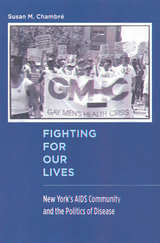 Fighting For Our Lives: New York's AIDS Community and the Politics of Disease
Chambré, Susan M
Rutgers University Press, 2006 In the first decade of the AIDS epidemic, New York City was struck like no other. By the early nineties, it was struggling with more known cases than the next forty most infected cities, including San Francisco, combined. Fighting for Our Lives is the first comprehensive social history of New York's AIDS community-a diverse array of people that included not only gay men, but also African Americans, Haitians, Latinos, intravenous drug users, substance abuse professionals, elite supporters, and researchers. Looking back over twenty-five years, Susan Chambré focuses on the ways that these disparate groups formed networks of people and organizations that-both together and separately-supported persons with AIDS, reduced transmission, funded research, and in the process, gave a face to an epidemic that for many years, whether because of indifference, homophobia, or inefficiency, received little attention from government or health care professionals. Beyond the limits of New York City, and even AIDS, this case study also shows how any epidemic provides a context for observing how societies respond to events that expose the inadequacies of their existing social and institutional arrangements. By drawing attention to the major faults of New York's (and America's) response to a major social and health crisis at the end of the twentieth century, the book urges more effective and sensitive actions-both governmental and civil-in the future.
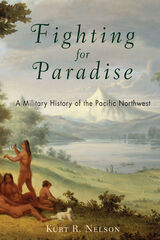 Fighting for Paradise: A Military History of the Pacific Northwest
Kurt R. Nelson
Westholme Publishing, 2007 One of the Most Important Battlegrounds in the History of America While it is in the eastern United States where most Americans identify our military history, the vast, resource-rich Pacific Northwest, stretching from Northern California through British Columbia, endured a series of battles and wars over the course of the nineteenth century that were of regional and national importance. It was here where Great Britain and the United States had their final confrontation in the Americas, where Chief Joseph attempted to secure independence for the Nez Perce, and where the Oregon Trail marked the first great migration to the West of settlers bent on carving out new lives in the wilderness. The Pacific Northwest also saw some of the only attacks on the mainland by Japan during World War II. Beginning with the earliest known accounts of wars among the American Indians of the region, Fighting for Paradise: A Military History of the Pacific Northwest describes early European contact, including British trappers of the Hudson's Bay Company, the Lewis and Clark Expedition, Jedediah Smith, and John Jacob Astor's trading post. The competition over the lucrative fur trade led to the "Pig War," which almost resulted in another armed conflict between Great Britain and the United States, but it was the influx of settlers from the Oregon Trail that touched off the long bitter battles between whites and American Indians. Starting with the 1847 Whitman Massacre and the ensuing war it touched off, the book covers the next three decades of violence, ending with the Sheepeater's War in 1879. Kurt R. Nelson then relates the Pacific Northwest's contributions to the Spanish-American and Philippine-American Wars, the Mexican Punitive Expedition, World War I, and finally World War II, where the region fought Japanese submarine attacks and was harassed by balloon bombs. Throughout, the author provides current information about the state of preservation of various battle sites and other points of historical interest. Accompanied by maps and photographs, Fighting for Paradise provides insight into an area of American military history, rich in drama, that is not generally known.
Fighting for Public Services: Better Lives, A Better World
Fritz Keller and Andreas Hoferl
Pluto Press, 2008 This book celebrates the centennial anniversary of Public Services International.
It provides a full account of trade union history and activism across the public sector worldwide. Examining the major political events of the 20th century, the book shows what challenges they presented to the PSI and its major unions. It shows how the public sector responded to the two World Wars, the rise of fascism, the Cold war, and the independence struggles in the former colonies.
It also provides a comprehensive account of the evolution of public service provision, from public health to policing, water, pensions, security and culture. It includes many examples of how the recent liberalization and privatization of public services has failed to secure efficiency and equity.
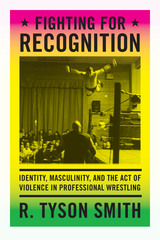 Fighting for Recognition: Identity, Masculinity, and the Act of Violence in Professional Wrestling
R. Tyson Smith
Duke University Press, 2014 In Fighting for Recognition, R. Tyson Smith enters the world of independent professional wrestling, a community-based entertainment staged in community centers, high school gyms, and other modest venues. Like the big-name, televised pro wrestlers who originally inspired them, indie wrestlers engage in choreographed fights in character. Smith details the experiences, meanings, and motivations of the young men who wrestle as "Lethal" or "Southern Bad Boy," despite receiving little to no pay and risking the possibility of serious and sometimes permanent injury. Exploring intertwined issues of gender, class, violence, and the body, he sheds new light on the changing sources of identity in a postindustrial society that increasingly features low wages, insecure employment, and fragmented social support. Smith uncovers the tensions between strength and vulnerability, pain and solidarity, and homophobia and homoeroticism that play out both backstage and in the ring as the wrestlers seek recognition from fellow performers and devoted fans.
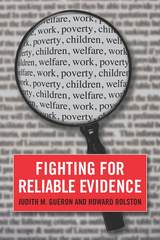 Fighting for Reliable Evidence
Judith M. Gueron
Russell Sage Foundation, 2013 Once primarily used in medical clinical trials, random assignment experimentation is now accepted among social scientists across a broad range of disciplines. The technique has been used in social experiments to evaluate a variety of programs, from microfinance and welfare reform to housing vouchers and teaching methods. How did randomized experiments move beyond medicine and into the social sciences, and can they be used effectively to evaluate complex social problems? Fighting for Reliable Evidence provides an absorbing historical account of the characters and controversies that have propelled the wider use of random assignment in social policy research over the past forty years. Drawing from their extensive experience evaluating welfare reform programs, noted scholar practitioners Judith M. Gueron and Howard Rolston portray randomized experiments as a vital research tool to assess the impact of social policy. In a random assignment experiment, participants are sorted into either a treatment group that participates in a particular program, or a control group that does not. Because the groups are randomly selected, they do not differ from one another systematically. Therefore any subsequent differences between the groups can be attributed to the influence of the program or policy. The theory is elegant and persuasive, but many scholars worry that such an experiment is too difficult or expensive to implement in the real world. Can a control group be truly insulated from the treatment policy? Would staffers comply with the random allocation of participants? Would the findings matter? Fighting for Reliable Evidence recounts the experiments that helped answer these questions, starting with the income maintenance experiments and the Supported Work project in the 1960s and 1970s. Gueron and Rolston argue that a crucial turning point came during the 1980s, when Congress allowed states to experiment with welfare programs and foundations, states, and the federal government funded larger randomized trials to assess the impact of these reforms. As they trace these historical shifts, Gueron and Rolston discuss the ways that strategies for resolving theoretical and practical problems were developed, and they highlight the strict conditions required to execute a randomized experiment successfully. What emerges is a nuanced portrait of the potential and limitations of social experiments to advance empirical knowledge. Weaving history, data analysis and personal experience, Fighting for Reliable Evidence offers valuable lessons for researchers, policymakers, funders, and informed citizens interested in isolating the effect of policy initiatives. It is an essential primer on welfare policy, causal inference, and experimental designs.
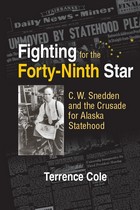 Fighting for the Forty-Ninth Star: C. W. Snedden and the Crusade for Alaska Statehood
Terrence Cole
University of Alaska Press, 2010 When Alaskans in the 1950s demanded an end to "second-class citizenship" of territorial status, southern powerbrokers on Capitol Hill were the primary obstacles. They feared a forty-ninth state would tip the balance of power against segregation, and therefore keeping Alaska out of the Union was simply another means of keeping black children out of white schools.
C.W. "Bill" Snedden, the publisher of America's farthest north daily newspaper, the Fairbanks Daily News-Miner, helped lead the battle of the Far North against the Deep South. Working behind the scenes with his protege, a young attorney named Ted Stevens, and a fellow Republican newspaperman, Secretary of Interior Fred Seaton, Snedden's "magnificent obsession" would open the door to development of the oil fields at Prudhoe Bay, inspire establishment of the Arctic Wildlife Range (now the Arctic National Wildlife Refuge), and add the forty-ninth star to the flag.
Fighting for the Forty-Ninth Star is the story of how the publisher of a little newspaper four thousand miles from Washington, D.C., helped convince Congress that Alaskans should be second-class citizens no more.
 Fighting for the Future of Food: Activists versus Agribusiness in the Struggle over Biotechnology
Rachel Schurman
University of Minnesota Press, 2010 When scientists working in the agricultural biotechnology industry first altered the genetic material of one organism by introducing genes from an entirely different organism, the reaction was generally enthusiastic. To many, these genetically modified organisms (GMOs) promised to solve the challenges faced by farmers and to relieve world hunger. Yet within a decade, this "gene revolution" had abruptly stalled. Widespread protests against the potential dangers of "Frankenfoods" and the patenting of seed supplies in the developing world forced the industry to change course. As a result, in the late 1990s, some of the world's largest firms reduced their investment in the agricultural sector, narrowed their focus to a few select crops, or sold off their agricultural divisions altogether.
Fighting for the Future of Food tells the story of how a small group of social activists, working together across tables, continents, and the Internet, took on the biotech industry and achieved stunning success. Rachel Schurman and William A. Munro detail how the anti-biotech movement managed to alter public perceptions about GMOs and close markets to such products. Drawing strength from an alternative worldview that sustained its members' sense of urgency and commitment, the anti-GMO movement exploited political opportunities created by the organization and culture of the biotechnology industry itself.
Fighting for the Future of Food ultimately addresses society's understanding and trust (or mistrust) of technological innovation and the complexities of the global agricultural system that provides our food.
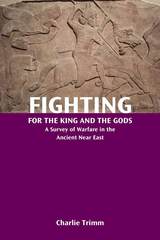 Fighting for the King and the Gods: A Survey of Warfare in the Ancient Near East
Charlie Trimm
SBL Press, 2017 The most up-to-date sourcebook on warfare in the ancient Near East
Fighting for the King and the Gods provides an introduction to the topic of war and the variety of texts concerning many aspects of warfare in the ancient Near East. These texts illustrate various viewpoints of war and show how warfare was an integral part of life. Trimm examines not only the victors and the famous battles, but also the hardship that war brought to many. While several of these texts treated here are well known (i.e., Ramses II's battle against the Hittites at Qadesh), others are known only to specialists. This work will allow a broader audience to access and appreciate these important texts as they relate to the history and ideology of warfare.
Features
- References to recent secondary literature for further study
- Early Greek and Chinese illustrative texts for comparisons with other cultures
- Indices to help guide the reader
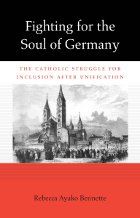 Fighting for the Soul of Germany: The Catholic Struggle for Inclusion after Unification
Rebecca Ayako Bennette
Harvard University Press, 2012 Historians have long believed that Catholics were late and ambivalent supporters of the German nation. Rebecca Ayako Bennette’s bold new interpretation demonstrates definitively that from the beginning in 1871, when Wilhelm I was proclaimed Kaiser of a unified Germany, Catholics were actively promoting a German national identity for the new Reich.
In the years following unification, Germany was embroiled in a struggle to define the new nation. Otto von Bismarck and his allies looked to establish Germany as a modern nation through emphasis on Protestantism and military prowess. Many Catholics feared for their future when he launched the Kulturkampf, a program to break the political and social power of German Catholicism. But these anti-Catholic policies did not destroy Catholic hopes for the new Germany. Rather, they encouraged Catholics to develop an alternative to the Protestant and liberal visions that dominated the political culture. Bennette’s reconstruction of Catholic thought and politics sheds light on several aspects of German life. From her discovery of Catholics who favored a more “feminine” alternative to Bismarckian militarism to her claim that anti-socialism, not anti-Semitism, energized Catholic politics, Bennette’s work forces us to rethink much of what we know about religion and national identity in late nineteenth-century Germany.
 Fighting for Their Lives: Inside the Experience of Capital Defense Attorneys
Susannah Sheffer
Vanderbilt University Press, 2013 How do attorneys who represent clients facing the death penalty cope with the stress and trauma of their work? Through conversations with twenty of the most experienced and dedicated post-conviction capital defenders in the United States, Fighting for Their Lives explores this emotional territory for the first time. What it is like for these capital defenders in their last visits or phone calls with clients who are about to be taken to the execution chamber? Or the next mornings, in their lives with their families, in their dreams and flashbacks and moments alone in the car? What is it like to do this work year after year? (These attorneys had, on average, spent nineteen years doing capital defense.)
Through vivid interviews amplified by the author's responses and commentary, these attorneys reveal aspects of their internal experience that they have never talked about until now. How do capital defenders manage the weight of the responsibility they carry? To what extent do they experience symptoms of trauma in the aftermath of losing a client to execution or as a result of the cumulative effects of engaging in capital defense work? What motivates them, and what do they draw upon, in order to keep engaging in such emotionally demanding work? Have they considered practicing other types of law? What can we learn from capital defenders not only about the deep and long-term effects of the death penalty but also about broader human questions of hope, effectiveness, success, failure, strength, fragility, and perseverance?
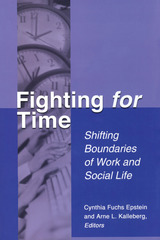 Fighting For Time: Shifting Boundaries of Work and Social Life
Cynthia Fuchs Epstein
Russell Sage Foundation, 2004 Though there are still just twenty-four hours in a day, society's idea of who should be doing what and when has shifted. Time, the ultimate scarce resource, has become an increasingly contested battle zone in American life, with work, family, and personal obligations pulling individuals in conflicting directions. In Fighting for Time, editors Cynthia Fuchs Epstein and Arne Kalleberg bring together a team of distinguished sociologists and management analysts to examine the social construction of time and its importance in American culture. Fighting for Time opens with an exploration of changes in time spent at work—both when people are on the job and the number of hours they spend there—and the consequences of those changes for individuals and families. Contributors Jerry Jacobs and Kathleen Gerson find that the relative constancy of the average workweek in America over the last thirty years hides the fact that blue-collar workers are putting in fewer hours while more educated white-collar workers are putting in more. Rudy Fenwick and Mark Tausig look at the effect of nonstandard schedules on workers' health and family life. They find that working unconventional hours can increase family stress, but that control over one's work schedule improves family, social, and health outcomes for workers. The book then turns to an examination of how time influences the organization and control of work. The British insurance company studied by David Collinson and Margaret Collinson is an example of a culture where employees are judged on the number of hours they work rather than on their productivity. There, managers are under intense pressure not to take legally guaranteed parental leave, and clocks are banned from the office walls so that employees will work without regard to the time. In the book's final section, the contributors examine how time can have different meanings for men and women. Cynthia Fuchs Epstein points out that professional women and stay-at-home fathers face social disapproval for spending too much time on activities that do not conform to socially prescribed gender roles—men are mocked by coworkers for taking paternity leave, while working mothers are chastised for leaving their children to the care of others. Fighting for Time challenges assumptions about the relationship between time and work, revealing that time is a fluid concept that derives its importance from cultural attitudes, social psychological processes, and the exercise of power. Its insight will be of interest to sociologists, economists, social psychologists, business leaders, and anyone interested in the work-life balance.
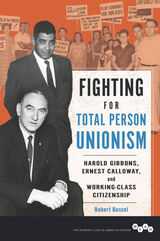 Fighting for Total Person Unionism: Harold Gibbons, Ernest Calloway, and Working-Class Citizenship
Robert Bussell
University of Illinois Press, 2015 During the 1950s and 1960s, labor leaders Harold Gibbons and Ernest Calloway championed a new kind of labor movement that regarded workers as "total persons" interested in both workplace affairs and the exercise of effective citizenship in their communities. Working through Teamsters Local 688 and viewing the city of St. Louis as their laboratory, this remarkable interracial duo forged a dynamic political alliance that placed their "citizen members" on the front lines of epic battles for urban revitalization, improved public services, and the advancement of racial and economic justice. Parallel to their political partnership, Gibbons functioned as a top Teamsters Union leader and Calloway as an influential figure in St. Louis's civil rights movement. Their pioneering efforts not only altered St. Louis's social and political landscape but also raised fundamental questions about the fate of the post-industrial city, the meaning of citizenship, and the role of unions in shaping American democracy.
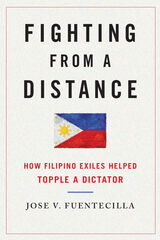 Fighting from a Distance: How Filipino Exiles Helped Topple a Dictator
Jose V. Fuentecilla
University of Illinois Press, 2013 During February 1986, a grassroots revolution overthrew the fourteen-year dictatorship of former president Ferdinand Marcos in the Philippines. In this book, Jose V. Fuentecilla describes how Filipino exiles and immigrants in the United States played a crucial role in this victory, acting as the overseas arm of the opposition to help return their country to democracy. A member of one of the major U.S.-based anti-Marcos movements, Fuentecilla tells the story of how small groups of Filipino exiles--short on resources and shunned by some of their compatriots--arrived and survived in the United States during the 1970s, overcame fear, apathy, and personal differences to form opposition organizations after Marcos's imposition of martial law, and learned to lobby the U.S. government during the Cold War. In the process, he draws from multiple hours of interviews with the principal activists, personal files of resistance leaders, and U.S. government records revealing the surveillance of the resistance by pro-Marcos White House administrations. The first full-length book to detail the history of U.S.-based opposition to the Marcos regime, Fighting from a Distance provides valuable lessons on how to persevere against a well-entrenched opponent.
Fighting Horse Of Stanislaus: Stories Essays Dan De Quille
LAWRENCE I. BERKOVE
University of Iowa Press, 1990 Tongue-Oil Timothy, as unflappable as he is unconscionable, swindles Wasatch Sam in a villainous poker game. Amazed prospectors discover a full-grown silver man deep in a mountain tunnel. Old Pizen, a horse so mean that he was almost poison to himself, is wagered by his own owner in the fight of his life. The travelling stones of Pahranagat, when scattered about the ground, immediately huddle together like eggs in a nest. Highly eccentric but shrewd, itinerant preacher Lorenzo Dow raises the devil. A cheery voiced goblin frog points the way toward the great Comstack silver lode. These tongue-in-cheek creations join Bendix Biargo, the Seven Nimrods of the Sierras, a Female World-Ranger, and Dan De Quille's other unforgettable characters to make the pioneers and Comstockers come alive once more.
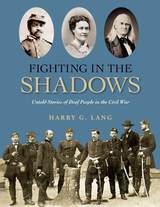 Fighting in the Shadows: Untold Stories of Deaf People in the Civil War
Harry G. Lang
Gallaudet University Press, 2017 This visually rich volume presents Harry G. Lang’s groundbreaking study of deaf people’s experiences in the Civil War. Based on meticulous archival research, Fighting in the Shadows reveals the stories of deaf soldiers and civilians who lived through this transformative period in American history. Lang describes the participation of deaf soldiers in the war, whose personal tests of fortitude and perseverance have not been previously explored. There were also many deaf people in noncombat roles whose stories have not yet been told—clerks and cooks, nurses and spies, tradespeople supporting the armies, farmers supplying food to soldiers, and landowners who assisted (or resisted) troops during battles. Deaf writers, diarists, and artists documented the war. Lang chronicles the lives of people from all walks of life, from common soldiers who faced the daily horrors of war to the extraordinary tale of the deaf poet who was friends with Abraham Lincoln and who also taught sign language to John Wilkes Booth. Even deaf children contributed actively to the war efforts.
Lang pieces together hundreds of stories, accompanied by numerous historical images, to reveal a powerful new perspective on the Civil War. These soldiers and civilians were not “disabled” by their deafness. On the contrary, despite the marginalization and paternalism they experienced in society, they were able to apply their skills and knowledge to support the causes in which they ardently believed.
Fighting in the Shadows is a story of how deaf civilians and soldiers put aside personal concerns about deafness, in spite of the discrimination they faced daily, in order to pursue a cause larger than themselves. Yet their stories have remained in the shadows, leaving most Americans, hearing and deaf, largely unaware of the deaf people who made significant contributions to the events that changed the course of our nation’s history. This book provides new insights into Deaf history as well as into mainstream interpretations of the Civil War.
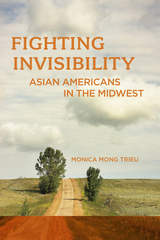 Fighting Invisibility: Asian Americans in the Midwest
Monica Mong Trieu
Rutgers University Press, 2023 In Fighting Invisibility, Monica Mong Trieu argues that we must consider the role of physical and symbolic space to fully understand the nuances of Asian American racialization. By doing this, we face questions such as, historically, who has represented Asian America? Who gets to represent Asian America? This book shifts the primary focus to Midwest Asian America to disrupt—and expand beyond—the existing privileged narratives in United States and Asian American history.
Drawing from in-depth interviews, census data, and cultural productions from Asian Americans in Ohio, Wisconsin, Nebraska, Minnesota, Illinois, Iowa, Indiana, and Michigan, this interdisciplinary research examines how post-1950s Midwest Asian Americans navigate identity and belonging, racism, educational settings, resources within co-ethnic communities, and pan-ethnic cultural community. Their experiences and life narratives are heavily framed by three pervasive themes of spatially defined isolation, invisibility, and racialized visibility.
Fighting Invisibility makes an important contribution to racialization literature, while also highlighting the necessity to further expand the scope of Asian American history-telling and knowledge production.
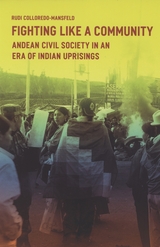 Fighting Like a Community: Andean Civil Society in an Era of Indian Uprisings
Rudi Colloredo-Mansfeld
University of Chicago Press, 2009 The indigenous population of the Ecuadorian Andes made substantial political gains during the 1990s in the wake of a dynamic wave of local activism. The movement renegotiated land development laws, elected indigenous candidates to national office, and successfully fought for the constitutional redefinition of Ecuador as a nation of many cultures. Fighting Like a Community argues that these remarkable achievements paradoxically grew out of the deep differences—in language, class, education, and location—that began to divide native society in the 1960s. Drawing on fifteen years of fieldwork, Rudi Colloredo-Mansfeld explores these differences and the conflicts they engendered in a variety of communities. From protestors confronting the military during a national strike to a migrant family fighting to get a relative released from prison, Colloredo-Mansfeld recounts dramatic events and private struggles alike to demonstrate how indigenous power in Ecuador is energized by disagreements over values and priorities, eloquently contending that the plurality of Andean communities, not their unity, has been the key to their political success.
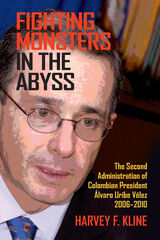 Fighting Monsters in the Abyss: The Second Administration of Colombian President Álvaro Uribe Vélez, 2006–2010
Harvey F. Kline
University of Alabama Press, 2015 Studies the complex constraints and trade-offs the second administration of Colombian President Uribe (2006–2010) encountered as it attempted to resolve that nation’s violent Marxist insurrection and to have a more efficient judicial system
Fighting Monsters in the Abyss offers a deeply insightful analysis of the efforts by the second administration of Colombian President Álvaro Uribe Vélez (2006–2010) to resolve a decades-long Marxist insurgency in one of Latin America’s most important nations. Continuing work from his prior books about earlier Colombian presidents and yet written as a stand-alone study, Colombia expert Harvey F. Kline illuminates the surprising successes and setbacks in Uribe’s response to this existential threat.
In State Building and Conflict Resolution in Colombia, 1986–1994, Kline documented and explained the limited successes of Presidents Virgilio Barco and César Gaviria in putting down the revolutionaries while also confronting challenges from drug dealers and paramilitary groups. The following president Andrés Pastrana then boldly changed course and attempted resolution through negotiations, an effort whose failure Kline examines in Chronicle of a Failure Foretold. In his third book, Showing Teeth to the Dragons, Kline shows how in his first term President Álvaro Uribe Vélez more successfully quelled the insurrection through a combination of negotiated demobilization of paramilitary groups and using US backing to mount more effective military campaigns.
Kline opens Fighting Monsters in the Abyss with a recap of Colombia’s complex political history, the development of Marxist rebels and paramilitary groups and their respective relationships to the narcotics trade, and the attempts of successive Colombian presidents to resolve the crisis. Kline next examines the ability of the Colombian government to reimpose rule in rebel-controlled territories as well as the challenges of administering justice. He recounts the difficulties in the enforcement of the landmark Law of Justice and Peace as well as two significant government scandals, that of the “false positives” (“falsos positivos”) in which innocent civilians were killed by the military to inflate the body counts of dead insurgents and a second scandal related to illegal wiretapping.
In tracing Uribe’s choices, strategies, successes, and failures, Kline also uses the example of Colombia to explore a dimension quite unique in the literature about state building: what happens when some members of a government resort to breaking rules or betraying their societies’ values in well-intentioned efforts to build a stronger state?
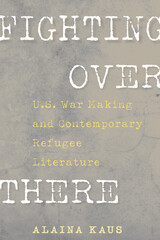 Fighting Over There: U.S. War Making and Contemporary Refugee Literature
Alaina Kaus
University of Massachusetts Press, 2023 U.S. foreign policy has long been built on a dichotomy of an irreplaceable “here” and an expendable “there.” In his 2003 announcement of the military campaign in Iraq, George W. Bush declared that we would fight in the Middle East so we wouldn’t have to fight “on the streets of our cities.” But what do the millions of people who live over “there” have to say about U.S. interventions and the displacement they provoke? In this pathbreaking study, Alaina Kaus analyzes literature by and about refugees who fled Southeast Asia, Central America, the Caribbean, North Africa, and the Middle East, in the wake of U.S. military occupation and economic intervention. Narratives by authors such as Lan Cao, Viet Thanh Nguyen, Demetria Martínez, Héctor Tobar, Dave Eggers, Mohsin Hamid, and Riverbend reveal contradictions in the human rights pledges that undergird U.S. foreign policy, which promote freedom while authorizing intervention and displacement, and favor market-based solutions over social justice and racial equality.
 Fighting Poverty: What Works and What Doesn't
Sheldon H. Danziger
Harvard University Press, 1986 Decades after President Johnson initiated the War on Poverty, it is time for an unbiased assessment of its effects. In this book a distinguished group of economists, sociologists, political scientists, and social policy analysts provide that assessment. Spending on social programs has greatly increased, yet poverty has declined only slightly. Do the numbers alone give an accurate picture? Have the government's efforts, as some critics claim, done more harm than good? The authors of this volume provide a balanced and wide-ranging analysis of antipoverty policies since the 1960s, including both successes and failures.
The evidence shows that simple comparisons of spending levels and poverty trends do not tell the whole story: they obscure the diversity of the poor population and the many complex issues involved in evaluating policies. The authors address such questions as: How do economic growth, social movements, and changes in thewelfare system affect the poor? What economic and political factors influence antipoverty programs, and conversely, what implications do these programs have for employment, education, health care, family structure, and civil rights?The authors' account of past failures and their agenda for the next decade show clearly that much remains to be done. Yet they are not as pessimistic as some writers, who maintain that nothing will work. Rather, they say, nothing will work miracles.
As a guide to the economics and politics of antipoverty programs, this volume is peerless. It is certain to become an important reference for students and scholars in the field, for policy analysts and policymakers, and for program administrators.
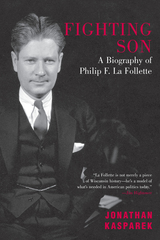 Fighting Son: A Biography of Philip F. La Follette
Jonathan Kasparek
Wisconsin Historical Society Press, 2006 Former Wisconsin governor Philip F. La Follette forged a political path characterized by his progressive, innovative vision. Growing up in the shadow of revered senator "Fighting Bob" La Follette made for a politically charged childhood and laid the groundwork for Phil's emergence as a powerful figure in Wisconsin politics. A gregarious and fiery politician, Phil's efforts led to the passage of the country's first unemployment compensation act, aid programs for workers and farmers, and the reorganization of state government. This approachable, comprehensive book traces La Follette's journey through public office as well as his life after the waning of the Progressive era. Phil La Follette’s is a history of continuing progressivism, of innovative solutions to social problems, and of loyalty to a political ethos that goes far beyond love of country. Kasparek's treatment of this Fighting Son is a monument not only to La Follette but to progressive politics in Wisconsin.
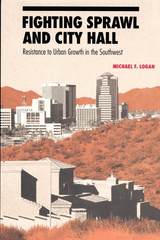 Fighting Sprawl and City Hall: Resistance to Urban Growth in the Southwest
Michael F. Logan
University of Arizona Press, 1995 The line is drawn in cities of the American West: on one side, chambers of commerce, developers, and civic boosters advocating economic growth; on the other, environmentalists and concerned citizens who want to limit what they see as urban sprawl. While this conflict is usually considered to have its origins in the rise of environmental activism during the late 1960s, opposition to urban growth in the Southwest began as early as the economic boom that followed World War II. Evidence of this resistance abounds, but it has been largely ignored by both western and urban historians.
Fighting Sprawl and City Hall now sets the record straight, tracing the roots of antigrowth activism in two southwestern cities, Tucson and Albuquerque, where urbanization proceeded in the face of constant protest. Logan tells how each of these cities witnessed multifaceted opposition to post-war urbanization and a rise in political activism during the 1950s. For each city, he describes the efforts by civic boosters and local government to promote development, showing how these booster-government alliances differed in effectiveness; tells how middle-class Anglos first voiced opposition to annexations and zoning reforms through standard forms of political protest such as referendums and petitions; then documents the shift to ethnic resistance as Hispanics opposed urban renewal plans that targeted barrios. Environmentalism, he reveals, was a relative latecomer to the political arena and became a focal point for otherwise disparate forms of resistance.
Logan's study enables readers to understand not only these similarities in urban activism but also important differences; for example, Tucson provides the stronger example of resistance based on valuation of the physical environment, while Albuquerque better demonstrates anti-annexation politics. For each locale, it offers a testament to grass-roots activism that will be of interest to historians as well as to citizens of its subject cities.
Fighting the Death Penalty: A Fifty-Year Journey of Argument and Persuasion
Eugene G. Wanger
Michigan State University Press, 2019 Michigan is the only state in the country that has a death penalty prohibition in its constitution—Eugene G. Wanger’s compelling arguments against capital punishment is a large reason it is there. The forty pieces in this volume are writings created or used by the author, who penned the prohibition clause, during his fifty years as a death penalty abolitionist. His extraordinary background in forensics, law, and political activity as constitutional convention delegate and co-chairman of the Michigan Committee Against Capital Punishment has produced a remarkable collection. It is not only a fifty-year history of the anti–death penalty argument in America, it also is a detailed and challenging example of how the argument against capital punishment may be successfully made.
 Fighting the Great War: A Global History
Michael S. Neiberg
Harvard University Press, 2006 Despair at Gallipoli. Victory at Vimy Ridge. A European generation lost, an American spirit found. The First World War, the deadly herald of a new era, continues to captivate readers. In this lively book, Michael Neiberg offers a concise history based on the latest research and insights into the soldiers, commanders, battles, and legacies of the Great War.
Tracing the war from Verdun to Salonika to Baghdad to German East Africa, Neiberg illuminates the global nature of the conflict. More than four years of mindless slaughter in the trenches on the western front, World War I was the first fought in three dimensions: in the air, at sea, and through mechanized ground warfare. New weapons systems--tanks, bomber aircraft, and long-range artillery--all shaped the battle environment. Moving beyond the standard portrayal of the war's generals as "butchers and bunglers," Neiberg offers a nuanced discussion of officers constrained by the monumental scale of complex events. Diaries and letters of men serving on the front lines capture the personal stories and brutal conditions--from Alpine snows to Mesopotamian sands--under which these soldiers lived, fought, and died.
Generously illustrated, with many never-before-published photographs, this book is an impressive blend of analysis and narrative. Anyone interested in understanding the twentieth century must begin with its first global conflict, and there is no better place to start than with Fighting the Great War.
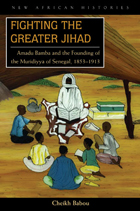 Fighting the Greater Jihad: Amadu Bamba and the Founding of the Muridiyya of Senegal, 1853–1913
Cheikh Anta Babou
Ohio University Press, 2007 In Senegal, the Muridiyya, a large Islamic Sufi order, is the single most influential religious organization, including among its numbers the nation’s president. Yet little is known of this sect in the West. Drawn from a wide variety of archival, oral, and iconographic sources in Arabic, French, and Wolof, Fighting the Greater Jihad offers an astute analysis of the founding and development of the order and a biographical study of its founder, Cheikh Ahmadu Bamba Mbakke. Cheikh Anta Babou explores the forging of Murid identity and pedagogy around the person and initiative of Amadu Bamba as well as the continuing reconstruction of this identity by more recent followers. He makes a compelling case for reexamining the history of Muslim institutions in Africa and elsewhere in order to appreciate believers’ motivation and initiatives, especially religious culture and education, beyond the narrow confines of political collaboration and resistance. Fighting the Greater Jihad also reveals how religious power is built at the intersection of genealogy, knowledge, and spiritual force, and how this power in turn affected colonial policy. Fighting the Greater Jihad will dramatically alter the perspective from which anthropologists, historians, and political scientists study Muslim mystical orders.
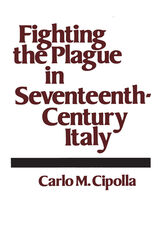 Fighting the Plague in Seventeenth-Century Italy
Carlo M. Cipolla
University of Wisconsin Press, 1981 After the great pandemic of 1348, the plague became endemic in Europe, affecting life at every level for more than three hundred years. In attempting to fight the dread enemy, the North Italian states had developed, by the early sixteenth century, a highly sophisticated system of public health. Special permanent magistracies combining legislative and executive powers were established to administer all public health matters.
In this volume, Carlo M. Cipolla throws new light on the subject, utilizing newly uncovered and significant archival material.
In the first essay, the author analyzes the complex set of interrelationships that existed between theory and practice in Renaissance epidemiology. The significance of this essay goes beyond the history of public health and extends to the larger history of science.
In the second essay, Cipolla studies a case in which health matters became the object of intense diplomatic activity. In that instance, fully sovereign states envisaged interstate controls and relinquished discretionary powers for the sake of the “common health.” Although the concerted effort was short-lived, it does represent an attempt at international health cooperation that was unmatched for another two centuries, until the first International Sanitary Conference, held in Paris in 1851.
In the third essay, unusually detailed statistical documentation allows the author to analyze in detail the demographic, economic, and social aspects of the fight against the plague in a Tuscan city—Pistoia—during the epidemic of 1630–31.
A richly documented appendix, forming an essay in itself, illustrates present knowledge of the clinical, pathological, and epidemiological features of the plague in the sixteenth and seventeenth centuries in Europe.
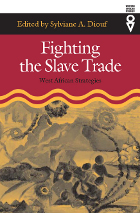 Fighting the Slave Trade: West African Strategies
Sylviane A. Diouf
Ohio University Press, 2003 While most studies of the slave trade focus on the volume of captives and on their ethnic origins, the question of how the Africans organized their familial and communal lives to resist and assail it has not received adequate attention. But our picture of the slave trade is incomplete without an examination of the ways in which men and women responded to the threat and reality of enslavement and deportation.
Fighting the Slave Trade is the first book to explore in a systematic manner the strategies Africans used to protect and defend themselves and their communities from the onslaught of the Atlantic slave trade and how they assaulted it.
It challenges widely held myths of African passivity and general complicity in the trade and shows that resistance to enslavement and to involvement in the slave trade was much more pervasive than has been acknowledged by the orthodox interpretation of historical literature.
Focused on West Africa, the essays collected here examine in detail the defensive, protective, and offensive strategies of individuals, families, communities, and states. In chapters discussing the manipulation of the environment, resettlement, the redemption of captives, the transformation of social relations, political centralization, marronage, violent assaults on ships and entrepôts, shipboard revolts, and controlled participation in the slave trade as a way to procure the means to attack it, Fighting the Slave Trade presents a much more complete picture of the West African slave trade than has previously been available.
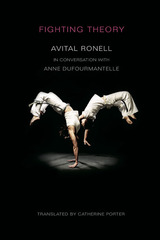 Fighting Theory
Avital Ronell, in conversation with Anne Dufourmantelle
University of Illinois Press, 2010 International interest in the work of Avital Ronell has expressed itself in reviews, articles, essays, and dissertations. For Fighting Theory, psychoanalyst and philosopher Anne Dufourmantelle conducted twelve interviews with Ronell, each focused on a key topic in one of Ronell's books or on a set of issues that run throughout her work. What do philosophy and literary studies have to learn from each other? How does Ronell place her work within gender studies? What does psychoanalysis have to contribute to contemporary thought? What propels one in our day to Nietzsche, Derrida, Nancy, Bataille, and other philosophical writers? How important are courage and revolt? Ronell's discussions of such issues are candid, thoughtful, and often personal, bringing together elements from several texts, illuminating hints about them, and providing her up-to-date reflections on what she had written earlier. Intense and often ironic, Fighting Theory is a poignant self-reflection of the worlds and walls against which Avital Ronell crashed.
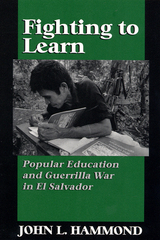 Fighting to Learn: Popular Education and Guerilla War in El Salvador
Hammond, John L
Rutgers University Press, 1998 Popular education played a vital role in the twelve-year guerrilla war against the Salvadoran government. Fighting to Learn is a study of its pedagogy and politics. Inspired by Paulo Freire's literacy work in Brazil in the 1950s, popular education brought literacy to poor rural communities abandoned by the official education system and to peasant combatants in the guerrilla army. Those who had little education taught those who had none. Popular education taught people skills, raised the morale that sustained them in unequal combat, and stimulated the creation of an organizational network to hold them together. Hammond interviewed more than 100 Salvadoran students and teachers for this book. He recounts their experiences in their own words, vividly conveying how they coped with the hardships of war and organized civilian communities politically to support a guerrilla insurgency. Fighting to Learn tells how poorly educated peasants overcame their sense of inferiority to discover that they could teach each other and work together in a common struggle. First examining the Christian base communities through which popular education came to El Salvador, Hammond then discusses how guerrilla combatants, political prisoners, and refugees learned. He shows that education was both a pedagogical and a political practice: he discusses the training of completely inexperienced teachers, the linking of basic literacy skills with politics, and the organizing of communities. Fighting to Learn offers both a detailed account of an historical moment and a broad theoretical discussion of the relationship between education, community organizing, and the political process.
Fighting Toxics: A Manual for Protecting your Family, Community, and Workplace
Edited by Gary Cohen and John O'Connor; Introduction by Barry Commoner; NationalToxics Campaign
Island Press, 1990 Fighting Toxics is a step-by-step guide illustrating how to investigate the toxic hazards that may exist in your community, how to determine the risks they pose to your health, and how to launch an effective campaign to eliminate them.
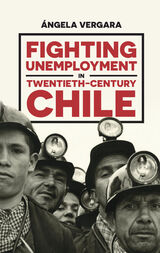 Fighting Unemployment in Twentieth-Century Chile
Ángela Vergara
University of Pittsburgh Press, 2021 In Fighting Unemployment in Twentieth-Century Chile, Ángela Vergara narrates the story of how industrial and mine workers, peasants and day laborers, as well as blue-collar and white-collar employees earned a living through periods of economic, political, and social instability in twentieth-century Chile. The Great Depression transformed how Chileans viewed work and welfare rights and how they related to public institutions. Influenced by global and regional debates, the state put modern agencies in place to count and assist the poor and expand their social and economic rights. Weaving together bottom-up and transnational approaches, Vergara underscores the limits of these policies and demonstrates how the benefits and protections of wage labor became central to people’s lives and culture, and how global economic recessions, political oppression, and abusive employers threatened their working-class culture. Fighting Unemployment in Twentieth-Century Chile contributes to understanding the profound inequality that permeates Chilean history through a detailed analysis of the relationship between welfare professionals and the unemployed, the interpretation of labor laws, and employers’ everyday attitudes.
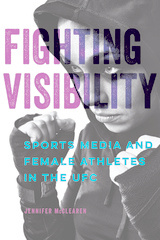 Fighting Visibility: Sports Media and Female Athletes in the UFC
Jennifer McClearen
University of Illinois Press, 2021 Ultimate Fighting Championship and the present and future of women's sports Mixed martial arts stars like Amanda Nunes, Zhang Weili, and Ronda Rousey have made female athletes top draws in the Ultimate Fighting Championship (UFC). Jennifer McClearen charts how the promotion incorporates women into its far-flung media ventures and investigates the complexities surrounding female inclusion. On the one hand, the undeniable popularity of cards headlined by women add much-needed diversity to the sporting landscape. On the other, the UFC leverages an illusion of promoting difference—whether gender, racial, ethnic, or sexual—to grow its empire with an inexpensive and expendable pool of female fighters. McClearen illuminates how the UFC's half-hearted efforts at representation generate profit and cultural cachet while covering up the fact it exploits women of color, lesbians, gender non-conforming women, and others. Thought provoking and timely, Fighting Visibility tells the story of how a sports entertainment phenomenon made difference a part of its brand—and the ways women paid the price for success.
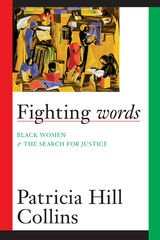 Fighting Words: Black Women and the Search for Justice
Patricia Hill Collins
University of Minnesota Press, 1998 When Black Feminist Thought by Patricia Hill Collins was published in 1990, reviewers called it "remarkable," "rich and valuable," and proclaimed, "with the publication of this book, Black feminism has moved to a new level." Now, in Fighting Words, Collins expands and extends the discussion of the "outsider within" presented in her earlier work, investigating how effectively Black feminist thought confronts the injustices African American women currently face.
Collins takes on a broad range of issues-poverty, mothering, white supremacy and Afrocentrism, the resegregation of American society by race and class, the ideas of Sojourner Truth and how they can serve as a springboard for more liberating social theory. Contrasting social theories that support unjust power relations of race, class, gender, and nation with those that challenge inequalities, Collins investigates why some ideas are granted the status of "theory" while others remain "thought." "It is not that elites produce theory while everyone else produces mere thought," she writes. "Rather, elites possess the power to legitimate the knowledge that they define as theory as being universal, normative, and ideal."
Collins argues that because African American women and other historically oppressed groups seek economic and social justice, their social theories may emphasize themes and work from assumptions that are different from those of mainstream American society, generating new angles of vision on injustice. Collins also puts such oppositional social theory to the test: while the words of these theories may challenge injustice, do the ideas make a difference in the lives of the people they claim to represent?
Throughout, Collins provides an essential understanding of how "outsiders" resist mainstream perspectives, and what the mainstream can learn from such "outsiders." Historically situated yet transcending the specific, Fighting Words provides a new interpretive framework for both thinking through and overcoming social injustice.
"In her perceptive book, Fighting Words, Patricia Hill Collins, a leading scholar in critical theory, argues that intellectuals who break with conventional wisdom are more of a threat to the establishment than their numbers might suggest." Joe R. Feagin in The Chronicle of Higher Education
"Fighting Words is a treatise, if you will, encouraging all black women to engage in dialogue and to reach out to each other, regardless of education, income, or class. Fighting Words is an amazing work in the way it seamlessly combines the histories of black women and feminism. Even more impressive is the way Collins blends her personal experiences as a black woman, educator, and sociologist. Collins is all about telling the truth, now. That is probably why Fighting Words is such a revelation." Black Issues Book Review
"Fighting Words ably demonstrates that Collins is still our leading theorist. Those who understand black women in terms of reductionist categories and who need to read this book probably won't. But it gives the rest of us another sharp implement with which to saw at the ropes." Women's Review of Books
"Collins argues that the political gains of black women's 'talking back' now must be measured against changes brought on by the postmodern criticism of social science and Afrocentricism. Collins calls for a critical social theory that not only encourages black women's full participation in social life but actually grounds its own authority in its ability to enable black women's full participation." American Journal of Sociology
"Collins' exploration of the question, 'What is knowledge?' demonstrates the value of a perspective that brings together the complex interrelationships of race, gender and social ranking. The text is both counter-theoretical and practicalÂÂa readable, persuasive and important source. Highly recommended." The Diversity Factor
"Advances a much needed discussion, beyond feminism and identity politics for black women and, presumably, for women of color generally." National Women's Studies Association Journal
"Hill Collins provides a refreshing new look at theory that is not mired in obscure language but purposely written in multiple languages to welcome a broader audience. By using accessible/inclusive language and drawing on many schools of intellectual thought, she informs and educates across disciplines  a unique characteristic in academia. She delivers a critical and passionate work that is inspiring to a new generation of scholars and renews the spirit of existing scholars." Gender and Society
"Collins has offered an excellent text that helps us understand not only Black feminist thought and its relationship to Black women's experiences, but also how it may help those of us truly working for social justice." Feminist Collections
"This book has many suggestive ideas and well-thought-through social theoretical analyses. In line with her earlier work, Collins continues to argue that group positions generate epistemological standpoints from which people ask and answer questions of social knowledge in different ways. She considers whether recent theories of Black women as having 'intersectional' positions is a better conceptualization of the specific standpoint of Black women. Collins's book offers much to think about and to discuss for those involved in struggles generated by encounters and events beyond theory." Hypatia
"This is a work that is both theoretically rich and yet deeply personal in its expressive voice. Collins points us toward the construction of new critical theoretical approaches that can effectively advance the struggles for social justice. Fighting Words is a powerful and passionate work."
--Manning Marable
Patricia Hill Collins is Charles Phelps Taft Professor of Sociology in the Department of African American Studies at the University of Cincinnati.
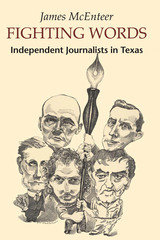 Fighting Words: Independent Journalists in Texas
By James McEnteer
University of Texas Press, 1992 Fighting Words profiles five journalists who published the truth as they saw it, no matter how their reporting angered politicians, social and religious leaders, or other journalists. The five journalists are William Brann (1855–1898), Don Biggers (1868–1957), John Granbery (1874–1953), Archer Fullingim (1902–1984), and Stoney Burns [Brent Stein] (1942–2011). Though they lived in different eras, all these men dealt with issues that society continues to face—racism, official corruption, religious freedom, educational reform, political extremism of the left and right, the clash of urban and rural values, and the fear of change. Their lives and work constitute a unique, alternative perspective on Texas history and the history of journalism itself. In addition to the troubling questions they raised on social issues, these independent journalists challenge us, as they challenged the mainline media of their own times, to define the function of journalism and to examine the mandate of the First Amendment. We may doubt the wisdom of some of their convictions, but not the courage they needed to express them in the face of ridicule, hostility, intimidation, and even death. More than the specific causes they fought for, the independents’ passion for truth and their absolute belief in free speech constitute their greatest legacy to us and to journalism.
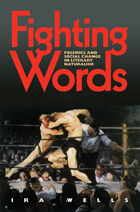 Fighting Words: Polemics and Social Change in Literary Naturalism
Ira Wells
University of Alabama Press, 2013 An entirely new understanding of what literary naturalism is and why it matters Ira Wells, countering the standard narrative of literary naturalism’s much-touted concern with environmental and philosophical determinism, draws attention to the polemical essence of the genre and demonstrates how literary naturalists engaged instead with explosive political and cultural issues that remain fervently debated today. Naturalist writers, Wells argues in Fighting Words, are united less by a coherent philosophy than by an attitude, a posture of aggressive controversy, which happens to cluster loosely around particular social issues. To an extent not yet appreciated, literary naturalists took controversial—and frequently contrarian—positions on a wide range of literary, political, and social issues. Frank Norris, for instance, famously declared the innate inferiority of female novelists and frequently wrote about literature in tones suggestive of racial warfare. Theodore Dreiser once advocated, with deadly earnestness, a program of state-run infanticide for disabled or unwanted children. Richard Wright praised the Stalin-Hitler agreement of 1939 as “a great step toward peace.” While many of their arguments were irascible, attention-seeking, and self-consciously inflammatory, the combative spirit that fueled these outbursts remains central to the canonical texts of the movement. Wells considers Frank Norris’s The Octopus in light of the emerging discourses of environmentalism and ecological despoliation, and examines the issue of abortion in Theodore Dreiser’s An American Tragedy. A chapter on Richard Wright’s Native Son takes issue with traditional humanistic readings of its protagonist by analyzing the disturbing relationship between terrorism and lynching as a crime and punishment that resists formal incorporation into the law. By highlighting the contentious rhetoric that infuses the canonical texts of literary naturalism, Fighting Words opens up a wide-ranging and interdisciplinary interrogation of racial, sexual, and environmental polemics in American culture.
Fights, Games, and Debates
Anatol Rapoport
University of Michigan Press, 1974 A scientifically grounded method by which we can understand human conflict in all its forms
Figler: My Imaginary Friend
Erica Taylor
Parkhurst Brothers, Inc., 2014 Accolades to Erica Taylor for Figler: My Imaginary Friend. Taylor takes her readers on a journey of self-realization as a child comes to ultimately discover that the wonderful abilities possessed by Figler, the beloved imaginary friend, are talents (he/she) also possesses. The whimsical illustrations draw readers into the main character’s journey of self-discovery. This book offers a delightful poetic read inspiring young readers to dare to imagine and reach for the impossible.
Jeanine Wood - Distance Learning Coordinator Northeast Arkansas Education Cooperative Walnut Ridge, Arkansas
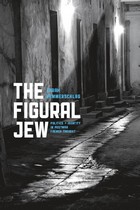 The Figural Jew: Politics and Identity in Postwar French Thought
Sarah Hammerschlag
University of Chicago Press, 2010 The rootless Jew, wandering disconnected from history, homeland, and nature, was often the target of early twentieth-century nationalist rhetoric aimed against modern culture. But following World War II, a number of prominent French philosophers recast this maligned figure in positive terms, and in so doing transformed postwar conceptions of politics and identity. Sarah Hammerschlag explores this figure of the Jew from its prewar usage to its resuscitation by Jean-Paul Sartre, Emmanuel Levinas, Maurice Blanchot, and Jacques Derrida. Sartre and Levinas idealized the Jew’s rootlessness in order to rethink the foundations of political identity. Blanchot and Derrida, in turn, used the figure of the Jew to call into question the very nature of group identification. By chronicling this evolution in thinking, Hammerschlag ultimately reveals how the figural Jew can function as a critical mechanism that exposes the political dangers of mythic allegiance, whether couched in universalizing or particularizing terms. Both an intellectual history and a philosophical argument, The Figural Jew will set the agenda for all further consideration of Jewish identity, modern Jewish thought, and continental philosophy.
 Figuration Never Died: New York Painterly Painting, 1950–1970
Karen Wilkin
The Artist Book Foundation, 2020 By about 1950, forward-looking New York painting was seen as synonymous with abstraction, especially charged, gestural Abstract Expressionism. But there was also a strong group of dissenters: artists, all born in the 1920s and many of them students of Hans Hofmann, who never lost their enthusiasm for recognizable imagery, without rejecting Abstract Expressionism’s love of malleable oil paint. Although most of them began as abstract artists, they all evolved into painters working from observation, using a fluid, urgent touch to translate their perceptions into eloquent, highly individualized visual languages, almost always informed by the hand; that is, unlike the Color Field and Minimalist artists, these artists remained, for the most part, “painterly” painters. In light of their important contributions to twentieth-century American art, The Artist Book Foundation presents the catalogue for the Brattleboro Museum & Art Center's eponymous 2020 exhibition, Figuration Never Died: New York Painterly Painting, 1950–1970.
These rebellious artists include Lois Dodd, Jane Freilicher, Paul Georges, Grace Hartigan, Wolf Kahn, Alex Katz, Albert Kresch, Robert de Niro Sr., Paul Resika, and Anne Tabachnick. The compelling figurative work they made between about 1950 and 1970, in contrast to the prevailing Abstract Expressionism of the time, constitutes a significant chapter in the history of recent American Modernism. Their work not only greatly expands our conception of the story of New York painting, but it also presages and contextualizes today’s multiplicity of artistic concepts and processes. Given both the aesthetic diversity of today’s New York art world and the dependence of many younger artists on digital media or the appearance of digital media, it seems an appropriate moment to reconsider the work of these daring pioneers, as both precursor and opposition to current norms. It is especially important to do this now, while some of these artists are still alive.
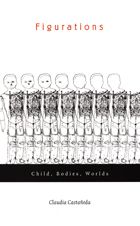 Figurations: Child, Bodies, Worlds
Claudia Castañeda
Duke University Press, 2002 Always in the process of becoming, inherently incomplete, the child is a remarkably malleable figure. In Figurations, Claudia Castañeda shows how this malleability is itself generated—how the child is "made" by different constituencies and how the resulting historically, geographically, and culturally specific figures are put to widely divergent uses, often to very powerful effect. Situated at the intersection of feminist, postcolonial, cultural, and science and technology studies, this book provides a remarkable map of the child's meaning and movement across transnational circuits of exchange.
Castañeda investigates the construction of the child as both a natural and cultural body, the character of its embodiment, and its imaginative appeal in various settings. The sites through which she tracks the bodily production and deployment of the child include nineteenth-century developmental science; cognitive neuroscience in the late twentieth century; international adoption; rumors and media coverage of child-organ stealing; and poststructuralist theory. Her work reveals the extent to which the child's cultural significance and value lie in its status as a body whose incompleteness makes it "available" for such varied uses. Figurations establishes the child as a key figure for understanding and rethinking the politics of nature, culture, bodies, and subjects in changing "global" worlds.
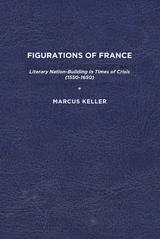 Figurations of France: Literary Nation-Building in Times of Crisis (1550-1650)
Marcus Keller
University of Delaware Press, 2011 In Figurations of France: Literary Nation-Building in Times of Crisis (1550-1650), Marcus Keller explores the often indirect and subtle ways in which key texts of early modern French literature, from Joachim Du Bellay’s Défense et illustration de la langue française to Corneille’s Le Cid, contribute to the fiction of France as a nation. Through his fresh take on these and other classics, he shows that they not only create the French as an imaginary community but also provide venues for an incisive critique of the political and cultural construct that underpins the modern nation-state. Current theories of nationhood, in particular the concepts of the nation form and fictive ethnicity (Étienne Balibar), inform the close readings of Du Bellay’s Défense, Ronsard’s Discours, d’Aubigné’s Tragiques, Montaigne’s Essays, Malherbe’s odes, and Corneille’s Le Cid and Horace. They reveal the imaginary power and unifying force of early modern figurations of France that come to bear in this heteregoneous corpus of French literature, with texts ranging from manifesto and epic poem to essay and tragedy. Situating each author and text in their particular historical context, the study suggests that the literary invention of France in the sixteenth and seventeenth centuries is as abundant as it is conceptually innovative: Du Bellay, for example, develops an idea of France by portraying the French language as a pruned and grafted tree while d’Aubigné proposes to think of the French as a nuclear but fatherless family. Blood functions as a highly charged metaphor of nationhood in all texts. Opening up new perspectives on these canonical works, the focus on literary nation-building also puts them into unexpected and thought-provoking relationships to each other. Figurations of France deliberately crosses the fictive boundary between the sixteenth and the seventeenth centuries and argues that, in terms of imaginary nation-building, the contours that delineate the early modern period and separate it from what we call the modern era quickly begin to dissolve. Ultimately, the book makes the case for early modern literature as a creative and critical discourse, able to nourish and nuance our thinking about the nation as the postmodern nation-state is increasingly called into question by the economical, political, and cultural effects of globalization. Published by University of Delaware Press. Distributed worldwide by Rutgers University Press.
Figurations of Modernity: Global and Local Representations in Comparative Perspective
Edited by Vincent Houben and Mona Schrempf
Campus Verlag, 2008
Conventional wisdom holds that globalization has made the world more modern, not less. But how has modernity been conceived of in colonial, postcolonial, and post-revolutionary worlds? In Figurations of Modernity, an international team of scholars probe how non-European worlds have become modern ones, from the perspective of a broad range of societies around the globe.
From vocational education in Argentina to secular morality in Tibet, from the construction of heroes in Central Asia to historical memory in Nigeria, this comprehensive volume reckons with the legacy of empire in a globalizing world. Enhanced by the perspectives of historians, anthropologists, and scholars of comparative education, Figurations of Modernity will be an essential book for those studying post-colonial nations across disciplines.
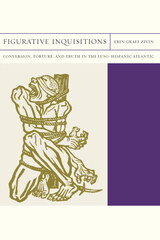 Figurative Inquisitions: Conversion, Torture, and Truth in the Luso-Hispanic Atlantic
Erin Graff Zivin
Northwestern University Press, 2014 Winner, 2015 LAJSA Best Book in Latin American Jewish Studies
The practices of interrogation, torture, and confession have resurfaced in public debates since the early 2000s following human rights abuses around the globe. Yet discussion of torture has remained restricted to three principal fields: the legal, the pragmatic, and the moral, eclipsing the less immediate but vital question of what torture does.Figurative Inquisitions seeks to correct this lacuna by approaching the question of torture from a literary vantage point. This book investigates the uncanny presence of the Inquisition and marranismo (crypto-Judaism) in modern literature, theater, and film from Mexico, Brazil, and Portugal. Through a critique of fictional scenes of interrogation, it underscores the vital role of the literary in deconstructing the relation between torture and truth. Figurative Inquisitions traces the contours of a relationship among aesthetics, ethics, and politics in an account of the "Inquisitional logic" that continues to haunt contemporary political forms. In so doing, the book offers a unique humanistic perspective on current torture debates.
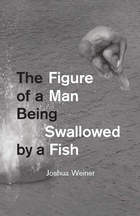 The Figure of a Man Being Swallowed by a Fish
Joshua Weiner
University of Chicago Press, 2013 At the heart of Joshua Weiner’s new book is an extended poem with a bold political dimension and great intellectual ambition. It fuses the poet’s point of view with Walt Whitman’s to narrate a decentered time-traveling collage about Rock Creek, a tributary of the Potomac that runs through Washington, DC. For Weiner, Rock Creek is the location of myriad kinds of movement, streaming, and joining: personal enterprise and financial capital; national politics, murder, sex, and homelessness; the Civil War and collective history; music, spiritual awakening, personal memory, and pastoral vision. The questions that arise from the opening foundational poem inform the others in the collection, which range widely from the dramatic arrival of an uncanny charismatic totem that titles the volume to intimate reflections on family, illness, and dream visions. The virtues of Weiner’s earlier books—discursive intelligence, formal control, an eccentric and intriguing ear, and a wide-ranging curiosity matched to variety of feeling—are all present here. But in The Figure of a Man Being Swallowed by a Fish, Weiner has discovered a new poetic idiom, one that is stripped down, rhythmically jagged, and comprehensively philosophical about human limits.
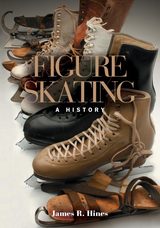 Figure Skating: A HIstory
James R. Hines
University of Illinois Press, 2005 The only comprehensive history of figure skating in over forty years Figure skating, unique in its sublimely beautiful combination of technical precision, musicality, and interpretive elements, has undergone many dramatic developments since the only previous history of the sport was published in 1959. This exciting and information-packed new history by James R. Hines explains skating’s many technical and artistic advances, its important figures, its intrigues and scandals, and the historical high points during its long evolution. Hines divides his history into three periods separated by the World Wars. In the first section, he follows functional and recreational ice skating through its evolution into national schools, culminating in the establishment of the International Skating Union and the ascendancy of an international style of skating. The second section explains the changes that occurred as the sport expanded into the form we recognize and enjoy today, and the final section shows how skating became increasingly athletic, imaginative, and intense following World War II, as the main focus turns to skaters themselves. The profiles include some 148 World and Olympic Champions as well as others who, in Dick Button’s words, "left the sport better because they were in it." Beginning with mythological tales from twelfth- and thirteenth-century Scandinavians, Hines describes hundreds who have contributed to the sport. They include figure skating’s patron saint Lydwina of Schiedam, whose late-fourteenth-century skating tumble has been documented in a woodcut; Ulrich Salchow and Axel Paulsen, who gave their names to distinctive jumps; Madge Syers, who entered and medaled at the previously all-male World Championships in 1902; and Sonja Henie, who took skating to the silver screen. The history ends with the 2002 skating season, when Maria Butyrskaya and Michelle Kwan commanded the most attention and an unfortunate judging decision rocked the pairs’ competition, resulting in the adoption of a new judging system. Beyond the contributions of individual skaters, Figure Skating also traces the growth of competitions and show skating (professional and amateur), and discussions of relevant social, political, and ethical concerns that have affected the sport. Along with over seventy magnificent historical pictures spread throughout the book, a very special gallery features the picture of every world and Olympic champion. Figure Skating is an informative and inspiring resource, sure to be enjoyed by anyone who has ever skated recreationally or in competition as well as by the many fans who have this beautiful sport as spectators.
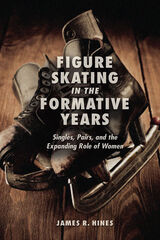 Figure Skating in the Formative Years: Singles, Pairs, and the Expanding Role of Women
James R. Hines
University of Illinois Press, 2015 Once a winter pastime for socializing and courtship, skating evolved into the wildly popular competitive sport of figure skating, one of the few athletic arenas where female athletes hold a public profile--and earning power--equal to that of men.
Renowned sports historian James R. Hines chronicles figure skating's rise from its earliest days through its head-turning debut at the 1908 Olympics and its breakthrough as entertainment in the 1930s. Hines credits figure skating's explosive expansion to an ever-increasing number of women who had become proficient skaters and wanted to compete, not just in singles but with partners as well.
Matters reached a turning point when British skater Madge Syers entered the otherwise-male 1902 World Championship held in London and finished second. Called skating's first feminist, Syers led a wave of women who made significant contributions to figure skating and helped turn it into today's star-making showcase at every Winter Olympics.
Packed with stories and hard-to-find details, Figure Skating in the Formative Years tells the early history of a sport loved and followed by fans around the world.
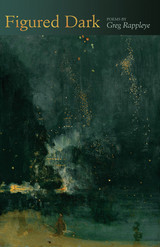 Figured Dark: Poems
Greg Rappleye
University of Arkansas Press, 2007 Greg Rappleye’s Figured Dark is a collection of contemporary lyric and narrative poems, set in an American landscape, which takes as its implicit theme the journey of the soul from darkness into light. The voices in the collection call across a vast landscape of myth, memory, and horrific wreckage. In the title poem, speaking of the phenomenon of fireflies rising at night from a southern field, he writes, “I could read this down to a million tiny bodies, / blazing the midnight trees,” but the reader is left to wonder whether any extravagant numbering can account for the massed starlings, dreamy raptors, dome-lighted Firebirds, flaming bodies, junk cars, and deadly archangels that come to ground in Rappleye’s world, where the spiritual exhaustion of Odysseus is visited upon Brian Wilson, and the young John Berryman seeks recompense from a wily family in northern Michigan. These poems are by turns wise, elegiac, ironic, and wickedly funny. This is a poet who refuses easy categories. If these poems are anything, they are affidavits of a heart at work, building out of darkness a kind of wild redemption, hard-earned in the real world. Figured Dark is part of the University of Arkansas’s Poetry Series, edited by Enid Shomer.
Figures in a Landscape
Gail Mazur
University of Chicago Press, 2011 A new inclusiveness, a heady freedom, grounded in the facts of mortality, inform Gail Mazur’s recent poems, as if making them has served as both a bunker and a promontory, a way to survive, and to be exposed to, the profound underlying subject of this book: a husband’s approaching death. The intimate particulars of a shared life are seen from a great height—and then there’s the underlife of the bunker: endurance, holding on, life as uncompromising reality. This new work, possessed by the unique devil-may-care intensity of someone writing at the end of her nerves, makes Figures in a Landscape feel radiant, visionary, and exhilarating, rather than elegiac. Mazur’s masterly fusion of abstraction with the facts of a life creates a coming to terms with what Yeats called “the aboriginal ice.”
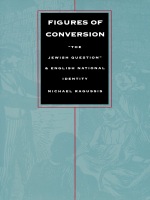 Figures of Conversion: “The Jewish Question” and English National Identity
Michael Ragussis
Duke University Press, 1995 "I knew a Man, who having nothing but a summary Notion of Religion himself, and being wicked and profligate to the last Degree in his Life, made a thorough Reformation in himself, by labouring to convert a Jew." —Daniel Defoe, The Farther Adventures of Robinson Crusoe (1719) When the hero of Defoe’s novel listens skeptically to this anecdote related by a French Roman Catholic priest, he little suspects that in less than a century the conversion of the Jews would become nothing short of a national project—not in France but in England. In this book, Michael Ragussis explores the phenomenon of Jewish conversion—the subject of popular enthusiasm, public scandal, national debate, and dubbed "the English madness" by its critics—in Protestant England from the 1790s through the 1870s.
Moving beyond the familiar catalog of anti-Semitic stereotypes, Ragussis analyzes the rhetoric of conversion as it was reinvented by the English in sermons, stories for the young, histories of the Jews, memoirs by Jewish converts, and popular novels. Alongside these texts and the countertexts produced by English Jews, he situates such writers as Edgeworth, Scott, Disraeli, Arnold, Trollope, and Eliot within the debate over conversion and related issues of race, gender, and nation-formation. His work reveals how a powerful group of emergent cultural projects—including a revisionist tradition of the novel, the new science of ethnology, and the rewriting of European history—redefined English national identity in response to the ideology of conversion, the history of the Jews, and "the Jewish question."
Figures of Conversion offers an entirely new way of regarding Jewish identity in nineteenth-century British culture and will be of importance not only to literary scholars but also to scholars of Judaic and religious studies, history, and cultural studies.
 Figures of Ill Repute: Representing Prostitution in Nineteenth Century France
Charles Bernheimer
Harvard University Press, 1989 Ubiquitous in the streets and brothels of nineteenth-century Paris, the prostitute was even more so in the novels and paintings of the time. Charles Bernheimer discusses how these representations of the sexually available woman express male ambivalence about desire, money, class, and the body. Interweaving close textual readings with historical anecdote and theoretical speculation, Bernheimer demonstrates how the formal properties of art can serve strategically to control anxious fantasies about female sexual power.
Bernheimer looks first at the supposed objectivity of the official discourse on prostitution, where he pinpoints revealing strategies for legitimizing private fantasies and linking female sexuality to pathology and disease. He then traces the development of modernist artistic techniques as a response to the increasing virulence of these fantasies of organic decay. The objects of Bernheimer's analyses range from works scandalous in their time, such as Maner's Olympia and Zola's Nana, to great popular successes, such as Sue's Mysteries of Paris, to "in" books praised by connoisseurs, such as Haubert's Sentimental Education and Huysmans's Against Nature, to works made for private enjoyment, such as Degas's brothel images. Intriguing and highly readable, these analyses offer new insights into the ideological function of art in structuring attitudes toward sex, gender, and power.
Figures of Ill Repute: Representing Prostitution in Nineteenth-Century France
Charles Bernheimer
Duke University Press Ubiquitous in the streets and brothels of nineteenth-century Paris, the prostitute was even more so in the novels and paintings of the time. Charles Bernheimer discusses how these representations of the sexually available woman express male ambivalence about desire, money, class, and the body. Interweaving close textual analysis with historical anecdote and theoretical speculation, Bernheimer demonstrates how the formal properties of art can serve strategically to control anxious fantasies about female sexual power. Drawing on methods derived from cultural studies, psychoanalysis, social history, feminist theory, and narrative analysis, this interdisciplinary classic (available now for the first time in paperback) was awarded Honorable Mention in 1990 for the James Russell Lowell prize awarded by the Modern Language Association for the best book of criticism.
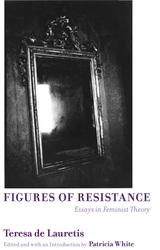 Figures of Resistance: Essays in Feminist Theory
Teresa de Lauretis. Edited and with an Introduction by Patricia White
University of Illinois Press, 2006 The changing face of feminist discourse as reflected by the career of one of its preeminent scholars Figures of Resistance brings together the unpublished lectures and little-seen essays of internationally renowned theorist Teresa de Lauretis, spanning over twenty years of her finest work. Thirty years after the height of feminist theory, this collection invites us to reflect on the history of feminism and take a hard look at where it stands today. Selected essays include "Sexual Indifference and Lesbian Representation," "The Lure of the Mannish Lesbian," "Eccentric Subjects," "Habit Changes," "The Intractability of Desire," and the unpublished article "Figures of Resistance." An introduction from feminist film scholar Patricia White provides an overview of the development of de Lauretis's thought and of feminist theory over past decades.
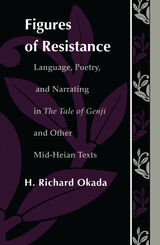 Figures of Resistance: Language, Poetry, and Narrating in The Tale of the Genji and Other Mid-Heian Texts
H. Richard Okada
Duke University Press, 1991 In this revisionist study of texts from the mid-Heian period in Japan, H. Richard Okada offers new readings of three well-known tales: The Tale of the Bamboo-cutter, The Tale of Ise, and The Tale of Genji. Okada contends that the cultural and gendered significance of these works has been distorted by previous commentaries and translations belonging to the larger patriarchal and colonialist discourse of Western civilization. He goes on to suggest that this universalist discourse, which silences the feminine aspects of these texts and subsumes their writing in misapplied Western canonical literary terms, is sanctioned and maintained by the discipline of Japanese literature.
Okada develops a highly original and sophisticated reading strategy that demonstrates how readers might understand texts belonging to a different time and place without being complicit in their assimilation to categories derived from Western literary traditions. The author’s reading stratgey is based on the texts’ own resistance to modes of analysis that employ such Western canonical terms as novel, lyric, and third-person narrative. Emphasis is also given to the distinctive cultural circles, as well as socio-political and genealogical circumstances that surrounded the emergence of the texts.
Indispensable readings for specialists in literature, cultural studies, and Japanese literature and history, Figures of Resistance will also appeal to general readers interested in the problems and complexities of studying another culture.
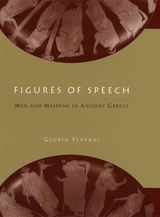 Figures of Speech: Men and Maidens in Ancient Greece
Gloria Ferrari
University of Chicago Press, 2002 Over the past two hundred years, thousands of ancient Greek vases have been unearthed. Yet these artifacts remain a challenge: what did the images depicted on these vases actually mean to ancient Greek viewers? In this long-awaited book, Gloria Ferrari uses Athenian vases, literary evidence, and other works of art from the Archaic and Classical periods (520-400 B.C.) to investigate what these items can tell us about the ancient Greeks—specifically, their notions of gender.
Ferrari begins by developing a theoretical perspective on visual representation, arguing that artistic images give us access to how their subjects were imagined rather than to the way they really were. For instance, Ferrari's examinations of the many representations of women working wool reveal that these images constitute powerful metaphors—metaphors, she argues, which both reflect and construct Greek conceptions of the ideal woman and her ideal behavior.
From this perspective, Ferrari studies a number of icons representing blameless femininity and ideal masculinity to reevaluate the rites of passage by which girls are made ready for marriage and boys become men. Representations of the nude male body in Archaic statues known as kouroi, for example, symbolize manhood itself and shed new light on the much-discussed institution of paiderastia. And, in Ferrari's hands, imagery equating maidens with arable land and buried treasure provides a fresh view of Greek ideas of matrimony.
Innovative, thought-provoking, and insightful throughout, Figures of Speech is a powerful demonstration of how the study of visual images as well as texts can reshape our understanding of ancient Greek culture.
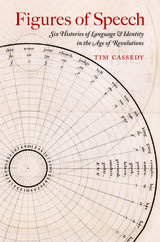 Figures of Speech: Six Histories of Language and Identity in the Age of Revolutions
Tim Cassedy
University of Iowa Press, 2018 Tim Cassedy’s fascinating study examines the role that language played at the turn of the nineteenth century as a marker of one’s identity. During this time of revolution (U.S., French, and Haitian) and globalization, language served as a way to categorize people within a world that appeared more diverse than ever. Linguistic differences, especially among English-speakers, seemed to validate the emerging national, racial, local, and regional identity categories that took shape in this new world order. Focusing on six eccentric characters of the time—from the woman known as “Princess Caraboo” to wordsmith Noah Webster—Cassedy shows how each put language at the center of their identities and lived out the possibilities of their era’s linguistic ideas. The result is a highly entertaining and equally informative look at how perceptions about who spoke what language—and how they spoke it—determined the shape of communities in the British American colonies and beyond. This engagingly written story is sure to appeal to historians of literature, culture, and communication; to linguists and book historians; and to general readers interested in how ideas about English developed in the early United States and throughout the English-speaking world.
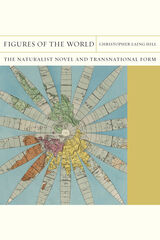 Figures of the World: The Naturalist Novel and Transnational Form
Christopher Laing Hill
Northwestern University Press, 2020 Figures of the World: The Naturalist Novel and Transnational Form overturns Eurocentric genealogies and globalizing generalizations about “world literature” by examining the complex, contradictory history of naturalist fiction. Christopher Laing Hill follows naturalism’s emergence in France and circulation around the world from North and South America to East Asia. His analysis shows that transnational literary studies must operate on multiple scales, combine distant reading with close analysis, and investigate how literary forms develop on the move.
The book begins by tracing the history of naturalist fiction from the 1860s into the twentieth century and the reasons it spread around the world. Hill explores the development of three naturalist figures—the degenerate body, the self-liberated woman, and the social milieu—through close readings of fiction from France, Japan, and the United States. Rather than genealogies of European influence or the domination of cultural “peripheries” by the center, novels by Émile Zola, Tayama Katai, Frank Norris, and other writers reveal conspicuous departures from metropolitan models as writers revised naturalist methods to address new social conditions. Hill offers a new approach to studying culture on a large scale for readers interested in literature, the arts, and the history of ideas.
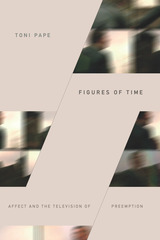 Figures of Time: Affect and the Television of Preemption
Toni Pape
Duke University Press, 2019 Many contemporary television series from Modern Family to How to Get Away with Murder open an episode or season with a conflict and then go back in time to show how that conflict came to be. In Figures of Time Toni Pape examines these narratives, showing how these leaps in time create aesthetic experiences of time that attune their audiences to the political doctrine of preemption—a logic that justifies preemptive action to nullify a perceived future threat. Examining questions of temporality in Life on Mars, the political ramifications of living under the auspices of a catastrophic future in FlashForward, and how Damages disrupts the logic of preemption, Pape shows how television helps shift political culture away from a model of rational deliberation and representation toward a politics of preemption and conformity. Exposing the mechanisms through which television supports a fear-based politics, Pape contends, will allow for the rechanneling of television's affective force into building a more productive and positive politics.
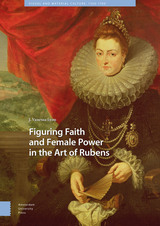 Figuring Faith and Female Power in the Art of Rubens
J. Vanessa Lyon
Amsterdam University Press, 2020 Figuring Faith and Female Power in the Art of Rubens argues that the Baroque painter, propagandist, and diplomat, Peter Paul Rubens, was not only aware of rapidly shifting religious and cultural attitudes toward women, but actively engaged in shaping them. Today, Rubens’s paintings continue to be used -- and abused -- to prescribe and proscribe certain forms of femininity. Repositioning some of the artist’s best-known works within seventeenth-century Catholic theology and female court culture, this book provides a feminist corrective to a body of art historical scholarship in which studies of gender and religion are often mutually exclusive. Moving chronologically through Rubens’s lengthy career, the author shows that, in relation to the powerful women in his life, Rubens figured the female form as a transhistorical carrier of meaning whose devotional and rhetorical efficacy was heightened rather than diminished by notions of female difference and particularity.
Figuring Jasper Johns
Fred Orton
Harvard University Press, 1994 Few contemporary artists have made the problem of meaning for both artist and viewer as interesting and challenging as has Jasper Johns. Figuring Jasper Johns is a carefully and convincingly argued illumination of the ideas and selected works of this enigmatic American painter. Focusing on three of Johns's key paintings, Flag (1954-55), Painted Bronze (1960), and Untitled (1972), Fred Orton adroitly combines formal theoretical analyses and historical reflection. He opens up the painter's canvasses to fresh interpretation, with appropriate emphasis on the power of allegory in Jasper Johns's work.
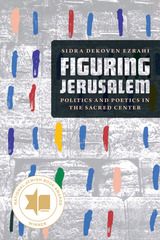 Figuring Jerusalem: Politics and Poetics in the Sacred Center
Sidra DeKoven Ezrahi
University of Chicago Press, 2022 Figuring Jerusalem explores how Hebrew writers have imagined Jerusalem, both from the distance of exile and from within its sacred walls.
For two thousand years, Hebrew writers used their exile from the Holy Land as a license for invention. The question at the heart of Figuring Jerusalem is this: how did these writers bring their imagination “home” in the Zionist century? Sidra DeKoven Ezrahi finds that the same diasporic conventions that Hebrew writers practiced in exile were maintained throughout the first half of the twentieth century. And even after 1948, when the state of Israel was founded but East Jerusalem and its holy sites remained under Arab control, Jerusalem continued to figure in the Hebrew imagination as mediated space. It was only in the aftermath of the Six Day War that the temptations and dilemmas of proximity to the sacred would become acute in every area of Hebrew politics and culture.
Figuring Jerusalem ranges from classical texts, biblical and medieval, to the post-1967 writings of S. Y. Agnon and Yehuda Amichai. Ultimately, DeKoven Ezrahi shows that the wisdom Jews acquired through two thousand years of exile, as inscribed in their literary imagination, must be rediscovered if the diverse inhabitants of Jerusalem are to coexist.
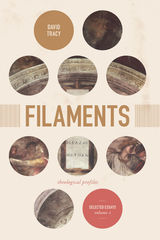 Filaments: Theological Profiles: Selected Essays, Volume 2
David Tracy
University of Chicago Press, 2020 In the second volume of his two-volume collection of essays from the 1980s to 2018, renowned Catholic theologian David Tracy gathers profiles of significant theologians, philosophers, and religious thinkers. These essays, he suggests, can be thought of in terms of Walt Whitman’s “filaments,” which are thrown out from the speaking self to others—ancient, medieval, modern, and contemporary—in order to be caught elsewhere.
Filaments arranges its subjects in rough chronological order, from choices in ancient theology, such as Augustine, through the likes of William of St. Thierry in the medieval period and Martin Luther and Michelangelo in the early modern, and, finally, to modern and contemporary thinkers, including Bernard Lonergan, Paul Tillich, Simone Weil, Karl Rahner, Reinhold Niebuhr, and Iris Murdoch. Taken together, these essays can be understood as a partial initiation into a history of Christian theology defined by Tracy’s key virtues of plurality and ambiguity. Marked by surprising insights and connections, Filaments brings the work of one of North America’s most important religious thinkers once again to the forefront to be celebrated by longtime and new readers alike.
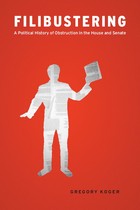 Filibustering: A Political History of Obstruction in the House and Senate
Gregory Koger
University of Chicago Press, 2010 In the modern Congress, one of the highest hurdles for major bills or nominations is gaining the sixty votes necessary to shut off a filibuster in the Senate. But this wasn’t always the case. Both citizens and scholars tend to think of the legislative process as a game played by the rules in which votes are the critical commodity—the side that has the most votes wins. In this comprehensive volume,Gregory Koger shows, on the contrary, that filibustering is a game with slippery rules in which legislators who think fast and try hard can triumph over superior numbers. Filibustering explains how and why obstruction has been institutionalized in the U.S. Senate over the last fifty years, and how this transformation affects politics and policymaking. Koger also traces the lively history of filibustering in the U.S. House during the nineteenth century and measures the effects of filibustering—bills killed, compromises struck, and new issues raised by obstruction. Unparalleled in the depth of its theory and its combination of historical and political analysis, Filibustering will be the definitive study of its subject for years to come.
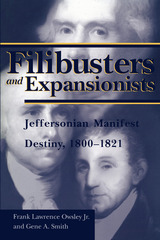 Filibusters and Expansionists: Jeffersonian Manifest Destiny, 1800-1821
Frank L. Owsley Jr.
University of Alabama Press, 2004 Demonstrates the passionate interest the Jeffersonian presidents had in wresting land from less powerful foes and expanding Jefferson’s “empire of liberty”
The first two decades of the 19th century found many Americans eager to move away from the crowded eastern seaboard and into new areas where their goals of landownership might be realized. Such movement was encouraged by Presidents Jefferson, Madison, and Monroe—collectively known as the Jeffersonians—who believed that the country's destiny was to have total control over the entire North American continent. Migration patterns during this time changed the country considerably and included the roots of the slavery controversy that ultimately led to the Civil War. By the end of the period, although expansionists had not succeeded in moving into British Canada, they had obtained command of large areas from the Spanish South and Southwest, including acreage previously controlled by Native Americans.
Utilizing memoirs, diaries, biographies, newspapers, and vast amounts of both foreign and domestic correspondence, Frank Lawrence Owsley Jr. and Gene A. Smith reveal an insider’s view of the filibusters and expansionists, the colorful—if not sometimes nefarious—characters on the front line of the United States’s land grab. Owsley and Smith describe in detail the actions and characters involving both the successful and the unsuccessful efforts to expand the United States during this period—as well as the outspoken opposition to expansion, found primarily among the Federalists in the Northeast.
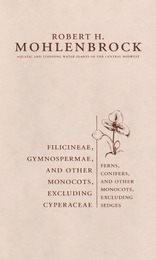 Filicineae, Gymnospermae and Other Monocots Excluding Cyperaceae: Ferns, Conifers, and Other Monocots Excluding Sedges
Robert H. Mohlenbrock
Southern Illinois University Press, 2006 The second in a series of four illustrated guides to identifying aquatic and standing water plants in the central Midwest, this convenient reference volume includes descriptions, nomenclature, ecological information, and identification keys to plants in all of the monocot families except sedges—which are covered in the first volume in the series—that are found in Kentucky (except for the Cumberland region), Ohio, Indiana, Illinois, Iowa, Missouri, Kansas, and Nebraska. Monocots covered in this volume include ferns, conifers, grasses, rushes, orchids, duckweeds, irises, sweet flags, arrowheads, aroids, flowering rushes, pipeworts, frog-bits, arrowgrasses, naiads, pickerelweeds, pondweeds, bur reeds, cattails, and yellow-eyed grasses. Robert H. Mohlenbrock includes three types of plants: submergents, those that spend their entire lives with their vegetative parts either completely submerged or at least floating on the water’s surface; emergents, which are typically rooted underwater with their vegetative parts standing out of water; and a third category of plants that live most of their lives out of water, but which may live in water at least three months a year. With taxa arranged alphabetically, the volume is well organized and easy to use. In addition, basic synonymy, description, distribution, comments, and line drawings show the habits and distinguishing features for each plant. Habitat and nomenclatural notes are also listed, as are the official wetland designations given by the U.S. Fish and Wildlife Service. Filicineae, Gymnospermae, and Other Monocots, Excluding Cyperaceae is a useful standard reference for state and federal employees who deal with both aquatic and wetland plants and environmental conservation and mitigation issues. It is furthermore an essential guide for students and instructors in college and university courses focusing on the identification of aquatic and wetland plants.
Filigrana encendida / Filigree of Light: Poemas / Poems
Olivia Maciel
Swan Isle Press, 2002 In Olivia Maciel's Filigree of Light, one enters a lyric of solitude and light, water and wind. Maciel is a poet who has the power to reveal and surprise, bringing one close to things. She approaches the unknown, searching with riddles and reverie.
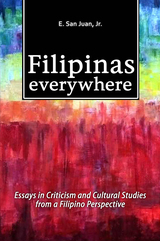 Filipinas Everywhere: Essays in Criticism and Cultural Studies from a Filipino Perspective
E. San Juan
Sussex Academic Press, 2022 E. San Juan is remarkable for his commitment to literature and culture as vital areas of contemporary social life.????????--Prof. Fredric Jameson, Duke University ***E. San Juan is one of the worlds most distinguished progressive critics. He is undoubtedly the leading authority on Filipino-American literary relations.--Prof. H. Bruce Franklin, Rutgers University *** In this epoch of disastrous neoliberal globalization, E. San Juans critique seizes the crisis in neocolonial Philippines as a point of intervention. As current Philippine President Dutertes timely war on drugs and corruption rages, E. San Juan highlights the facticity that Filipinos are once more confronted with the barbaric legacy of U.S. domination, legitimized today as civilizing humanitarianism. This wide-ranging discourse by a Filipino radical scholar interrogates the apologetic use of postcolonial dogmas, Saussurean semiology versus Peircean semiotics, Kafkas allegory on torture, Edward Saids use of Gramsci, and the postconceptual view of photography. Overall, the author seeks to deploy a historical-materialist perspective in elucidating the dialectical interplay of contradictory forces symbolized in art and diverse cultural texts. In the process, he delineates the contexts of events with the end view of generating revolutionary transformations in the Asian-Pacific islands marked by the prevalence of U.S. imperial hegemony in the global system. (Series: Critical Voices) [Subject: Politics, Literature, Media Studies, Cultural Studies, Sociology, Post-Colonialism]
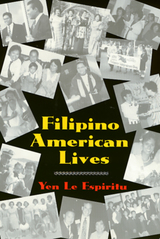 Filipino American Lives
Yen Le Espiritu
Temple University Press, 1995 Filipino Americans are now the second largest group of Asian Americans as well as the second largest immigrant group in the United States. As reflected in this collection, their lives represent the diversity of the immigrant experience and their narratives are a way to understand ethnic identity and Filipino American history. Men and women, old and young, middle and working class, first and second generation, all openly discuss their changing sense of identity, the effects of generational and cultural differences on their families, and the role of community involvement in their lives. Pre- and post-1965 immigrants share their experiences, from the working students who came before WWII, to the manongs in the field, to the stewards and officers in the U.S. Navy, to the "brain drain" professionals, to the Filipinos born and raised in the United States. As Yen Le Espiritu writes in the Introduction, "each of the narratives reveals ways in which Filipino American identity has been and continues to be shaped by a colonial history and a white-dominated culture. It is through recognizing how profoundly race has affected their lives that Filipino Americans forge their ethnic identities—identities that challenge stereotypes and undermine practices of cultural domination." In the series Asian American History and Culture, edited by Sucheng Chan, David Palumbo-Liu, Michael Omi, K. Scott Wong, and Linda Trinh Võ.
 Filipino Care Workers in Israel: Migration, Trans-local Livelihoods and Space
Anna Lim
Amsterdam University Press, 2025 This book traces the construction of migrant space in Israel’s urban periphery with a focus on the flat that Filipino care workers co-rent for their day-off and provides insight into the migrant lives and journeys in trans-local contexts. The author selects the flat not only as the central field site for fieldwork but also as an analytical lens for grasping the various social networks and the formation of new identities. Offering a repertoire of migrants’ own narratives, she shows how the flat, as a microcosm of societal constellations of networks, provides opportunities for all sorts of new experiences. The groundbreaking ethnography contributes to migration scholarship by opening up avenues of analysis for space, community, and boundary-making in displacement and provides comprehensive insight into the dynamics of transnational labor migration. This provocative volume will be of key interest to scholars and students of migration studies, urban studies, and more broadly to anthropology and gender studies.
 Filipino Crosscurrents: Oceanographies of Seafaring, Masculinities, and Globalization
Kale Bantigue Fajardo
University of Minnesota Press, 2011 Filipino seamen currently compose approximately twenty percent of the 1.2 million international maritime transportation workers. Ninety percent of the world’s goods and commodities are transported by ship. Taken together, these statistics attest to the critical role Filipino seamen play in worldwide maritime trade. In Filipino Crosscurrents, an interdisciplinary ethnography, Kale Bantigue Fajardo examines the cultural politics of seafaring, Filipino maritime masculinities, and globalization in the Philippines and the Filipino diaspora. Drawing on fieldwork conducted on ships and in the ports of Manila and Oakland, as well as on an industrial container ship that traveled across the Pacific, Fajardo argues that Filipino seamen have become key figures through which the Philippine state and economic elites promote Filipino masculinity and neoliberal globalization. From government officials to working-class seamen and seafarers’ advocates, Fajardo’s wide-ranging analysis exposes the gaps in dominant narratives of Filipino seamen in national, regional, and global contexts. Writing in a hybrid style that weaves together ethnographic description, cultural critique, travelogue, and autobiography, Fajardo invites readers to reconsider the meanings of masculinity and manhood.
Filipino Tapestry Audio Supplement: To accompany Filipino Tapestry, Tagalog Language through Culture
Rhodalyne Gallo-Crail and Michael Hawkins
University of Wisconsin Press, 2012 This audio CD is a central component of the lessons in the textbook Filipino Tapestry, which offers an innovative approach to learning language by emphasizing the critical intersection of language and culture. Together, the book and CD provide activities and exercises that immerse beginning and intermediate students of Filipino language in a variety of authentic situations to simulate an in-country experience. The audio CD contains clear, concise, authentic dialogues of native Filipino speakers. The tracks are designed to convey actual conversations in relevant cultural contexts.
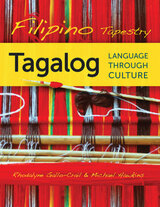 Filipino Tapestry: Tagalog Language through Culture
Rhodalyne Gallo-Crail
University of Wisconsin Press, 2012 An official language of the Philippines, Filipino is based on Tagalog, with elements of Spanish, English, and Chinese mixed in. The result is a rich, expressive language spoken in the Philippines and throughout the far-reaching Filipino diaspora.
Filipino Tapestry offers an innovative approach to learning language by emphasizing the critical intersection of language and culture. It provides activities and exercises that immerse beginning and intermediate students of Filipino in a variety of authentic situations to simulate an in-country experience. Starting with chapters on such topics as family, friends, and home, it then expands the student’s world in chapters prompting conversation about food, shopping, parties, and pastimes. Its later chapters push learners to discuss city and country life, cultural traditions, religion, history, and politics.
Features include:
• background chapters on phonology, sentence construction, and common expressions
• photos and cultural notes about chapter themes
• grammar, reading, listening, and speaking exercises
• glossaries of words and additional expressions
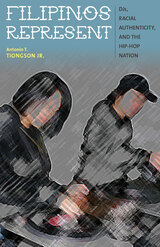 Filipinos Represent: DJs, Racial Authenticity, and the Hip-hop Nation
Antonio T. Tiongson Jr.
University of Minnesota Press, 2013 The “Hip-hop Nation” has been scouted, staked out, and settled by journalists and scholars alike. Antonio T. Tiongson Jr. steps into this well-mapped territory with questions aimed at interrogating how nation is conceptualized within the context of hip-hop. What happens, Tiongson asks, to notions of authenticity based on hip-hop’s apparent blackness when Filipino youth make hip-hop their own? Tiongson draws on interviews with Bay Area–based Filipino American DJs to explore the authenticating strategies they rely on to carve out a niche within DJ culture. He shows how Filipino American youth involvement in DJing reconfigures the normal boundaries of Filipinoness predicated on nostalgia and cultural links with an idealized homeland. Filipinos Represent makes the case that while the engagement of Filipino youth with DJ culture speaks to the broadening racial scope of hip-hop—and of what it means to be Filipino—such involvement is also problematic in that it upholds deracialized accounts of hip-hop and renders difference benign. Looking at the ways in which Filipino DJs legitimize their place in an expressive form historically associated with African Americans, Tiongson examines what these complex forms of identification reveal about the contours and trajectory of contemporary U.S. racial formations and discourses in the post–civil rights era.
 Fill 'er Up: The Glory Days of Wisconsin Gas Stations
Jim Draeger
Wisconsin Historical Society Press, 2008 Step back to the day when a visit to the gas station meant service with a smile, a wash of the windshield, and the cheerful question, "Fill 'er up?" Since their unremarkable beginnings as cheap shacks and curbside pumps at the dawn of the automobile age, gas stations have taken many forms and worn many guises: castles, cottages and teepees, Art Deco and Streamline Moderne, clad with wood, stucco, or gleaming porcelain in seemingly infinite variety. The companion volume to the Wisconsin Public Television documentary of the same name, Fill 'er Up: The Glory Days of Wisconsin Gas Stations visits 60 Wisconsin gas stations that are still standing today and chronicles the history of these humble yet ubiquitous buildings. The book tells the larger story of the gas station's place in automobile culture and its evolution in tandem with American history, as well as the stories of the individuals influenced by the gas stations in their lives. Fill 'er Up provides a glimpse into the glory days of gas stations, when full service and free oil changes were the rule and the local station was a gathering place for neighbors. More importantly, Fill 'er Up links the past and the present, showing why gas stations should be preserved and envisioning what place these historic structures can have in the 21st century and beyond.
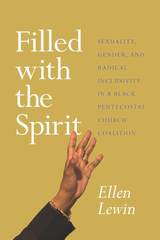 Filled with the Spirit: Sexuality, Gender, and Radical Inclusivity in a Black Pentecostal Church Coalition
Ellen Lewin
University of Chicago Press, 2018 In 2001, a collection of open and affirming churches with predominantly African American membership and a Pentecostal style of worship formed a radically new coalition. The group, known now as the Fellowship of Affirming Ministries or TFAM, has at its core the idea of “radical inclusivity”: the powerful assertion that everyone, no matter how seemingly flawed or corrupted, has holiness within. Whether you are LGBT, have HIV/AIDS, have been in prison, abuse drugs or alcohol, are homeless, or are otherwise compromised and marginalized, TFAM tells its people, you are one of God’s creations.
In Filled with the Spirit, Ellen Lewin gives us a deeply empathetic ethnography of the worship and community central to TFAM, telling the story of how the doctrine of radical inclusivity has expanded beyond those it originally sought to serve to encompass people of all races, genders, sexualities, and religious backgrounds. Lewin examines the seemingly paradoxical relationship between TFAM and traditional black churches, focusing on how congregations and individual members reclaim the worship practices of these churches and simultaneously challenge their authority. The book looks closely at how TFAM worship is legitimated and enhanced by its use of gospel music and considers the images of food and African American culture that are central to liturgical imagery, as well as how understandings of personal authenticity tie into the desire to be filled with the Holy Spirit. Throughout, Lewin takes up what has been mostly missing from our discussions of race, gender, and sexuality—close attention to spirituality and faith.
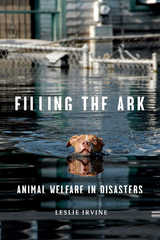 Filling the Ark: Animal Welfare in Disasters
Leslie Irvine
Temple University Press, 2009 When disasters strike, people are not the only victims. Hurricane Katrina raised public attention about how disasters affect dogs, cats, and other animals considered members of the human family. In this short but powerful book, noted sociologist Leslie Irvine goes beyond Katrina to examine how disasters like oil spills, fires, and other calamities affect various animal populations—on factory farms, in research facilities, and in the wild. Filling the Ark argues that humans cause most of the risks faced by animals and urges for better decisions about the treatment of animals in disasters. Furthermore, it makes a broad appeal for the ethical necessity of better planning to keep animals out of jeopardy. Irvine not only offers policy recommendations and practical advice for evacuating animals, she also makes a strong case for rethinking our use of animals, suggesting ways to create more secure conditions.
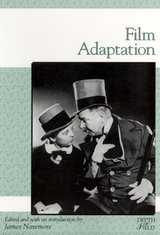 Film Adaptation
Naremore, James
Rutgers University Press, 2000 Some of the earliest feature films were derived from classic literature. Even today, most of the movies we see are adaptations of one kind or another. People who have never read Jane Austen can see her characters on the screen; but filmgoers can also see material taken from theater, television, comic books, and every other medium. The essays in this volume, most of which have never before been published, raise fundamental questions about cinema and adaptation: what is the nature of the "literary" and the "cinematic"? Why do so many of the films described as adaptions seem to derive from canonical literature rather than from other sources? How do the different media affect the ways stories are told? Film Adaptation offers fresh approaches to the art, theory, and cultural politics of movie adaptations, even challenging what is meant by the term "adaptation" itself. Contributors examine the process of adaptation in both theory and practice, discussing a wide variety of films. James Naremore's introduction provides an accessible historical overview of the field and reveals the importance of adaptation study to the many different academic disciplines now attracted to the analysis of film as commodity, document, and cultural artifact. (Contributors are André Bazin, Dudley Andrew, Robert B. Ray, Robert Stam, Richard Maltby, Guerric DeBona, O. M. B., Gilberto Perez, Michael Anderegg, Matthew Bernstein, Darlene J. Sadlier, Jonathan Rosenbaum, and Lesley Stern.)
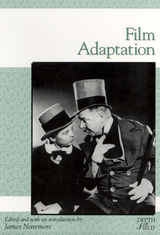 Film Adaptation
Naremore, James
Rutgers University Press, 2000 Some of the earliest feature films were derived from classic literature. Even today, most of the movies we see are adaptations of one kind or another. People who have never read Jane Austen can see her characters on the screen; but filmgoers can also see material taken from theater, television, comic books, and every other medium. The essays in this volume, most of which have never before been published, raise fundamental questions about cinema and adaptation: what is the nature of the "literary" and the "cinematic"? Why do so many of the films described as adaptions seem to derive from canonical literature rather than from other sources? How do the different media affect the ways stories are told? Film Adaptation offers fresh approaches to the art, theory, and cultural politics of movie adaptations, even challenging what is meant by the term "adaptation" itself. Contributors examine the process of adaptation in both theory and practice, discussing a wide variety of films. James Naremore's introduction provides an accessible historical overview of the field and reveals the importance of adaptation study to the many different academic disciplines now attracted to the analysis of film as commodity, document, and cultural artifact. (Contributors are André Bazin, Dudley Andrew, Robert B. Ray, Robert Stam, Richard Maltby, Guerric DeBona, O. M. B., Gilberto Perez, Michael Anderegg, Matthew Bernstein, Darlene J. Sadlier, Jonathan Rosenbaum, and Lesley Stern.)
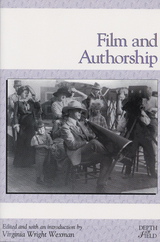 Film and Authorship
Wexman, Virginia W
Rutgers University Press, 2003 During the 1960s, when cinema first entered the academy as a serious object of study, the primary focus was on auteurism, or on films authorship. Burgeoning cinema studies courses demonstrated how directors were the authors of work that undermined (or succeeded in spite of) all the constraints that Hollywood threw at them. New critical methods were introduced as the field matured, and studies of the author/director, for the most part, were considered obsolete. Virginia Wright Wexman has pulled together some of the freshest writing available on the topic of film authorship. Spanning approaches including poststructuralism, feminism, queer theory, postcolonialism, and cultural studies, the contributors ask, what does auteurship look like today in light of all these developments? The contents of the volume are divided into three major sections: Theoretical Statements, Historical and Institutional Contexts, and Case Studies. Wexmans comprehensive introduction contextualizes the selections and summarizes the scholarly methods through which auteurism has been addressed in the past; it also provides a sketch of the history of media authorship. An extensive bibliography rounds off the volume.
 Film and Everyday Resistance
Marguerite La Caze
Northwestern University Press, 2024 A philosophical exploration of how modern global cinema represents everyday means of resisting authoritarianism and totalitarianism Václav Havel’s concept of “living within the truth” in an authoritarian regime frames Marguerite La Caze’s readings of international cinema, highlighting forms of resistance in which seemingly pre- or nonpolitical aspects of life—such as professional labor, exile, and truth telling—can be recognized as political when seen against a backdrop of general acquiescence. La Caze’s case studies cross genres, historical eras, and national contexts: the apartheid regime in South Africa, in A Dry White Season; post-Suharto Indonesia, in The Look of Silence; 1980s East Germany, in Barbara; the Chilean military dictatorship, in No; contemporary Iran, in A Separation; and current-day Saudi Arabia, in Wadjda. This book explores the films’ use of image, sound, narrative, and character in dialogue with the work of Simone de Beauvoir, Aimé Cesaire, Hannah Arendt, Sara Ahmed, and W. E. B. Du Bois to reveal how cinema depicts ordinary people enacting their own philosophies of defiance.
 Film and Genocide
Kristi M. Wilson
University of Wisconsin Press, 2011 Film and Genocide brings together scholars of film and of genocide to discuss film representations, both fictional and documentary, of the Holocaust, the Armenian genocide, and genocides in Chile, Australia, Rwanda, and the United States. Since 1955, when Alain Resnais created his experimental documentary Night and Fog about the Nazis’ mass killings of Jews and other ostracized groups, filmmakers have struggled with using this medium to tell such difficult stories, to re-create the sociopolitical contexts of genocide, and to urge awareness and action among viewers. This volume looks at such issues as realism versus fiction, the challenge of depicting atrocities in a manner palatable to spectators and film distributors, the Holocaust film as a model for films about other genocides, and the role of new technologies in disseminating films about genocide.
Film and Genocide also includes interviews with three film directors, who discuss their experiences in working with deeply disturbing images and bringing hidden stories to life: Irek Dobrowolski, director of The Portraitist (2005) a documentary about Wilhelm Brasse, an Auschwitz-Birkenau prisoner ordered to take more than 40,000 photos at the camp; Nick Hughes, director of 100 Days (2005) a dramatic film about the Rwandan mass killings; and Greg Barker, director of Ghosts of Rwanda (2004), a television documentary for Frontline.
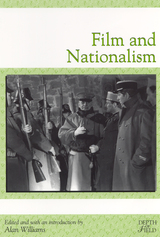 Film and Nationalism
Williams, Alan
Rutgers University Press, 2002 Today there is much debate over an increasingly "global economy." But commercial cinema has been, from the very beginnings of its existence, "globalized." From the mediums inception, films have defined and reinforced the core values and social structures of countries. They have also helped definesocially and culturallywhat is to be considered "outside" the nation and what it is to be shunned. Film and Nationalism examines the ways in which cinema has been considered an arena of conflict and interaction between nations and nationhood. Each section of this volume explores a crucial aspect of the discussion. Is film an effective form of national propaganda? Are films losing the very notion of nationhood, in favor of a generalized, "global" cinematographic culture? What is films influence over "national character"? In addition, the volume explores the cultural and economic interactions between developed and underdeveloped countries. How have third world nations defined themselves in relation to hegemonic first world cultures, and how have their relations been changed through the dissemination of Western films? Throughout, Alan Williams chooses essays that enhance our understanding of how films help shape our sense of nationhood and self.
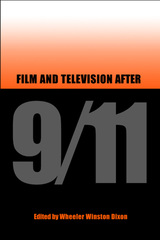 Film and Television After 9/11
Edited by Wheeler Winston Dixon
Southern Illinois University Press, 2004 In Film and Television After 9/11, editor Wheeler Winston Dixon and eleven other distinguished film scholars discuss the production, reception, and distribution of Hollywood and foreign films after the terrorist attacks of September 11, 2001, and examine how moviemaking has changed to reflect the new world climate. While some contemporary films offer escapism, much of mainstream American cinema since 9/11 is centered on the desire for a “just war” in which military reprisals and escalation of warfare appear to be both inevitable and justified. Films of 2002 such as Black Hawk Down, Collateral Damage, and We Were Soldiers demonstrate a renewed audience appetite for narratives of conflict, reminiscent of the wave of filmmaking that surrounded American involvement in World War II. The attacks on the World Trade Center and the Pentagon galvanized the American public initially, yet film critics wonder how this will play out over time. Film and Television After 9/11 is the first book to provide original insights into topics ranging from the international reception of post-9/11 American cinema, re-viewing films of our shared cinematic past in light of the attacks, and exploring parallels between post-9/11 cinema and World War II-era productions.
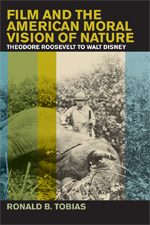 Film and the American Moral Vision of Nature: Theodore Roosevelt to Walt Disney
Ronald B. Tobias
Michigan State University Press, 2011 With his square, bulldoggish stature, signature rimless glasses, and inimitable smile—part grimace, part snarl—Theodore Roosevelt was an unforgettable figure, imprinted on the American memory through photographs, the chiseled face of Mount Rushmore, and, especially, film. At once a hunter, explorer, naturalist, woodsman, and rancher, Roosevelt was the quintessential frontiersman, a man who believed that only nature could truly test and prove the worth of man. A documentary he made about his 1909 African safari embodied aggressive ideas of masculinity, power, racial superiority, and the connection between nature and manifest destiny. These ideas have since been reinforced by others—Jesse “Buff alo” Jones, Paul Rainey, Martin and Osa Johnson, and Walt Disney. Using Roosevelt as a starting point, filmmaker and scholar Ronald Tobias traces the evolution of American attitudes toward nature, attitudes that remain, to this day, remarkably conflicted, complex, and instilled with dreams of empire.
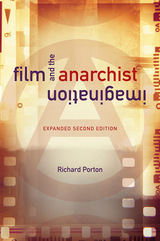 Film and the Anarchist Imagination: Expanded Second Edition
Richard Porton
University of Illinois Press, 2020 Hailed since its initial release, Film and the Anarchist Imagination offers the authoritative account of films featuring anarchist characters and motifs. Richard Porton delves into the many ways filmmakers have portrayed anarchism’s long traditions of labor agitation and revolutionary struggle. While acknowledging cinema’s predilection for ludicrous anarchist stereotypes, he focuses on films that, wittingly or otherwise, reflect or even promote workplace resistance, anarchist pedagogy, self-emancipation, and anti-statist insurrection. Porton ranges from the silent era to the classics Zéro de Conduite and Love and Anarchy to contemporary films like The Nothing Factory while engaging the works of Jean Vigo, Jean-Luc Godard, Lina Wertmüller, Yvonne Rainer, Ken Loach, and others. For this updated second edition, Porton reflects on several new topics, including the negative portrayals of anarchism over the past twenty years and the contemporary embrace of post-anarchism.
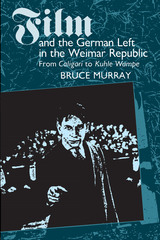 Film and the German Left in the Weimar Republic: From Caligari to Kuhle Wampe
By Bruce Murray
University of Texas Press, 1990 The Weimar Republic of Germany, covering the post-World War I period of civil and governmental strife, witnessed a great struggle among a variety of ideologies, a struggle for which the arts provided one important arena. Leftist individuals and organizations critiqued mainstream art production and attempted to counter what they perceived as its conservative-to-reactionary influence on public opinion. In this groundbreaking study, Bruce Murray focuses on the leftist counter-current in Weimar cinema, offering an alternative critical approach to the traditional one of close readings of the classical films. Beginning with a brief review of pre-Weimar cinema (1896-1918), he analyzes the film activity of the Social Democratic Party, the German Communists, and independent leftists in the Weimar era. Leftist filmmakers, journalists, and commentators, who in many cases contributed significantly to marginal leftist as well as mainstream cinema, have, until now, received little scholarly attention. Drawing on exhaustive archival research and personal interviews, Murray shows how the plurality of aesthetic models represented in the work of individuals who participated in leftist experiments with cinema in the 1920S collapsed as Germany underwent the transition from parliamentary democracy to fascist dictatorship. He suggests that leftists shared responsibility for that collapse and asserts the value of such insights for those who contemplate alternatives to institutional forms of cinematic discourse today.
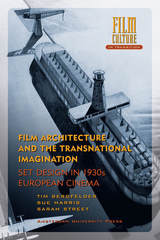 Film Architecture and the Transnational Imagination: Set Design in 1930s European Cinema
Tim Bergfelder, Sue Harris, and Sarah Street
Amsterdam University Press, 2007
European cinema between World Wars I and II was renowned for its remarkable attention to detail and visual effects in set design. Visionary designers such as Vincent Korda and Alfred Junge extended their influence across national film industries in Paris, London, and Berlin, transforming the studio system into one of permeable artistic communities. For the first time, Film Architecture and the Transnational Imagination provides a comparative study of European film set design in the late 1920s and 1930s. Based on a wealth of drawings, film stills, and archival documents from the period, this volume illuminates the emerging significance of transnational artistic collaboration in light of developments in Britain, France, and Germany. A comprehensive analysis of the practices, styles, and function of interwar cinematic production design, Film Architecture and the Transnational Imagination offers new insight into the period’s remarkable achievements and influence on subsequent generations.
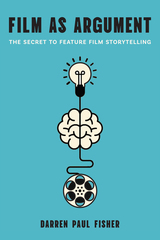 Film as Argument: The Secret to Feature Film Storytelling
Darren Paul Fisher
Rutgers University Press, 2025 If you’ve picked up this book, it’s most likely that you have an interest in movies over-and-above the typical audience member. Perhaps a screenwriter, producer or director looking to improve your work, always searching for any insight that will result in better cinematic storytelling. If that’s the case, then good news: this is the book for you. It asks a deceptively straightforward question. Why do we make feature films?
Is it to entertain? To move and audience? To tell a powerful story? For fame and fortune?
You may have answered yes to each, but those answers don’t account for the practice overall. Most books about screenwriting and directing are primarily concerned with craft and technique, but how can you truly understand filmmaking – or make the best films - unless you know what purpose it really serves.
So what’s the secret? As the title of this book suggests, making feature films is fundamentally the practice of making a very specific type of argument. To see how this works, we will deep-dive into how filmmakers are trained and taught to think about filmmaking, and what traditions they knowingly or unknowingly follow. We will look at hundreds of films and some major case studies, including Toy Story 3, Schindler’s List, Raiders of the Lost Ark, Amour, and mother!, to explore how and what films argue, and why knowing this can both unlock both a greater appreciation of the form, and improve the impact your films make.
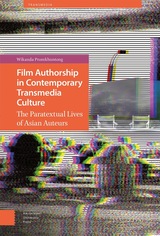 Film Authorship in Contemporary Transmedia Culture: The Paratextual Lives of Asian Auteurs
Wikanda Promkhuntong
Amsterdam University Press, 2023 Film Authorship in Contemporary Transmedia Culture: The Paratextual Lives of Asian Auteurs examines film authorship in the transmedia era whereby film directors have become public figures through a wide range of textual, material, and performative practices. The book draws on the notion of paratext and its related term – palimpsest – to bring forth the idea of self-reflexive authorship as a method of examining the mediated past, present, and afterlife of East Asian filmmakers. The first part of the book pays attention to materials surrounding film festivals, multi-platform distribution, and cinephile/fan creative practices, which have been created, rewritten, and shared to foster and problematize the reputations of selected filmmakers. The second part examines alternative modes of self-projections and creative productions that address the filmmakers’ sense of selves and relations with the industry and the public. Across different chapters, discourses surrrounding film authorship and East Asian cinema are revisited and expanded to highlight its multiple histories and possible futures.
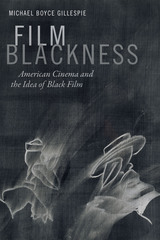 Film Blackness: American Cinema and the Idea of Black Film
Michael Boyce Gillespie
Duke University Press, 2016 In Film Blackness Michael Boyce Gillespie shifts the ways we think about black film, treating it not as a category, a genre, or strictly a representation of the black experience but as a visual negotiation between film as art and the discursivity of race. Gillespie challenges expectations that black film can or should represent the reality of black life or provide answers to social problems. Instead, he frames black film alongside literature, music, art, photography, and new media, treating it as an interdisciplinary form that enacts black visual and expressive culture. Gillespie discusses the racial grotesque in Ralph Bakshi's Coonskin (1975), black performativity in Wendell B. Harris Jr.'s Chameleon Street (1989), blackness and noir in Bill Duke's Deep Cover (1992), and how place and desire impact blackness in Barry Jenkins's Medicine for Melancholy (2008). Considering how each film represents a distinct conception of the relationship between race and cinema, Gillespie recasts the idea of black film and poses new paradigms for genre, narrative, aesthetics, historiography, and intertextuality.
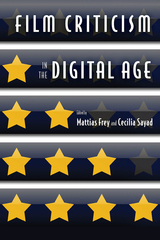 Film Criticism in the Digital Age
Frey, Mattias
Rutgers University Press, 2015 Over the past decade, as digital media has expanded and print outlets have declined, pundits have bemoaned a “crisis of criticism” and mourned the “death of the critic.” Now that well-paying jobs in film criticism have largely evaporated, while blogs, message boards, and social media have given new meaning to the saying that “everyone’s a critic,” urgent questions have emerged about the status and purpose of film criticism in the twenty-first century.
In Film Criticism in the Digital Age, ten scholars from across the globe come together to consider whether we are witnessing the extinction of serious film criticism or seeing the start of its rebirth in a new form. Drawing from a wide variety of case studies and methodological perspectives, the book’s contributors find many signs of the film critic’s declining clout, but they also locate surprising examples of how critics—whether moonlighting bloggers or salaried writers—have been able to intervene in current popular discourse about arts and culture.
In addition to collecting a plethora of scholarly perspectives, Film Criticism in the Digital Age includes statements from key bloggers and print critics, like Armond White and Nick James. Neither an uncritical celebration of digital culture nor a jeremiad against it, this anthology offers a comprehensive look at the challenges and possibilities that the Internet brings to the evaluation, promotion, and explanation of artistic works.
 Film, Drama and the Break Up of Britain
Steve Blandford
Intellect Books, 1995 When the sun set on the British Empire, the resultant fragmentation of British identity emerged most tellingly in artistic works: cinematic works such as Howards End depicted a richly historical land steeped in tradition and tragedy, while the more modern Lock, Stock and Two Smoking Barrels revealed a brutal yet sharply humorous portrayal of contemporary English life. That relationship between nationalism, national identity, and postcolonialism remains central to many British dramatists’ works, and in Film, Drama and the Break Up of Britain, Steve Blandford explores how the “break up” of Britain has influenced contemporary British drama. Breaking down the scholarly barriers between theater and film studies, Blandford examines British directors’ interpretations of their nation’s postcolonial age, tracing the various ways that auteurs have created dramatic narratives that explore the idea of being “British” and all its inherent complexity. From community-based theaters in Scotland and Wales to the blockbuster The Full Monty, Blandford probes the cultural impact of Britain’s struggle to form a new identity, making his book an essential read for all those interested in postcolonial studies and the history of British film. “The perfect primer for anyone looking to obtain an overview of what has been happening within British culture over the past decade. [Blandford] has an accessible style, his analysis is sharp, his arguments clear and persuasive, and by virtue of the breadth of his focus, this study is certain to remain a valuable resource as notions of cultural identity across the British Isles continue to provoke debate.”—Owen Evans, Media Wales Journal “The author examines how recent theatre and cinema have reflected and critiqued emerging ways of imagining Britishness. Blandford is a lucid writer whose chapter on Irish film is a deft round-up of existing critical opinions on the topic.”—Ruth Barton, Film Ireland
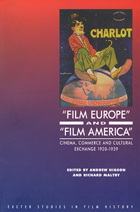 'Film Europe' And 'Film America': Cinema, Commerce and Cultural Exchange 1920-1939
Edited by Andrew Higson and Richard Maltby
University of Exeter Press, 1998 A volume of specially-commissioned essays dealing with the attempts to create a pan-European film production movement in the 1920s and 1930s, and the reactions of the American film industry to these plans to rival its hegemony. The book has an impressive array of top scholars from both America and Europe, including Thomas Elsaesser, Kristin Thompson and Ginette Vincendeau, as well as essays by some younger scholars who have recently completed new archival research. It also includes a number of primary documents selected by the contributors to illuminate their arguments and provide a stimulus to further research.
This book is a volume in the series Exeter Studies in Film History, and represents a major contribution to cinema scholarship as well as reflecting a strong interest in an area of study currently being developed in university departments and at the British Film Institute.
Winner Prix Jean Mitry 2000
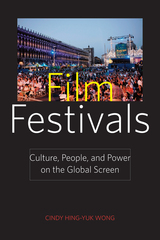 Film Festivals: Culture, People, and Power on the Global Screen
Wong, Cindy H
Rutgers University Press, 2011 Movies, stars, auteurs, critics, and the sheer excitement of cinema come together in film festivals as quintessential constellations of art, business, and glamour. Yet, how well do we actually understand the forces and meanings that these events embody? Film Festivals offers the first comprehensive overview of the history, people, films, and multiple functions of the festival world. From Sundance to Hong Kong, from the glitter of Cannes to edgier festivals that challenge boundaries or foster LGBTQ cultural production, film festivals celebrate art, promote business, bring cinema to diverse audiences, and raise key issues about how we see our world. Cindy Hing-Yuk Wong situates festivals within changing global practices of film, including their important ties to both Hollywood and independent cinema. She explores how these events have become central in the construction of cinema knowledge as well as the behind-the-scene mechanics of finance, distribution, and evaluation. By linking general structures and connections to specific films and auteurs, Wong addresses the components and creation of film festivals that continue to reshape filmmaking as art and business.
Film Festivals: From European Geopolitics to Global Cinephilia
Marijke de Valck
Amsterdam University Press, 2008 Film festivals are hugely popular events that attract lovers of cinema worldwide. Focusing on the world’s most famous festivals – Cannes, Berlin, Venice and Rotterdam – Film Festivals tells the story of a phenomenon that began in the midst of geopolitical disputes in war-torn Europe. De Valck shows how festivals turned the odds into advantages and developed into a successful global network. Taking into account the oft multilateral influences of major actors, such as Hollywood, the avant-garde and political/economic agenda’s, the book offers a comprehensive understanding of film festivals. A must-read for everyone interested in quality film cultures that revolve around cultural value, aesthetic innovation and socio-political relevance.
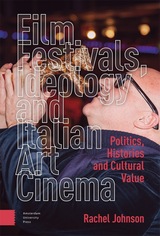 Film Festivals, Ideology and Italian Art Cinema: Politics, Histories and Cultural Value
Rachel Johnson
Amsterdam University Press, 2024 Film Festivals, Ideology and Italian Art Cinema is the first systematic study of the role ideology plays in film festivals’ construction of dominant ideas about art cinema.
Film festivals are considered the driving force of the film industry outside Hollywood, disseminating ideals of cinematic art and humanist politics. However, the question of what drives them remains highly contentious.
In a rare consideration of the European competitive film festival circuit as a whole, this book analyses the shared economic, geopolitical and cultural histories that characterise ‘European A festivals’. It offers, too, the first extensive analysis of such festivals’ role in the canonisation of select Italian films, from Rome, Open City to The Great Beauty and Gomorrah.
The book proposes a new approach to ideology critique, one that enables detailed examination of how film festivals construct ideas about not only contemporary art cinema, but assumptions about gender, race, colonialism and capitalism.
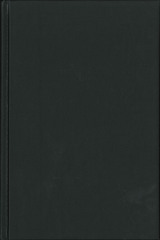 Film Genre Reader IV
Edited by Barry Keith Grant
University of Texas Press, 2012 From reviews of the third edition: “Film Genre Reader III lives up to the high expectations set by its predecessors, providing an accessible and relatively comprehensive look at genre studies. The anthology’s consideration of the advantages and challenges of genre studies, as well as its inclusion of various film genres and methodological approaches, presents a pedagogically useful overview.” —Scope Since 1986, Film Genre Reader has been the standard reference and classroom text for the study of genre in film, with more than 25,000 copies sold. Barry Keith Grant has again revised and updated the book to reflect the most recent developments in genre study. This fourth edition adds new essays on genre definition and cycles, action movies, science fiction, and heritage films, along with a comprehensive and updated bibliography. The volume includes more than thirty essays by some of film’s most distinguished critics and scholars of popular cinema, including Charles Ramírez Berg, John G. Cawelti, Celestino Deleyto, David Desser, Thomas Elsaesser, Steve Neale, Thomas Schatz, Paul Schrader, Vivian Sobchack, Janet Staiger, Linda Williams, and Robin Wood.
 Film Hieroglyphs
Tom Conley
University of Minnesota Press, 2006 At a time when traditional film theory privileged the purely visual, Film Hieroglyphs introduced a new way of watching film—examining the ways in which writing bears on cinema. Author Tom Conley gives special consideration to the points (ruptures) at which story, image, and writing appear to be at odds with one another.Conley hypothesizes that major directors—Renoir, Lang, Walsh, Rossellini—tend unconsciously to meld history and ideology. Graphic elements are seen as simultaneously foreign and integral to the field of the image. From these contradictions hieroglyphs emerge that mark a design attesting to a hidden rhetoric and to configurations of meaning that cinema cannot always control.Tom Conley is Lowell Professor of romance languages and visual and environmental studies at Harvard University. Among his books is The Self-Made Map (1996), as well as translations of The Fold (1992) by Gilles Deleuze and In the Metro (2002) by Marc Augé, all available from the University of Minnesota Press.
Film History as Media Archaeology: Tracking Digital Cinema
Thomas Elsaesser
Amsterdam University Press, 2016 Since cinema has entered the digital era, its very nature has come under renewed scrutiny. Countering the 'death of cinema' debate, Film History as Media Archaeology presents a robust argument for the cinema's current status as a new epistemological object, of interest to philosophers, while also examining the presence of moving images in the museum and art spaces as a challenge for art history. The current study is the fruit of some twenty years of research and writing at the interface of film history, media theory and media archaeology by one of the acknowledged pioneers of the 'new film history' and 'media archaeology'. It joins the efforts of other media scholars to locate cinema's historical emergence and subsequent transformations within the broader field of media change and interaction, as we experience them today.
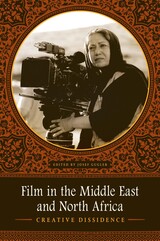 Film in the Middle East and North Africa: Creative Dissidence
Edited by Josef Gugler
University of Texas Press, 2011 This is the first study to cover cinemas from Iran to Morocco. Nine essays present the region's major national cinemas, devoting special attention to the work of directors who have given image and voice to dissent from political regimes, from patriarchal customs, from fundamentalist movements, and from the West. These country essays are complemented by in-depth discussions of eighteen films that have been selected for both their excellence and their critical engagement with pressing current issues. The introduction provides a comprehensive overview of filmmaking throughout the region, including important films produced outside the national cinemas. The long history of Iranian cinema, its international renown, and the politics of directors confronting the state, earns it a special place in this volume. The other major emphasis is on the Israel/Palestine conflict, featuring films by Palestinian directors, Israelis, and an Egyptian working in Syria. Nineteen authors collaborated on this book, among them Walter Armbrust, Roy Armes, Kevin Dwyer, Eric Egan, Nurith Gertz, Lina Khatib, Florence Martin, and Nadia Yaqub. About half of the contributors are film scholars; the others range across literary studies and the social sciences to two film directors and a novelist. Beyond differences in disciplinary orientation, there is considerable variation among contributors in the perspectives that inform their writing. They offer an illuminating range of approaches to the cinemas of the region. The book is richly illustrated with posters of the featured films, photos of their directors at work, and stills illustrating critical arguments in the film essays.
The Film Industry in Brazil: Culture and the State
Randal Johnson
University of Pittsburgh Press, 1987 Looking back through the prism of the severe economic crisis for filmmaking in the 1980s, The Film Industry in Brazil explores the unusual relationship between the state-supported industry, which often produced politically radical films, and the authoritarian regime that had held sway for twenty years. To ground his analysis, Johnson covers the early years of the film industry, 1898-1930; attempts at industrialization during the 1930s and 1940s; film industry congresses and government film boards, 1950-1966; the National Film Institute, 1966-1975; and the expansion of the state's role from 1969 through 1980.
Well-conceived, carefully researched and documented, Johnson's study fills a major gap in film studies by tracing the development of this industry in Brazil, focusing specifically on its relationship to the state.
Film Language: A Semiotics of the Cinema
Christian Metz
University of Chicago Press, 1990 A pioneer in the field, Christian Metz applies insights of structural linguistics to the language of film.
"The semiology of film . . . can be held to date from the publication in 1964 of the famous essay by Christian Metz, 'Le cinéma: langue ou langage?'"—Geoffrey Nowell-Smith, Times Literary Supplement
"Modern film theory begins with Metz."—Constance Penley, coeditor of Camera Obscura
"Any consideration of semiology in relation to the particular field signifying practice of film passes inevitably through a reference to the work of Christian Metz. . . . The first book to be written in this field, [Film Language] is important not merely because of this primacy but also because of the issues it raises . . . issues that have become crucial to the contemporary argument."—Stephen Heath, Screen
Film Museum Practice and Film Historiography: The Case of the Nederlands Filmmuseum (1946-2000)
Bregt G. Lameris
Amsterdam University Press, 2017 Rich in detail, this is a study of the interrelationships between film historical discourse and archival practices. Exploring the history of several important collections from the EYE Film Museum in Amsterdam, Bregt Lameris shows how archival films and collections always carry the historical traces of selection policies, restoration philosophies, and exhibition strategies. The result is a compelling argument that film archives can never be viewed simply as innocent or neutral sources of film history.
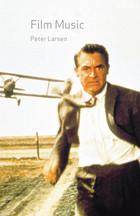 Film Music
Peter Larsen
Reaktion Books, 2005 Just hearing a few notes from certain songs can bring a movie back to life—whether the Doors’ “The End” from Apocalypse Now, Simon and Garfunkel’s “Mrs. Robinson” in The Graduate, or John Williams’ scores to such blockbusters as Jaws, Star Wars, and Raiders of the Lost Ark. But what is the relationship between film and music—where does the film begin and the music end?
Taking off from a variation of that question—whether music accompanies a film or a film illustrates the music—Peter Larsen probes the complex relationship between the two. He charts the history of music in film, exploring along the way the role that music plays in the narrative and psychological functions of film. Examining such classics and blockbusters as The Big Sleep, American Graffiti, North by Northwest, and Blade Runner,Larsen uses these case studies to demonstrate how scores and soundtracks can expose unexpected new facets of a film.
A wholly accessible examination, Film Music will be an essential read for music scholars and film buffs alike.
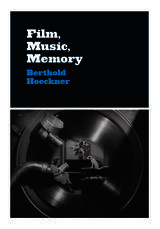 Film, Music, Memory
Berthold Hoeckner
University of Chicago Press, 2019 Film has shaped modern society in part by changing its cultures of memory. Film, Music, Memory reveals that this change has rested in no small measure on the mnemonic powers of music. As films were consumed by growing American and European audiences, their soundtracks became an integral part of individual and collective memory. Berthold Hoeckner analyzes three critical processes through which music influenced this new culture of memory: storage, retrieval, and affect. Films store memory through an archive of cinematic scores. In turn, a few bars from a soundtrack instantly recall the image that accompanied them, and along with it, the affective experience of the movie.
Hoeckner examines films that reflect directly on memory, whether by featuring an amnesic character, a traumatic event, or a surge of nostalgia. As the history of cinema unfolded, movies even began to recall their own history through quotations, remakes, and stories about how cinema contributed to the soundtrack of people’s lives. Ultimately, Film, Music, Memory demonstrates that music has transformed not only what we remember about the cinematic experience, but also how we relate to memory itself.
The Film Music of John Williams: Reviving Hollywood's Classical Style
Emilio Audissino
University of Wisconsin Press, 2021 From the triumphant “Main Title” in Star Wars to the ominous bass line of Jaws, John Williams has penned some of the most unforgettable film scores—while netting more than fifty Academy Award nominations. This updated and revised edition of Emilio Audissino’s groundbreaking volume takes stock of Williams’s creative process and achievements in music composition, including the most recent sequels in the film franchises that made him famous. Audissino discusses Williams’s unique approach to writing by examining his neoclassical style in context, demonstrating how he revived and revised classical Hollywood music. This volume details Williams’s lasting impact on the industry and cements his legacy as one of the most important composers in movie history. A must for fans and film-music lovers alike.
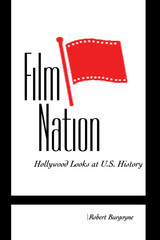 Film Nation: Hollywood Looks at U.S. History
Robert Burgoyne
University of Minnesota Press, 1997 Our movies have started talking back to us, and Film Nation takes a close look at what they have to say. In movies like JFK and Forrest Gump, Robert Burgoyne sees a filmic extension of the debates that exercise us as a nation--debates about race and culture and national identity, about the nature and makeup of American history.
In analyses of five films that challenge the traditional myths of the nation-state--Glory, Thunderheart, JFK, Born on the Fourth of July, and Forrest Gump--Burgoyne explores the reshaping of our collective imaginary in relation to our history. These movies, exploring the meaning of "nation" from below, highlight issues of power that underlie the narrative construction of nationhood. Film Nation exposes the fault lines between national myths and the historical experience of people typically excluded from those myths.
Throughout, Burgoyne demonstrates that these films, in their formal design, also preserve relics of the imaginary past they contest. Here we see how the "genre memory" of the western, the war film, and the melodrama shapes these films, creating a complex exchange between old concepts of history and the alternative narratives of historical experience that contemporary texts propose.
The first book to apply theories of nationalism and national identity to contemporary American films, Film Nation reveals the cinematic rewriting of history now taking place as a powerful attempt to rearticulate the cultural narratives that define America as a nation.
"The chief merit of Film Nation is that it outlines a study of an important but neglected period of American film--the 1980s--from a sophisticated historiographical perspective, a complex version of postmodernism and cultural studies. That is, it arises, conceptually speaking, from within the film studies orbit and takes advantage in a provocative, and in my view, compelling way, the resources and perspectives of contemporary critical theory more generally." Nick Brown
"Film Nation makes a real contribution to film studies by underscoring how much the 'war film' has been revived for the purpose of contemplating nationhood, and how, more implicitly, the idea of 'America' or even 'identity' has become increasingly problematic in the era of international democratic capitalism." Tom Conley
"A brilliant and elegant series of essays which demonstrate how the best contemporary historical films provide a powerful counternarrative to traditional history and help us to rethink the American past. Burgoyne's is by far the best book to date on the important relationship between American history and American film." Robert A. Rosenstone
Contents:
Introduction
Race and Nation in Glory
History vs. Folklore
Two Historical Trajectories
Racial Identity into National Identity
Native America, Thunderheart, and the National Imaginary
Reversing the Territorial Imaginary
The Western and the National Imaginary
The Western and its Tropes of Space and Nation
War and the Forging of Ethnic Community
National Identity, Gender Identity and the "Rescue Fantasy" in Born on the 4th of July
Melodrama and National Identity
The Critique of Masculinity as "Punitive Agency"
Imaging the Nation
Modernism and the Narrative of Nation in JFK
The Temporality of Trauma
The Imagined Community as Lost Object
Prosthetic Memory/National Memory: Forrest Gump
Memory and National Identity
Nation and Religion
Redefining the Sixties
Conclusion
Robert Burgoyne is professor of English and film studies at Wayne State University and is chair of the Department of English. He is the author of Bertolucci's 1900: A Narrative and Historical Analysis (1991) and coauthor, with Robert Stam and Sandy Flitterman-Lewis, of New Vocabularies in Film Semiotics (1992).
 Film Nation: Hollywood Looks at U.S. History, Revised Edition
Robert Burgoyne
University of Minnesota Press, 2010 Events of the past decade have dramatically rewritten the American national narrative, bringing to light an alternate history of nation, marked since the country’s origins by competing geopolitical interests, by mobility and migration, and by contending ethnic and racial groups. In this revised and expanded edition of Film Nation, Robert Burgoyne analyzes films that give shape to the counternarrative that has emerged since 9/11—one that challenges the traditional myths of the American nation-state. The films examined here, Burgoyne argues, reveal the hidden underlayers of nation, from the first interaction between Europeans and Native Americans (The New World), to the clash of ethnic groups in nineteenth-century New York (Gangs of New York), to the haunting persistence of war in the national imagination (Flags of Our Fathers and Letters from Iwo Jima) and the impact of the events of 9/11 on American identity (United 93 and World Trade Center). Film Nation provides innovative readings of attempts by such directors as Martin Scorsese, Clint Eastwood, and Oliver Stone to visualize historical events that have acquired a mythical aura in order to open up the past to the contemporary moment.
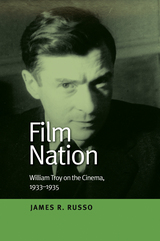 Film Nation: William Troy on the Cinema, 1933–1935
James R. Russo
Sussex Academic Press, 2022 Notable writers on literature and culture who occasionally penned opinion pieces on the movies prior to World War II include Clifton Fadiman, Mark Van Doren, Lincoln Kirstein, Edmund Wilson, Louise Bogan, and Paul Goodman. All of these critics wrote seriously about things other than the movies. Indeed, the early decades of film criticism drew many moonlighters who tried their hand at it for a few years, then moved on to their preferred mtier. And such was the case with William Troy (19031961). Troy, a distinguished literary critic whose posthumous Selected Essays ;won a National Book Award in 1968, was also a much-loved professor at Bennington College, the New School, and New York University. Troy was the film critic of The Nation; from 1933 to 1935. To that post he brought an educated, almost professional tone, which he sometimes used for comic effect. He approached each piece of film criticism as an occasion for some larger essayistic rumination. Indeed, his feeling for the carpentry of the short review is superb, as the reader will detect in his pieces on such important films as Buuel's L'ge d'or;, Lang's M;, Duvivier's Poil de Carotte;, Eisenstein's Que Viva Mexico!;, Dreyer's The Passion of Joan of Arc;, Cocteau's Blood of a Poet;, Pudovkin's Mother;, Flaherty's Man of Aran;, Renoir's Madame Bovary;, and Ford's The Informer;. William Troy was thus one of America's first full-time professional film critics, if not the best of the lot. He deserves some of the attention heretofore reserved for another important early critic, James Agee, who himself began writing movie reviews for The Nation; in 1942. Published in conjunction with The Bookman: William Troy on Literature and Criticism, 19271950; (ISBN 978-1-78976-172-6), Film Nation; is essential reading for cinephiles. Inclusion of a substantive index makes the work highly attractive for classroom adoption in the field of cinema studies.
 Film Noir and the Arts of Lighting
Patrick Keating
Rutgers University Press, 2024 More than any other set of films from the classical era, the Hollywood film noir is known for its lighting: the cast shadows, the blinking street signs, the eyes sparkling in the darkness. Each effect is rich in symbolism, evoking a world of danger and doppelgangers. But what happens if we set aside the symbolism? This book offers a new account of film noir lighting, grounded in a larger theory of Hollywood cinematography as emotionally engaging storytelling. Above all, noir lighting is dynamic, switching from darkness to brightness and back again as characters change, locations shift, and fates unfold. Richly illustrated, Film Noir and the Arts of Lighting features in-depth analyses of eleven classic movies: The Asphalt Jungle, Sorry, Wrong Number, Odds against Tomorrow, The Letter, I Wake Up Screaming, Phantom Lady, Strangers on a Train, Sweet Smell of Success, Gaslight, Secret beyond the Door, and Touch of Evil.
Film Noir and the Cinema of Paranoia
Dixon, Wheeler Winston
Rutgers University Press, 2009 Noir. A shadow looms. The blow, a sharp surprise. Waking and sleeping, the fear is with us and cannot be contained. Paranoia. Wheeler Winston Dixon's comprehensive work engages readers in an overview of noir and fatalist film from the mid-twentieth century to the present, ending with a discussion of television, the Internet, and dominant commercial cinema. Beginning with the 1940s classics, Film Noir and the Cinema of Paranoia moves to the "Red Scare" and other ominous expressions of the 1950s that contradicted an American split-level dream of safety and security. The dark cinema of the 1960s hosted films that reflected the tensions of a society facing a new and, to some, menacing era of social expression. From smaller studio work to the vibrating pulse of today's "click and kill" video games, Dixon boldly addresses the noir artistry that keeps audiences in an ever-consumptive stupor.
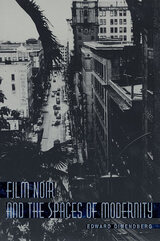 Film Noir and the Spaces of Modernity
Edward Dimendberg
Harvard University Press, 2004 Film noir remains one of the most enduring legacies of 1940s and ’50s Hollywood. Populated by double-crossing, unsavory characters, this pioneering film style explored a shadow side of American life during a period of tremendous prosperity and optimism. Edward Dimendberg compellingly demonstrates how film noir is preoccupied with modernity—particularly the urban landscape.
The originality of Dimendberg’s approach lies in his examining these films in tandem with historical developments in architecture, city planning, and modern communications systems. He confirms that noir is not simply a reflection of modernity but a virtual continuation of the spaces of the metropolis. He convincingly shows that Hollywood’s dark thrillers of the postwar decades were determined by the same forces that shaped the city itself.
Exploring classic examples of film noir such as The Asphalt Jungle, Double Indemnity, Kiss Me Deadly, and The Naked City alongside many lesser-known works, Dimendberg masterfully interweaves film history and urban history while perceptively analyzing works by Raymond Chandler, Edward Hopper, Siegfried Kracauer, and Henri Lefebvre. A bold intervention in cultural studies and a major contribution to film history, Film Noir and the Spaces of Modernity will provoke debate by cinema scholars, urban historians, and students of modern culture—and will captivate admirers of a vital period in American cinema.
Film on The Faultline
Edited by Alan Wright
Intellect Books, 2015 Film has always played a crucial role in the imagination of disaster. Earthquakes, especially, not only shift the ground beneath our feet but also herald a new way of thinking or being in the world. Following recent seismic events in countries as dissimilar as Iran, Chile and Haiti, Japan and New Zealand, national films have emerged that challenge ingrained political, economic, ethical, and ontological categories of modernity. Film on the Faultline explores the fractious relationship between cinema and seismic experience and addresses the important role that cinema can play in the wake of such events as forms of popular memory and personal testimony.
 The Film Paintings of David Lynch: Challenging Film Theory
Allister Mactaggart
Intellect Books, 2010 One of the most distinguished filmmakers working today, David Lynch is a director whose vision of cinema is firmly rooted in fine art. He was motivated to make his first film as a student because he wanted a painting that “would really be able to move.” Most existing studies of Lynch, however, fail to engage fully with the complexities of his films’ relationship to other art forms. The Film Paintings of David Lynch fills this void, arguing that Lynch’s cinematic output needs to be considered within a broad range of cultural references. Aiming at both Lynch fans and film studies specialists, Allister Mactaggart addresses Lynch’s films from the perspective of the relationship between commercial film, avant-garde art, and cultural theory. Individual Lynch films—The Elephant Man, Blue Velvet, Twin Peaks, Lost Highway, The Straight Story, Mulholland Drive, Inland Empire—are discussed in relation to other films and directors, illustrating that the solitary, or seemingly isolated, experience of film is itself socially, culturally, and politically important. The Film Paintings of David Lynch offers a unique perspective on an influential director, weaving together a range of theoretical approaches to Lynch's films to make exciting new connections among film theory, art history, psychoanalysis, and cinema.
Film Phenomenology and Adaptation: Sensuous Elaboration
David Evan Richard
Amsterdam University Press, 2021 Film Phenomenology and Adaptation: Sensuous Elaboration argues that in order to make sense of film adaptation, we must first apprehend their sensual form. Across its chapters, this book brings the philosophy and research methodology of phenomenology into contact with adaptation studies, examining how vision, hearing, touch, and the structures of the embodied imagination and memory thicken and make tangible an adaptation’s source. In doing so, this book not only conceives adaptation as an intertextual layering of source material and adaptation, but also an intersubjective and textural experience that includes the materiality of the body.
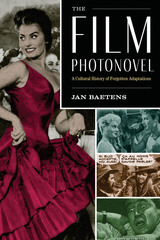 The Film Photonovel: A Cultural History of Forgotten Adaptations
By Jan Baetens
University of Texas Press, 2019 Discarded by archivists and disregarded by scholars despite its cultural impact on post–World War II Europe, the film photonovel represents a unique crossroads. This hybrid medium presented popular films in a magazine format that joined film stills or set pictures with captions and dialogue balloons to re-create a cinematic story, producing a tremendously popular blend of cinema and text that supported more than two dozen weekly or monthly publications. Illuminating a long-overlooked ‘lowbrow’ medium with a significant social impact, The Film Photonovel studies the history of the format as a hybrid of film novelizations, drawn novels, and nonfilm photonovels. While the field of adaptation studies has tended to focus on literary adaptations, this book explores how the juxtaposition of words and pictures functioned in this format and how page layout and photo cropping could affect reading. Finally, the book follows the film photonovel's brief history in Latin America and the United States. Adding an important dimension to the interactions between filmmakers and their audiences, this work fills a gap in the study of transnational movie culture.
Film Production and Consumption in Contemporary Taiwan: Cinema as a Sensory Circuit
Ya-Feng Mon
Amsterdam University Press, 2016 This book uses the potent case study of contemporary Taiwanese queer romance films to address the question of how capitalism in Taiwan has privileged the film industry at the expense of the audience's freedom to choose and respond to culture on its own terms. Interweaving in-depth interviews with filmmakers, producers, marketers, and spectators, Ya-Fong Mon takes a biopolitical approach to the question, showing how the industry uses investments in techno-science, ancillary marketing, and media convergence to seduce and control the sensory experience of the audience-yet that control only extends so far: volatility remains a key component of the film-going experience.
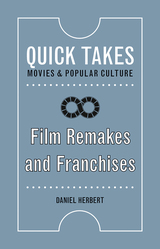 Film Remakes and Franchises
Herbert, Daniel
Rutgers University Press, 2017 Contemporary media seems incredibly unoriginal, as Hollywood produces an endless flood of remakes, sequels, reboots, and franchises. We watch as the same stories, characters, and images appear again and again in different films, on new platforms, and as toys and other merchandise. Are these works simply crass commercial products, utterly devoid of creativity, or do they offer filmmakers a unique opportunity to reimagine iconic characters and modern myths?
Film Remakes and Franchises examines how remakes and sequels have been central to the film industry from its very inception, yet also considers how the recent trends toward reboots and transmedia franchises depart from those historical precedents. Film scholar Daniel Herbert not only analyzes the film industry’s increasing reliance on recycled product, but also asks why audiences are currently so drawn to such movies. In addition, he explores how contemporary filmmakers have used reboots and franchise movies to inject timely social commentary and diversity into established media properties. A lively and accessible overview that covers everything from You’ve Got Mail to The Force Awakens, Film Remakes and Franchises raises important questions about the intersection of business and creativity in Hollywood today.
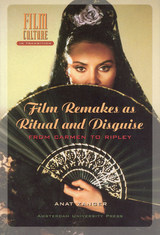 Film Remakes as Ritual and Disguise: From Carmen to Ripley
Anat Zanger
Amsterdam University Press, 2007
The first full-length history of the remake in cinema, Film Remakes as Ritual and Disguise is also the first book to explore how and why these stories are told.
Anat Zanger focuses on contemporary retellings of three particular tales—Joanof Arc, Carmen, and Psycho—to reveal what she calls the remake’s “rituals of disguise.” Joan of Arc, Zanger demonstrates, later appears as the tough, androgynous Ripley in the blockbuster Alien series and the God-ridden Bess in Lars Von Trier’s Breaking the Waves. Ultimately, these remake chains offer evidence of the archetypes of our own age, cultural “fingerprints” that are reflective of society’s own preferences and politics. Underneath the redundancy of the remake, Zanger shows, lies our collective social memory. Indeed, at its core the lowly remake represents a primal attempt to gain immortality, to triumph over death—playing at movie theaters seven days a week, 365 days a year.
Addressing the wider theoretical implications of her argument with sections on contemporary film issues such as trauma, jouissance, and censorship, Film Remakes as Ritual and Disguise is an insightful addition to current debates in film theory and cinema history.
Film Serials and the American Cinema, 1910-1940: Operational Detection
Ilka Brasch
Amsterdam University Press, 2018 Before the advent of television, cinema offered serialized films as a source of weekly entertainment. This book traces the history from the days of silent screen heroines to the sound era's daring adventure serials, unearthing a thriving film culture beyond the self-contained feature. Through extensive archival research, Ilka Brasch details the aesthetic appeals of film serials within their context of marketing and exhibition, looking at how they adapted the pleasures of a flourishing crime fiction culture to both serial visual culture and the affordances of the media-modernity of the early 20th century. The study furthermore traces the relationship of film serials to the broadcast models of radio and television and thereby shows how film serials introduced modes of storytelling that informed popular culture even beyond the serial's demise.
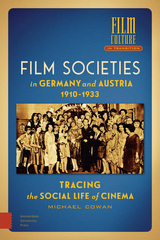 Film Societies in Germany and Austria 1910-1933: Tracing the Social Life of Cinema
Michael Cowan
Amsterdam University Press, 2023 This study traces the evolution of early film societies in Germany and Austria, from the emergence of mass movie theaters in the 1910s to the turbulent years of the late Weimar Republic. Examining a diverse array of groups, it approaches film societies as formations designed to assimilate and influence a new medium: a project emerging from the world of amateur science before taking new directions into industry, art and politics. Through an interdisciplinary approach—in dialogue with social history, print history and media archaeology—it also transforms our theoretical understanding of what a film society was and how it operated. Far from representing a mere collection of pre-formed cinephiles, film societies were, according to the book’s central argument, productive social formations, which taught people how to nurture their passion for the movies, how to engage with cinema, and how to interact with each other. Ultimately, the study argues that examining film societies can help to reveal the diffuse agency by which generative ideas of cinema take shape.
Film Studies in China: Selected Writings from Contemporary Cinema
Edited by Contemporary Cinema
Intellect Books, 2017 Film Studies in China is a collection of selected articles chosen from issues of the journal Contemporary Cinema published throughout the year and translated for an English-speaking audience. As one of the most prestigious academic film studies journals in China, Contemporary Cinema has been active not only in publishing Chinese scholarship for Chinese readers but also in reaching out to academics from across the globe. This anthology hopes to encourage a cross-cultural academic conversation on the fields of Chinese cinema and media studies.
Film Studies in China, Volume 2: Selected Writings from Contemporary Cinema
Edited by Contemporary Cinema (China Film Archive)
Intellect Books, 2020 Film Studies in China, Volume 2 is a collection of articles selected from issues of the journal Contemporary Cinema, published throughout the year and translated for an English-speaking audience. As one of the most prestigious academic film studies journals in China, Contemporary Cinema has been active not only in publishing Chinese scholarship for Chinese readers but also in reaching out to academics from across the globe. This anthology hopes to encourage a cross-cultural academic conversation on the fields of Chinese cinema and media studies. Following the successful release of the first volume, this is the second collection to be released in Intellect’s Film Studies in China series.
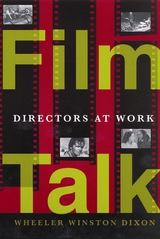 Film Talk: Directors at Work
Dixon, Wheeler Winston
Rutgers University Press, 2007 What 1970s Hollywood filmmaker influenced Quentin Tarantino? How have contemporary Japanese horror films inspired Takashi Shimizu, director of the huge box office hit The Grudge? What is it like to be an African American director in the twenty-first century?
The answers to these questions, along with many more little-known facts and insights, can be found in Film Talk, an in-depth, behind-the-scenes look at filmmaking from the 1940s to the present. In eleven intimate and revealing interviews, contemporary film directors speak frankly about their work-their successes and their disappointments, their personal aspirations, struggles, relationships, and the politics that affect the industry.
A medley of directors including those working in pop culture and documentary, as well as feminist filmmakers, social satirists, and Hollywood mavericks recount stories that have never before been published. Among them are Monte Hellman, the auteur of the minimalist masterpiece Two-Lane Blacktop; Albert Maysles, who with his late brother David, created some of the most important documentaries of the 1960s, including Salesman and The Beatles: What's Happening?; Robert Downey Sr., whose social satires Putney Swope and Greaser's Palace paved the way for a generation of filmmakers; Bennett Miller, whose film Capote won an Academy Award in 2005; and Jamie Babbit, a lesbian crossover director whose low-budget film But I'm a Cheerleader! became a mainstream hit.
The candid conversations, complimented by more than fifty photographs, including many that are rare, make this book essential reading for aspiring moviemakers, film scholars, and everyone interested in the how movies are made and who the fascinating individuals are who make them.
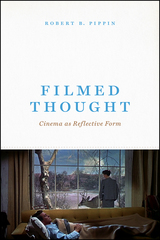 Filmed Thought: Cinema as Reflective Form
Robert B. Pippin
University of Chicago Press, 2020 With the rise of review sites and social media, films today, as soon as they are shown, immediately become the topic of debates on their merits not only as entertainment, but also as serious forms of artistic expression. Philosopher Robert B. Pippin, however, wants us to consider a more radical proposition: film as thought, as a reflective form. Pippin explores this idea through a series of perceptive analyses of cinematic masterpieces, revealing how films can illuminate, in a concrete manner, core features and problems of shared human life.
Filmed Thought examines questions of morality in Almodóvar’s Talk to Her, goodness and naïveté in Hitchcock’s Shadow of a Doubt, love and fantasy in Sirk’s All That Heaven Allows, politics and society in Polanski’s Chinatown and Malick’s The Thin Red Line, and self-understanding and understanding others in Nicholas Ray’s In a Lonely Place and in the Dardennes brothers' oeuvre. In each reading, Pippin pays close attention to what makes these films exceptional as technical works of art (paying special attention to the role of cinematic irony) and as intellectual and philosophical achievements. Throughout, he shows how films offer a view of basic problems of human agency from the inside and allow viewers to think with and through them. Captivating and insightful, Filmed Thought shows us what it means to take cinema seriously not just as art, but as thought, and how this medium provides a singular form of reflection on what it is to be human.
Filmfront Weimar: Representations of the First World War in German Films from the Weimar Period (1919-1933)
Bernadette Kester
Amsterdam University Press, 2003 How was Germany's experience of World War I depicted in film during the following years? Drawing on analysis of the films of the Weimar era—documentaries and feature films addressing the war's causes, life at the front, war at sea, and the home front—Bernadette Kester sketches out the historical context, including reviews and censors' reports, in which these films were made and viewed, and offers much insight into how Germans collectively perceived World War I during its aftermath and beyond.
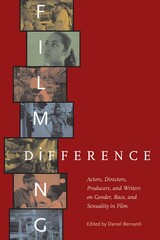 Filming Difference: Actors, Directors, Producers, and Writers on Gender, Race, and Sexuality in Film
Edited by Daniel Bernardi
University of Texas Press, 2009 Addressing representation and identity in a variety of production styles and genres, including experimental film and documentary, independent and mainstream film, and television drama, Filming Difference poses fundamental questions about the ways in which the art and craft of filmmaking force creative people to confront stereotypes and examine their own identities while representing the complexities of their subjects. Selections range from C. A. Griffith's "Del Otro Lado: Border Crossings, Disappearing Souls, and Other Transgressions" and Celine Perreñas Shimizu's "Pain and Pleasure in the Flesh of Machiko Saito's Experimental Movies" to Christopher Bradley's "I Saw You Naked: 'Hard' Acting in 'Gay' Movies," along with Kevin Sandler's interview with Paris Barclay, Yuri Makino's interview with Chris Eyre, and many other perspectives on the implications of film production, writing, producing, and acting. Technical aspects of the craft are considered as well, including how contributors to filmmaking plan and design films and episodic television that feature difference, and how the tools of cinema—such as cinematography and lighting—influence portrayals of gender, race, and sexuality. The struggle between economic pressures and the desire to produce thought-provoking, socially conscious stories forms another core issue raised in Filming Difference. Speaking with critical rigor and creative experience, the contributors to this collection communicate the power of their media.
Filming for the Future: The Work of Louis van Gasteren
Patricia Pisters
Amsterdam University Press, 2016 Louis Van Gasteren was one of the most prolific filmmakers in the history of the Netherlands, with a resume that includes nearly eighty documentaries and two feature films - to say nothing of artworks and books.
Filming for the Future offers an extended exploration of Van Gasteren's work and audio-visual world. Patricia Pisters introduces us to a filmmaker who always had his camera ready and was relentless in filming a wide range of topics and events of national and international importance. Fascinated by technology, deeply engaged with politics, and intensely occupied by the traumatic effects of war, Van Gasteren assembled an unparalleled record of life in twentieth-century Amsterdam and beyond. Filming for the Future will be an invaluable source of documentation and analysis of one of the key filmmakers of our time.
Filming the City: Urban Documents, Design Practices and Social Criticism through the Lens
Edited by Edward Clift, Mirko Guaralda, and Ari Mattes
Intellect Books, 2016 Filming the City brings together the work of filmmakers, architects, designers, video artists, and media specialists to provide three distinct prisms through which to examine the medium of film in the context of the city. The book presents commentaries on particular films and their social and urban relevance, offering contemporary criticisms of both film and urbanism from conflicting perspectives, and documenting examples of how to actively use the medium of film in the design of our cities, spaces and buildings. Bringing a diverse set of contributors to the collection, editors Edward Clift, Ari Mattes, and Mirko Guaralda offer readers a new approach to understanding the complex, multilayered interaction of urban design and film.
Film's Ghosts: Tatsumi Hijikata's Butoh and the Transmutation of 1960s Japan
Stephen Barber
Diaphanes, 2019 Tokyo during the 1960s was in a state of uproar, full of protests, riots, and insurrection. Tatsumi Hijikata—the initiator of the “Butoh” performance art and the seminal figure in Japan’s experimental arts culture of the 1960s—created his most famous works in the context of that turmoil, his experimental film projects and his horror and erotic films uniquely invoking the intensity of the decade. Based on original interviews with Hijikata’s collaborators as well as new research, Film’s Ghosts illuminates Hijikata’s work against the backdrop of 1960s urban culture in Tokyo. This will be an essential book for readers engaged with film and performance, urban cultures and architecture, and Japan’s experimental art and its histories.
 The Films of Aleksandr Rou: Father of Soviet Fairy-Tale Cinema
Deborah Allison
Intellect Books, 2026 Journey through the development of the magical film works of Russia’s “King of the Fairy Tales,” Aleksandr Rou.
More than fifty years after his death, the Soviet filmmaker, Aleksandr Rou, remains a cinematic icon in Russia and many other countries of the former Soviet Union and Eastern Europe. Dubbed “King of the Fairy Tales” and “The Main Storyteller of the Country,” he transformed the landscape of Soviet fantasy and fairy-tale cinema during a directorial career that stretched from 1938 to 1972.
From the heights of Stalinist propaganda cinema, through Khrushchev’s Thaw, and into the Brezhnev Stagnation era, Rou’s films celebrated and perpetuated the nation’s folkloric traditions while constantly refreshing them for new generations of young audiences. The book traces the developments of Rou’s work on fairy-tale film, providing cultural and technical contexts of production and analyzing the features that mark Rou’s personal style.
In English-speaking countries, Rou’s work remains relatively little known, having received only limited theatrical distribution in the West. With home entertainment now offering wider opportunities to discover his unique and exhilarating works, this book provides a timely introduction to the work of one of the world’s great masters of fairy-tale cinema.
The Films of Bill Morrison: Aesthetics of the Archive
Edited by Bernd Herzogenrath
Amsterdam University Press, 2018 Avant-garde filmmaker Bill Morrison has been making films that combine archival footage and contemporary music for decades, and he has recently begun to receive substantial recognition: he was the subject of a retrospective at the Museum of Modern Art, and his 2002 film Decasia was selected for the National Film Registry by the Library of Congress. This is the first book-length study of Morrison's work, covering the whole of his career. It gathers specialists throughout film studies to explore Morrison's "aesthetics of the archive"-his creative play with archival footage and his focus on the materiality of the medium of film.
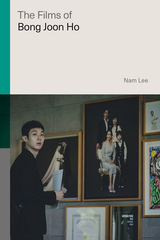 The Films of Bong Joon Ho
Nam Lee
Rutgers University Press, 2020 Bong Joon Ho won the Oscar® for Best Director for Parasite (2019), which also won Best Picture, the first foreign film to do so, and two other Academy Awards. Parasite was the first Korean film to win the Palme d’Or at Cannes. These achievements mark a new career peak for the director, who first achieved wide international acclaim with 2006’s monster movie The Host and whose forays into English-language film with Snowpiercer (2013) and Okja (2017) brought him further recognition.
As this timely book reveals, even as Bong Joon Ho has emerged as an internationally known director, his films still engage with distinctly Korean social and political contexts that may elude many Western viewers. The Films of Bong Joon Ho demonstrates how he hybridizes Hollywood conventions with local realities in order to create a cinema that foregrounds the absurd cultural anomie Koreans have experienced in tandem with their rapid economic development. Film critic and scholar Nam Lee explores how Bong subverts the structures of the genres he works within, from the crime thriller to the sci-fi film, in order to be truthful to Korean realities that often deny the reassurances of the happy Hollywood ending. With detailed readings of Bong’s films from Barking Dogs Never Bite (2000) through Parasite (2019), the book will give readers a new appreciation of this world-class cinematic talent.
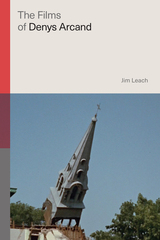 The Films of Denys Arcand
Jim Leach
Rutgers University Press, 2020 Denys Arcand is best known outside Canada for three films that were nominated for Academy Awards for Best Foreign-Language Film: The Decline of the American Empire (1986), Jesus of Montreal (1989), and The Barbarian Invasions (2003), the last of which won the Award. Yet Arcand has been making films since the early 1960s. When he started making films, Quebec was rapidly transforming from a relatively homogeneous community, united by its Catholic faith and French language and culture, into a more fragmented modern society. The Films of Denys Arcand sheds light on how Arcand addressed the impact of these changes from the 1960s, when the long-drawn-out debate on Quebec's possible separation from the rest of Canada began, to the present, in which the traditional cultural heritage has been further fragmented by the increasing presence of diasporic communities. His career and films offer an ideal case study for exploring the contradictions and tensions that have shaped Quebec cinema and culture in a period of increasing globalization and technological change.
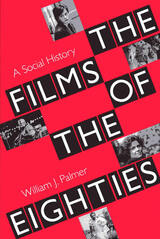 The Films of the Eighties: A Social History
William J. Palmer
Southern Illinois University Press, 1995
In this remarkable sequel to his Films of the Seventies: A Social History, William J. Palmer examines more than three hundred films as texts that represent, revise, parody, comment upon, and generate discussion about major events, issues, and social trends of the eighties.
Palmer defines the dialectic between film art and social history, taking as his theoretical model the "holograph of history" that originated from the New Historicist theories of Hayden White and Dominick LaCapra. Combining the interests and methodologies of social history and film criticism, Palmer contends that film is a socially conscious interpreter and commentator upon the issues of contemporary social history. In the eighties, such issues included the war in Vietnam, the preservation of the American farm, terrorism, nuclear holocaust, changes in Soviet-American relations, neoconservative feminism, and yuppies.
Among the films Palmer examines are Platoon, The Killing Fields, The River, Out of Africa, Little Drummer Girl, Kiss of the Spiderwoman, Silkwood, The Day After, Red Dawn, Moscow on the Hudson, Troop Beverly Hills, and Fatal Attraction. Utilizing the principles of New Historicism, Palmer demonstrates that film can analyze and critique history as well as present it.
 Films That Explode Like Grenades: Robert Kramer and the Search for a Radical Cinema
Whitney Strub
University of Chicago Press The definitive portrait of independent filmmaker Robert Kramer that traces the revolutionary dreams of the Left from the 1960s through the end of the twentieth century.
Robert Kramer (1939–99) was the emblematic filmmaker of the late-1960s New Left in the United States. Yet because most of his three dozen films have been out of circulation for decades, he has long been neglected by film historians and the Left. Kramer was the cofounder of the leftist documentary collective Newsreel and the director of underground films such as Ice (1970), Milestones (1975), and Route One/USA (1989). His films provide distinctive insights into how America’s political terrain has changed over time, capturing each era’s revolutionary ethos and its contradictions. Whitney Strub’s Films That Explode Like Grenades tracks the histories of leftist film and global revolutionary movements via Kramer’s life and travels. Moving among New York City, Chicago, North Vietnam, Paris, Portugal, Angola, and other crucial flashpoints, Kramer left a major and influential body of work in his wake that has fundamentally shaped the work of radical filmmakers across the globe.
For Strub, Kramer’s career is a key thread in an intimate history of the 1960s New Left, one that emphasizes the complexities of the movement’s internal tensions and its legacies. Drawing on visual analysis, extensive archival research across the United States and France, and myriad interviews with Kramer contemporaries, including Bernardine Dohrn, Tom Hayden, Jonas Mekas, and Kramer’s relatives, Strub transforms Kramer’s life story into a dynamic and engaging social history of 1960s radicalism and its generational legacies.
With detailed mapping of Robert Kramer’s many social and artistic contexts, Films That Explode Like Grenades restores him to a place of global importance in leftist cinema.
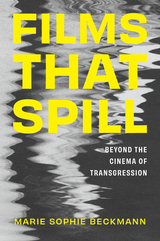 Films That Spill: Beyond the Cinema of Transgression
Marie Sophie Beckmann
Rutgers University Press, 2025 Films That Spill is a comprehensive study of the Cinema of Transgression, a hitherto underexamined moment in US underground film culture. Reconsidering the concept of transgressive cinema not only as a description of the intentionally provocative content of the films but also as a feature of a cross-disciplinary practice, Marie Sophie Beckmann explores how filmmaking in the context of the vibrant and intermingling art, music, performance, and film scenes in 1980s Lower Manhattan spilled over the boundaries of artistic disciplines, media formats, and content concepts. This study not only provides a microhistory of these scenes and insight into their afterlife in archives and exhibitions but also represents an innovative contribution to debates within film, media, and visual culture about the methodological and historiographical challenges posed by the expansion of film beyond the discursive boundaries of cinema.
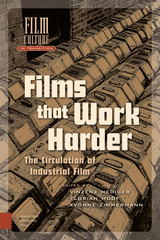 Films That Work Harder: The Circulation of Industrial Film
Vinzenz Hediger
Amsterdam University Press, 2024 What unleashed the forces of global capitalism which continue to shape the world that we live in? Economists and economic historians variously point to innovations in logistics and trade, the emergence of a new set of business-friendly values and the emergence of new forms of applied knowledge in early modernity to solve this riddle. This book focuses on the moving image as a factor of economic development. In a series of in-depth cases studies at the intersection of film and media studies, science and technology studies and economic and social history, Films That Work Harder: The Circulations of Industrial Film presents an in-depth, global perspective on the dynamic relationship between film, industrial organization and economic development. Bringing together new research from leading scholars from Europe, Asia, Australia and North America, this book combines the state of the art in the field with an agenda for a future research.
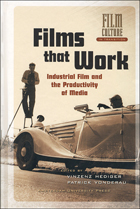 Films that Work: Industrial Film and the Productivity of Media
Edited by Vinzenz Hediger and Patrick Vonderau
Amsterdam University Press, 2009
The history of industrial films - an orphan genre of twentieth-century cinema composed of government-produced and industrially sponsored movies that sought to achieve the goals of their sponsors, rather than the creative artists involved - seems to have left no trace in filmic cultural discourse. At its height the industrial film industry employed thousands, produced several trade journals and festival circuits, engaged with giants of twentieth-century industry like Shell and AT & T, and featured the talents of iconic actors and directors such as Buster Keaton, John Grierson and Alain Resnais. This is the first full-length book, anthology, and annotated bibliography to analyze the industrial film and its remarkable history.
Exploring the potential of the industrial film to uncover renewed and unexplored areas of media studies, this remarkable volume brings together renowned scholars such as Rick Prelinger and Thomas Elsaesser in a discussion of the radical potential and new possibilities in considering the history of this unexplored corporate medium.
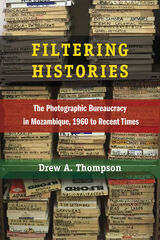 Filtering Histories: The Photographic Bureaucracy in Mozambique, 1960 to Recent Times
Drew A. Thompson
University of Michigan Press, 2021 Photographers and their images were critical to the making of Mozambique, first as a colony of Portugal and then as independent nation at war with apartheid in South Africa. When the Mozambique Liberation Front came to power, it invested substantial human and financial resources in institutional structures involving photography, and used them to insert the nation into global debates over photography's use. The materiality of the photographs created had effects that neither the colonial nor postcolonial state could have imagined.
Filtering Histories: The Photographic Bureaucracy in Mozambique, 1960 to Recent Times tells a history of photography alongside state formation to understand the process of decolonization and state development after colonial rule. At the center of analysis are an array of photographic and illustrated materials from Mozambique, South Africa, Portugal, and Italy. Thompson recreates through oral histories and archival research the procedures and regulations that engulfed the practice and circulation of photography. If photographers and media bureaucracy were proactive in placing images of Mozambique in international news, Mozambicans were agents of self-representation, especially when it came to appearing or disappearing before the camera lens. Drawing attention to the multiple images that one published photograph may conceal, Filtering Histories introduces the popular and material formations of portraiture and photojournalism that informed photography's production, circulation, and archiving in a place like Mozambique. The book reveals how the use of photography by the colonial state and the liberation movement overlapped, and the role that photography played in the transition of power from colonialism to independence.
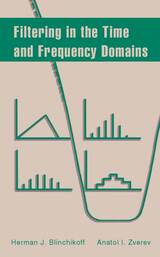 Filtering in the Time and Frequency Domains
Herman J. Blinchikoff
The Institution of Engineering and Technology, 2001 Long regarded as a classic of filter theory and design, this book stands as the most comprehensive treatment of filtering techniques, devices and concepts as well as pertinent mathematical relationships. Analysis and theory are supplemented by detailed design curves, fully explained examples and problem and answer sections. Discussed are the derivation of filtering functions, Fourier, Laplace, Hilbert and z transforms, lowpass responses, the transformation of lowpass into other filter types, the all-pass function, the effect of losses on theoretical responses, matched filtering, methods of time-domain synthesis, and digital filtering. This book is invaluable for engineers other than those who are filter design specialists who need to know about the possibilities and limits of the filtering process in order to use filters competently and confidently in their system designs.
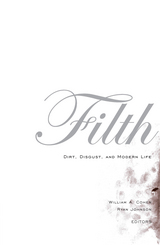 Filth: Dirt, Digust, and Modern Life
William A. Cohen
University of Minnesota Press, 2004 From floating barges of urban refuse to dung-encrusted works of art, from toxic landfills to dirty movies, filth has become a major presence and a point of volatile contention in modern life. This book explores the question of what filth has to do with culture: what critical role the lost, the rejected, the abject, and the dirty play in social management and identity formation. It suggests the ongoing power of culturally mandated categories of exclusion and repression.Focusing on filth in literary and cultural materials from London, Paris, and their colonial outposts in the nineteenth and early twentieth centuries, the essays in Filth, all but one previously unpublished, range over topics as diverse as the building of sewers in nineteenth-century European metropolises, the link between interior design and bourgeois sanitary phobias, fictional representations of laboring women and foreigners as polluting, and relations among disease, disorder, and sexual-racial disharmony. Filth provides the first sustained consideration, both theoretical and historical, of a subject whose power to horrify, fascinate, and repel is as old as civilization itself.Contributors: David S. Barnes, U of Pennsylvania; Neil Blackadder, Knox College; Joseph Bristow, U of California, Los Angeles; Joseph W. Childers, U of California, Riverside; Eileen Cleere, Southwestern U; Natalka Freeland, U of California, Irvine; Pamela K. Gilbert, U of Florida; Christopher Hamlin, U of Notre Dame; William Kupinse, U of Puget Sound; Benjamin Lazier, U of Chicago; David L. Pike, American U; David Trotter, U of Cambridge.William A. Cohen is associate professor of English at the University of Maryland and the author of Sex Scandal: The Private Parts of Victorian Fiction.Ryan Johnson is completing his Ph.D. in the Department of English at Stanford University, where he has served as general editor of the Stanford Humanities Review.
Filthy Labors: Poems
Lauren Marie Schmidt
Northwestern University Press, 2017 In Filthy Labors, Lauren Marie Schmidt draws on personal observations from her position as a poetry teacher at a shelter for homeless mothers, as well as her own roles as daughter and sister through times of family turmoil. She condemns the indignities suffered by the poor and the powerless and praises the work of those who do the caretaking. Here is poetry in the great tradition of social justice literature going back to Walt Whitman. Organized around the Catholic sacraments, these poems call upon Whitman directly, for his words replace the liturgical text of these rituals to rejoice in the redemptive power of poetry in the absence of religion’s saving grace.
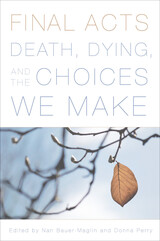 Final Acts: Death, Dying, and the Choices We Make
Bauer-Maglin, Nan
Rutgers University Press, 2010 Today most people die gradually, from incremental illnesses, rather than from the heart attacks or fast-moving diseases that killed earlier generations. Given this new reality, the essays in Final Acts explore how we can make informed and caring end-of-life choices for ourselves and for those we loveùand what can happen without such planning. Contributors include patients, caretakers, physicians, journalists, lawyers, social workers, educators, hospital administrators, academics, psychologists, and a poet, and among them are ethicists, religious believers, and nonbelievers. Some write moving, personal accounts of "good" or 'bad" deaths; others examine the ethical, social, and political implications of slow dying. Essays consider death from natural causes, suicide, and aid-in-dying (assisted suicide). Writing in a style free of technical jargon, the contributors discuss documents that should be prepared (health proxy, do-not-resuscitate order, living will, power of attorney); decision-making (over medical interventions, life support, hospice and palliative care, aid-in-dying, treatment location, speaking for those who can no longer express their will); and the roles played by religion, custom, family, friends, caretakers, money, the medical establishment, and the government. For those who yearn for some measure of control over death, the essayists in Final Acts, from very different backgrounds and with different personal and professional experiences around death and dying, offer insight and hope.
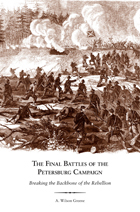 The Final Battles of the Petersburg Campaign: Breaking the Backbone of the Rebellion
A. Wilson Greene
University of Tennessee Press, 2012 The Petersburg Campaign was what finally did it. After months of relentless conflict throughout 1864, the Confederate army led by General Robert E. Lee holed up in the Virginia city of Petersburg as Lieutenant General Ulysses S. Grant's vastly superior forces lurked nearby. The brutal fighting that took place around the city during 1864 and into 1865 decimated both armies as Grant used his manpower advantage to repeatedly smash the Confederate lines, a tactic that eventually resulted in the decisive breakthrough that ultimately doomed the Confederacy. The breakthrough and the events that led up to it are the subject of A. Wilson Greene's groundbreaking book The Final Battles of the Petersburg Campaign, a significant revision of a much-praised work first published in 2000.
Surprisingly, despite Petersburg's decisive importance to the war's outcome, the campaign has received scant attention from historians. Greene's book, with its incisive analysis and compelling narrative, changes this, offering readers a rich account of the personalities and strategies that shaped the final phase of the fighting.
Greene's ultimate focus on the climatic engagements of April 2, 1865, the day that Confederate control of Richmond and Petersburg was effectively ended. The book tells this story from the perspectives of the two army groups that clashed on that day: the Union Sixth Corps and the Confederate Third Corps. But Greene does more than just recount the military tactics at Petersburg; he also connects the reader intimately with how the war affected society and spotlights the soldiers, both officers and enlisted men, whose experiences defined the outcome. Thanks to his extensive research and consultation of rare source materials, Greene gives readers a vibrant perspective on the campaign that broke the Confederate spirit once and for all.
A. Wilson Greene is president of Pamplin Historical Park & The National Museum of the Civil War Soldier near Petersburg, Virginia. He also has taught at Mary Washington College and worked for sixteen years with the National Park Service.
Final Causality in Nature and Human Affairs
Richard F. Hassing
Catholic University of America Press, 2018 This study of the questions of final causality is arranged in historical order from Aristotle to contemporary anthropic-principle cosmology. It discusses such teleological issues as chance and providence, and Aristotle's definition of nature in relation t
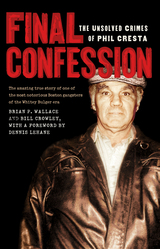 Final Confession: The Unsolved Crimes of Phil Cresta
Brian P. Wallace and Bill Crowley
University Press of New England, 2013 Phil Cresta was no run-of-the-mill thief. Mastermind of the legendary Brink's armored truck robbery and a string of countless other high-stakes heists, he stole more than ten million dollars in escapades that often were breathtakingly daring and at times marvelously inventive. The robberies baffled both police and fellow outlaws for decades, and most of the crimes remain unsolved today. Now the open case files of these memorable thefts can be closed as Cresta himself provides the true story on how they were planned and carried out. Born in Boston's North End in 1928, Cresta was raised in an abusive household. He was sent to Concord Reformatory as a teenager, where he learned the craft of picking locks, a skill later honed during stays at the Charlestown and Walpole prisons in Massachusetts. Following the Brinks robbery in 1968, he was put on the FBI's Ten Most Wanted List, but eluded the law for five years, living in Chicago under an assumed name. After serving time at Walpole for the Brinks job, Cresta died penniless in Chicago in 1995. Yet shortly before his death, he revealed the full extent of his astonishing capers to coauthor Bill Crowley, a retired Boston police detective. Drawing from their extensive conversations, this riveting page-turner chronicles how Cresta, along with partners "Angelo" and "Tony," pulled off robberies of jewelers, rare coin dealers, furriers, and armored trucks, detailing the meticulous planning that marked his criminal career. Cresta's final accounting is brimming with vivid tales of betrayal, murder, and intrigue as well as a colorful cast of characters, including mob bosses, wise guys, informants, paid "ears," corrupt judges, a Hollywood starlet, and even the Mayor of Chicago. Filled with drama, tension, and humor, this absorbing saga takes the reader inside the dangerous yet exhilarating world of a life dedicated to crime.
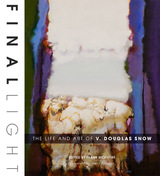 Final Light: The Life and Art of V. Douglas Snow
Frank McEntire
University of Utah Press, 2013 The motivating force behind Final Light was to document Snow’s “visual language”—forged early in his career from abstract expressionist influences typified by Willem de Kooning, Joan Mitchell, Robert Motherwell, and Franz Kline, among others. Final Light represents the first book to examine the legacy of this significant Utah educator and painter. Renowned scholars, writers, and activists who are familiar with Snow’s work—many of whom were his close friends—recount personal experiences with the artist and delve into his motives, methods, and reputation. The volume not only offers their commentaries, but also contains more than 80 exquisite full-color reproductions of Snow’s paintings, dating from the 1950s until 2009, when he died in an auto accident at the age of eighty-two.
A nationally recognized artist, Snow chose to stay in Utah where, when not teaching at the University of Utah, he roamed the southern Utah desert gaining inspiration from the red rock formations, especially the Cockscomb outside his studio near Capitol Reef National Park. Snow said, “Every artist probably wonders if he or she made the right decision to dig in to a certain place.” He dug into the landscape in and around Southern Utah and never regretted it. Just as “Tennessee Williams’s South, William Faulkner’s Mississippi, [or] John Steinbeck’s West Coast, formed their work,” the desert lands of the Colorado Plateau formed Snow’s. Their sense of place, “without provincialism,” said Snow “is what gives their art its enduring power.” Final Light will appeal to art historians and art lovers, especially those interested in abstract expressionism and the art of Utah, the West, and the Southwest.
Chosen by 15 Bytes, Utah's art magazine, as the most exceptional art book for 2014.
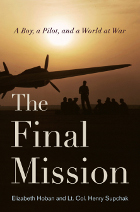 The Final Mission: A Boy, a Pilot, and a World at War
Elizabeth Hoban and Lt. Col. Henry Supchak
Westholme Publishing, 2012 The Inspiring True Story of a World War II Bomber Pilot Who Saved an Austrian Village—and the Incredible Search Across a Lifetime to Repay That Debt In July 1944, Lt. Henry Supchak was flying his second-to-last mission over Germany when his B-17 bomber, Priority Gal, was hit by antiaircraft fire, disabling two engines and wounding him in the thigh. He attempted to reach neutral Switzerland, but was forced instead to order his eight crewmen to bail out over Austria. As Supchak prepared to abandon his aircraft he saw that it was on a collision course with an Alpine village. He instinctively got back into his seat, adjusted the controls, and barely escaped before the plane exploded at the base of a mountain. He parachuted into a pasture where a shepherd boy and his aunt stared in disbelief at this “man who fell from the sky.” Almost immediately, German infantry surrounded the pilot and took him away to solitary confinement. Although slightly burned by the exploding aircraft, the boy managed to find out where the wounded pilot was being held and snuck food and water to him before Supchak and his crew were taken away to a notorious prison camp for the rest of the war. Liberated by Patton’s Third Army in April 1945, Supchak remained in the air force after World War II and even advised Gregory Peck during the filming of Twelve O’Clock High. But he carried deep scars from his war experience. Plagued by flashbacks, Supchak attempted to find closure. Opening up to his family and others about his aircombat missions and internment failed to rid him of the nagging dreams as he had hoped. But an inspired quest to find his former crew members before they all passed away put the pilot on a path of peace. A world away, an Austrian entrepreneur was searching for Supchak, the enemy pilot he had seen fall from the sky as a boy and whom he had never forgotten. Despite incredible odds, the pilot and the boy were able to meet again at the spot where Priority Gal had gone down, in a magical, miraculous reunion of closure. Beautifully written with honesty and emotion, The Final Mission: A Boy, a Pilot, and a World at War is a gripping and uplifting story of forgiveness, reconciliation, and healing from the devastation of war.
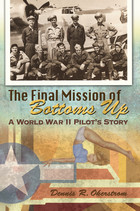 The Final Mission of Bottoms Up: A World War II Pilot's Story
Dennis R. Okerstrom
University of Missouri Press, 2011 On November 18, 1944, the end of the war in Europe finally in sight, American copilot Lieutenant Lee Lamar struggled alongside pilot Randall Darden to keep Bottoms Up, their B-24J Liberator, in the air. They and their crew of eight young men had believed the intelligence officer who, at the predawn briefing at their base in southern Italy, had confided that their mission that day would be a milk run. But that twenty-first mission out of Italy would be their last. Bottoms Up was staggered by an antiaircraft shell that sent it plunging three miles earthward, the pilots recovering control at just 5,000 feet. With two engines out, they tried to make it to a tiny strip on a British-held island in the Adriatic Sea and in desperation threw out everything not essential to flight: machine guns, belts of ammunition, flak jackets. But over Pula, in what is now Croatia, they were once more hit by German fire, and the focus quickly became escaping the doomed bomber. Seemingly unable to extricate himself, Lamar all but surrendered to death before fortuitously bailing out. He was captured the next day and spent the rest of the war as a prisoner at a stalag on the Baltic Sea, suffering the deprivations of little food and heat in Europe’s coldest winter in a century. He never saw most of his crew again. Then, in 2006, more than sixty years after these life-changing experiences, Lamar received an email from Croatian archaeologist Luka Bekic, who had discovered the wreckage of Bottoms Up. A veteran of the Balkan wars of the 1990s, Bekic felt compelled to find out the crew’s identities and fates. Lee Lamar, a boy from a hardscrabble farm in rural northwestern Missouri, had gone to college on the GI Bill, become a civil engineer, gotten married, and raised a family. Yet, for all the opportunity that stemmed from his wartime service, part of him was lost. The prohibition on asking prisoners of war their memories during the repatriation process prevented him from reconciling himself to the events of that November day. That changed when, nearly a year after being contacted by Bekic, Lamar visited the site, hoping to gain closure, and met the Croatian Partisans who had helped some members of his crew escape. In this absorbing, alternating account of World War II and its aftermath, Dennis R. Okerstrom chronicles, through Lee Lamar’s experiences, the Great Depression generation who went on to fight in the most expensive war in history. This is the story of the young men who flew Bottoms Up on her final mission, of Lamar’s trip back to the scene of his recurring nightmare, and of a remarkable convergence of international courage, perseverance, and friendship.
 Final Negotiations: A Story of Love, and Chronic Illness
Carolyn Ellis
Temple University Press, 1995
When Carolyn Ellis, a graduate student, and Gene Weinstein, her Professor, fell in love, he was experiencing the first stages of emphysema. As he became increasingly disabled and immobile, these two intensely connected partners fought to maintain their love and to live a meaningful life. They learned to negotiate their daily lives in a way that enabled each of them to feel sufficiently autonomous—him not always like a patient and her not always like a caretaker. Writing as a sociologist, Ellis protrays their life together as a way to understand the complexities of romance, of living with a progressive illness, and, in the final negotiation and reversal of positions, of coping with the loss of a loved one.
This rare memoir full of often raw details and emotions becomes an intimate conversation about the intricacies of feeling and relating in a relationship. What Ellis calls experimental ethnography is a finely crafted, forthright, and daring story framed by the author's reflections on writing about and analyzing one's own life. Casting off the safe distance of most social science inquiry, she surrenders the private shroud of a complex relationship to bring sociology closer to literature.
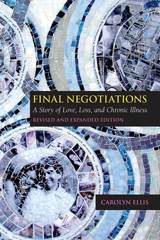 Final Negotiations: A Story of Love, Loss, and Chronic Illness
Carolyn Ellis
Temple University Press, 2018 In this revised and expanded edition of Final Negotiations—a personal account of caring for her partner, Gene Weinstein, and then coping with losing him to chronic emphysema— Ellis reflects back on her experiences as a caregiver, focusing on identity, vulnerability, emotions, and the aging process of an engaged academic. Now, decades later, she reconsiders who she was then, and how she has continued to be affected both by these events and by writing about them. She contemplates how she might act, think, and feel if she were going through the caregiving process again, now.
Taking an autoethnographic perspective, Ellis focuses on her feeling and thinking self in relationships, narrating particular lived experiences that offer a gateway into understanding interpersonal and cultural life. In her new epilogue, “From New Endings to New Beginnings,” Ellis describes her changed identity and how Final Negotiations informs her life and her understanding of how she and her current partner grow older together. She hopes her book provides companionship and comfort to readers who also will suffer loss in their lives.
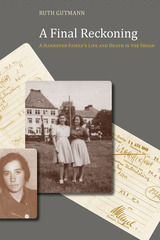 A Final Reckoning: A Hannover Family's Life and Death in the Shoah
Ruth Gutmann, Foreword by Kenneth Waltzer
University of Alabama Press, 2013 A work of both childhood memory and adult reflection undergirded with scholarly research
Ruth Herskovits Gutmann’s powerful memoir recounts her life not only as a concentration camp inmate and survivor, but also as a sister and daughter. Born in 1928, Gutmann and her twin sister, Eva, escaped the growing Nazi threat in Germany on a Kindertransport to Holland in 1939
.
Gutmann’s compelling story captures many facets of the Jewish experience in Nazi Germany. She describes her early life in Hannover as the daughter of a prominent and patriotic member of the Jewish community. Her flight on the Kindertransport offers a vivid, firsthand account of that effort to save the children of Jewish families. Her memories of the camps include coming to the attention of Josef Mengele, who often used twins in human experiments. Gutmann writes with moving clarity and nuance about the complex feelings of survivorship.
A Final Reckoning provides not only insights into Gutmann’s own experience as a child in the midst of the atrocities of the Holocaust, but also a window into the lives of those, like her father, who were forced to carry on and comply with the regime that would ultimately bring about their demise.
Final Report: Evaluation of Tools and Metrics to Support Employer Selection of Health Plans
Soeren Mattke
RAND Corporation, 2014 The Affordable Care Act places strong emphasis on quality of care as a means to improve outcomes for Americans and promote the financial sustainability of our health care system. This report attempts to help employers understand the structural differences between health plans and the performance dimensions along which plans can differ, as well as to educate employers about available tools that can be used to evaluate plan options.
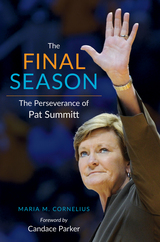 The Final Season: The Perseverance of Pat Summitt
Maria Cornelius
University of Tennessee Press, 2016 FOREWORD INDIES GOLD AWARD, SPORTS CATEGORY, 2016
With 1,098 wins and eight national championships, Lady Vol Coach Pat Summitt has left a remarkable legacy of perseverance, leadership, and passion for the game—but her victories on the court aren’t the only legacy she has left in her wake.
Since the beginning of her career as Lady Vol head coach at twenty-two years old, Pat Head Summitt effectively established the University of Tennessee Lady Vols as the top women’s athletics program in the nation. The winningest coach in the history of NCAA basketball, Summitt overcame one obstacle after another on the road to every victory, but it is the lives she has impacted along the way that tell the story of her true legacy. Forever a role model for young women, expecting nothing but the best from her players and from those around her, her legacy has never faltered—not even during her final season as head coach, when she faced her fiercest adversary yet: the diagnosis of early-onset Alzheimer’s disease.
In The Final Season: The Perseverance of Pat Summitt, Maria M. Cornelius tells the story of her final coaching season through the eyes of those who know her best, from players to support staff to Summitt’s closest friends and advisors. Beginning with the diagnosis that shook the Tennessee community in the summer of 2011 and continuing through to the final game of the 2011–12 season, The Final Season presents readers with a behind-the-scenes look at the conclusion of Summitt’s coaching career, detailing from the perspective of a sports writer how her diagnosis impacted her players and her staff as well as her fans.
With forewords by former Lady Vol Candace Parker and Swish Appeal editor Mike Robinson, The Final Season reveals how Summitt’s remarkable story of perseverance not only united a team of young women but also brought an entire sports following together, revealing an incredible support system that spanned far beyond Summitt’s Tennessee community. The coach’s determined spirit, selfless love, and sense of humor shine through the pages of Cornelius’s book, painting for readers the picture of a beloved leader and detailing the personal moments of defeat and triumph that make Summitt a true champion.
MARIA M. CORNELIUS has written about the Lady Vols basketball program since 1998 for local, regional and national media. A freelance writer for Inside Tennessee, Cornelius lives in Knoxville and continues to cover the program. She works full-time as a writer/editor for Moxley Carmichael, a leading public relations and communications firm in East Tennessee.
 Final Solutions: Human Nature, Capitalism and Genocide
Sabby Sagall
Pluto Press, 2013 Final Solutions offers a ground-breaking and genuinely unique analysis of modern genocide. Sabby Sagall draws on the insights of the Frankfurt school and Wilhelm Reich to create an innovative combination of Marxism and psychoanalysis. He argues that genocide is a product of an ‘irrational’ destructiveness by social classes or communities that have suffered major historical defeats or similar forms of extreme stress.
Sagall shows how the denial of human needs and the ensuing feelings of isolation and powerlessness propel groups to project their impotent rage, hatred and destructiveness engendered by these defeats on to the 'outsider' and the 'other'.
The book applies this theoretical framework to four modern genocides – that of the Native Americans, the Armenians, the Jews and the Rwandan Tutsis. This is a truly pioneering contribution which adds to our understanding of some of the darkest hours of humanity – and how we can stop them from happening again.
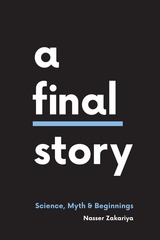 A Final Story: Science, Myth, and Beginnings
Nasser Zakariya
University of Chicago Press, 2017 Popular science readers embrace epics—the sweeping stories that claim to tell the history of all the universe, from the cosmological to the biological to the social. And the appeal is understandable: in writing these works, authors such as E. O. Wilson or Steven Weinberg deliberately seek to move beyond particular disciplines, to create a compelling story weaving together natural historical events, scientific endeavor, human discovery, and contemporary existential concerns.
In A Final Story, Nasser Zakariya delves into the origins and ambitions of these scientific epics, from the nineteenth century to the present, to see what they reveal about the relationship between storytelling, integrated scientific knowledge, and historical method. While seeking to transcend the perspectives of their own eras, the authors of the epics and the debates surrounding them are embedded in political and social struggles of their own times, struggles to which the epics in turn respond. In attempts to narrate an approach to a final, true account, these synthesizing efforts shape and orient scientific developments old and new. By looking closely at the composition of science epics and the related genres developed along with them, we are able to view the historical narrative of science as a form of knowledge itself, one that discloses much about the development of our understanding of and relationship to science over time.
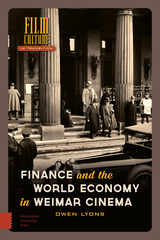 Finance and the World Economy in Weimar Cinema
Owen Lyons
Amsterdam University Press, 2023 After the First World War, the effects of financial crisis could be felt in all corners of the newly formed Weimar Republic. The newly interconnected world economy was barely understood and yet it was increasingly made visible in the films of the time. The complexities of this system were reflected on screen to both the everyday spectator as well as a new class of financial workers who looked to popular depictions of speculation and crisis to make sense of their own place on the shifting ground of modern life. Finance and the World Economy in Weimar Cinema turns to the many underexamined depictions of finance capital that appear in the films of 1920s Germany. The representation of finance capital in these films is essential to our understanding of the culture of the Weimar Republic – particularly in the relation between finance and ideas of gender, nation and modernity. As visual records, these films reveal the stock exchange as a key space of modernity and coincide with the abstraction of finance as a vast labour of representation in its own right. In so doing, they introduce core visual tropes that have become essential to our understanding of finance and capitalism throughout the twentieth century.
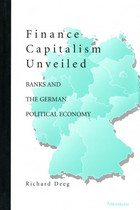 Finance Capitalism Unveiled: Banks and the German Political Economy
Richard Deeg
University of Michigan Press, 1999 If we are moving toward one global financial market, will all national financial systems that determine how businesses raise money look the same? Richard Deeg argues that, despite financial market integration and considerable harmonization in the regulation of financial markets, the traditional structure and economic functions of national financial systems are not inevitably undermined. Using the case of Germany--a country with a strong and distinctive financial sector that is at the center of the pressures of economic integration--the author shows how the unique aspects of the German financial sector and its relationship to the German economy have persisted notwithstanding powerful pressures to change. Posing the German model of coordinated capitalism in which banks play an important role in shaping both firm behavior and the possibilities for state intervention in the economy against the liberal model of the United States and Britain in which the securities markets play a much greater role than banks, Deeg shows how the German model has survived competitive pressures in the international economic system that have pushed Germany--and other countries--toward the liberal model.
This book will appeal to political scientists and economists interested in international financial markets, globalization, and the comparative study of domestic financial markets, as well as in German politics and the German economy.
Richard Deeg is Assistant Professor of Political Science, Temple University.
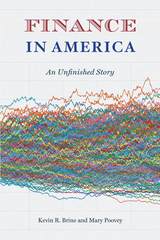 Finance in America: An Unfinished Story
Kevin R. Brine and Mary Poovey
University of Chicago Press, 2017 The economic crisis of 2008 led to an unprecedented focus on the world of high finance—and revealed it to be far more arcane and influential than most people could ever have imagined. Any hope of avoiding future crises, it’s clear, rest on understanding finance itself.
To understand finance, however, we have to learn its history, and this book fills that need. Kevin R. Brine, an industry veteran, and Mary Poovey, an acclaimed historian, show that finance as we know it today emerged gradually in the late nineteenth century and only coalesced after World War II, becoming ever more complicated—and ever more central to the American economy. The authors explain the models, regulations, and institutions at the heart of modern finance and uncover the complex and sometimes surprising origins of its critical features, such as corporate accounting standards, the Federal Reserve System, risk management practices, and American Keynesian and New Classic monetary economics. This book sees finance through its highs and lows, from pre-Depression to post-Recession, exploring the myriad ways in which the practices of finance and the realities of the economy influenced one another through the years.
A masterwork of collaboration, Finance in America lays bare the theories and practices that constitute finance, opening up the discussion of its role and risks to a broad range of scholars and citizens.
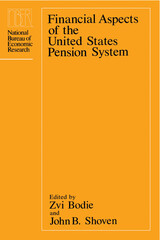 Financial Aspects of the United States Pension System
Edited by Zvi Bodie and John B. Shoven
University of Chicago Press, 1984 This book provides valuable information and analysis to managers, policymakers, and investment counselors in the rapidly expanding field of pension funding. American workers, too, need answers and insights on how to invest their money and plan for their retirement. fifteen of America's leading financial analysts address such pressing questions as
-What is the current financial status of the elderly, and how vulnerable are they to inflation?
-What is the impact of inflation on the private pension system, and what are the effects of alternative indexing schemes?
-What roles can the social security system play in the provision of retirement income?
-What is the effect of the tax code and the Employee Retirement Income Security Act of 1974 (ERISA) on corporate pension policy?
-How well funded are corporate pension plans, and is a firm's unfunded pension liability fully reflected in the market value of its common stock?
Many of the conclusions these experts reach contradict and challenge popular views, thus providing fertile ground for innovation in pension planning.
 Financial Basics: A Money-Management Guide for Students, 2nd Edition
Susan Knox
Ohio State University Press, 2016 Students are confronted with major financial decisions as they enter college, and yet they have little experience with personal finance. Their decisions, if not well made, could adversely affect them throughout their lives. This book is meant to empower students at the beginning of their financial lives with basic, straightforward information on managing bank accounts, creating spending plans, determining how much they can afford to pay for college, making student-loan decisions, establishing a credit history, and other money-management options.
This 2nd edition updates changes in online banking, smartphone apps, credit cards, and student loans but retains basic financial information that ensures students won’t learn about money the hard way. A chapter for parents has been added so they can help their students become financially knowledgeable, and it includes advice for parents about making decisions related to college costs. In addition, a chapter for grandparents contains suggestions on how to help college-bound grandchildren—financially and in other ways—without endangering their own financial security. A basic investments chapter is included for first-time investors.
The intent of Financial Basics is to enhance student readers’ financial knowledge and provide money-management options for finding their own best way to become masters of their money.
The Financial Crisis and the Global South: A Development Perspective
Yilmaz Akyuz
Pluto Press, 2013 This book is a major contribution exploring the policy options available for developing and emerging economies in response to the global economic crises.
Written by a highly respected development economist, the book gives a clear-eyed account of the issues particular to these countries and critically evaluates different policy approaches, including reforms in financial, monetary and trade policies. Informed by deep scholarship as well as practical experience, Yilmaz Akyüz draws on empirical data, historical context and theoretical expertise, with special attention paid to issues such as the role of the International Monetary Fund and China.
The Financial Crisis and the Global South is a landmark book that will be of interest to practitioners, scholars, theorists and students of economics and development studies.
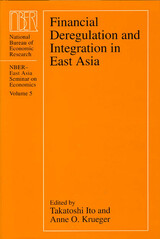 Financial Deregulation and Integration in East Asia
Edited by Takatoshi Ito and Anne O. Krueger
University of Chicago Press, 1996 The increased mobility and volume of international capital flows is a striking trend in international finance. While countries worldwide have engaged in financial deregulation, nowhere is this pattern more pronounced than in East Asia, where it has affected in unanticipated ways the behavior of exchange rates, interest rates, and capital flows.
In these thirteen essays, American and Asian scholars analyze the effects of financial deregulation and integration on East Asian markets. Topics covered include the roles of the United States and Japan in trading with Asian countries, macroeconomic policy implications of export-led growth in Korea and Taiwan, the effects of foreign direct investment in China, and the impact of financial liberalization in Japan, Korea, and Singapore.
Demonstrating the complexity of financial deregulation and the challenges it poses for policy makers, this volume provides an excellent picture of the overall status of East Asian financial markets for scholars in international finance and Asian economic development.
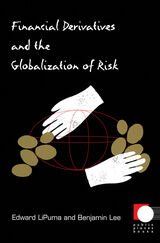 Financial Derivatives and the Globalization of Risk
Edward LiPuma and Benjamin Lee
Duke University Press, 2005 The market for financial derivatives is far and away the largest and most powerful market in the world, and it is growing exponentially. In 1970 the yearly valuation of financial derivatives was only a few million dollars. By 1980 the sum had swollen to nearly one hundred million dollars. By 1990 it had climbed to almost one hundred billion dollars, and in 2000 it approached one hundred trillion. Created and sustained by a small number of European and American banks, corporations, and hedge funds, the derivatives market has an enormous impact on the economies of nations—particularly poorer nations—because it controls the price of money. Derivatives bought and sold by means of computer keystrokes in London and New York affect the price of food, clothing, and housing in Johannesburg, Kuala Lumpur, and Buenos Aires. Arguing that social theorists concerned with globalization must familiarize themselves with the mechanisms of a world economy based on the rapid circulation of capital, Edward LiPuma and Benjamin Lee offer a concise introduction to financial derivatives. LiPuma and Lee explain how derivatives are essentially wagers—often on the fluctuations of national currencies—based on models that aggregate and price risk. They describe how these financial instruments are changing the face of capitalism, undermining the power of nations and perpetrating a new and less visible form of domination on postcolonial societies. As they ask: How does one know about, let alone demonstrate against, an unlisted, virtual, offshore corporation that operates in an unregulated electronic space using a secret proprietary trading strategy to buy and sell arcane financial instruments? LiPuma and Lee provide a necessary look at the obscure but consequential role of financial derivatives in the global economy.
 Financial Development in Korea, 1945–1978
David C. Cole and Yung Chul Park
Harvard University Press, 1983 This ninth title in the series Studies in the Modernization of the Republic of Korea offers new insights into the role of finance in a rapidly developing country. Combining history and theory, it provides a rigorous test of previous theoretical propositions. The study illustrates the complexity of the Korean financial system and the danger of easy generalization from partial evidence.
The two major components of the financial system are brought into focus—one regulated and statistically recorded, the other unregulated, unrecorded. The burden of financial intermediation shifts from one to the other largely in response to government policy measures. By looking only at the regulated sector, previous studies have often misperceived the role of the financial system and the effects of government policies. The financial scandal in Seoul in May 1982 vividly demonstrated that the unregulated part of the system is still important and that overregulation of the “modern” part generates strong pressures for perpetuating the illegal, unregulated, “traditional” financial institutions.
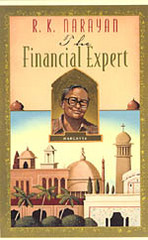 The Financial Expert
R. K. Narayan
University of Chicago Press, 1981 In The Financial Expert, R. K. Narayan once again transports readers to the southern Indian town of Malgudi. This story centers around the life and pursuits of Margayya, a man of many hopes but few resources, who spends his time under the banyan tree offering expert financial advice to those willing to pay for his knowledge. Margayya's rags-to-riches story brings forth the rich imagery of Indian life with the absorbing details and vivid storytelling that are Narayan's trademarks.
"The novels of R. K. Narayan are the best I have read in any language for a long time."—Amit Roy, Daily Telegraph
"The experience of reading one of his novels is . . . comparable to one's first reaction to the great Russian novels: the fresh realization of the common humanity of all peoples."—Margaret Parton, New York Herald Tribune Book Review
"The hardest of all things for a novelist to communicate is the extraordinary ordinariness of most human happiness. . . . Jane Austen, Soseki, Chekhov: a few bring it off. Narayan is one of them."—Francis King, Spectator
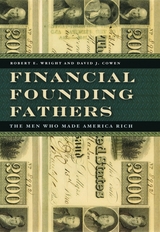 Financial Founding Fathers: The Men Who Made America Rich
Robert E. Wright and David J. Cowen
University of Chicago Press, 2006 When you think of the founding fathers, you think of men like George Washington, Thomas Jefferson, and Benjamin Franklin—exceptional minds and matchless statesmen who led the colonies to a seemingly impossible victory over the British and established the constitutional and legal framework for our democratic government. But the American Revolution was about far more than freedom and liberty. It was about economics as well.
Robert E. Wright and David J. Cowen here chronicle how a different group of founding fathers forged the wealth and institutions necessary to transform the American colonies from a diffuse alliance of contending business interests into one cohesive economic superpower. From Alexander Hamilton to Andrew Jackson, the authors focus on the lives of nine Americans in particular—some famous, some unknown, others misunderstood, but all among our nation’s financial founding fathers. Such men were instrumental in creating and nurturing a financial system that drove economic growth in the nascent United States because they were quick to realize that wealth was as crucial as the Constitution in securing the blessings of liberty and promoting the general welfare. The astonishing economic development made possible by our financial founding fathers was indispensable to the preservation of national unity and of support for a government that was then still a profoundly radical and delicate political experiment.
Grand in scope and vision, Financial Founding Fathers is an entertaining and inspiring history of the men who made America rich and steered her toward greatness.
 Financial Liberalization and Economic Development in Korea, 1980–2020
Yung Chul Park
Harvard University Press, 2021 Since the early 1980s, Korea’s financial development has been a tale of liberalization and opening. After the 1997 financial crisis, great strides were made in building a market-oriented financial system through sweeping reforms for deregulation and the opening of financial markets. However, the new system failed to steer the country away from a credit card boom and bust in 2003, a liquidity crisis in 2008, and a run on its savings banks in 2011, and has been severely tested again by the ongoing COVID-19 pandemic crisis. Financial liberalization, clearly, has been no panacea.
This study analyzes the deepening of and structural changes in Korea’s financial system since the early 1980s and presents the empirical results of the effects of financial development on economic growth, stability, and the distribution of income. It finds that, contrary to conventional wisdom, financial liberalization has contributed little to fostering the growth and stability of the Korean economy and has exacerbated income distribution problems. Are there any merits in financial liberalization? The authors answer this query through empirical examinations of the theories of finance and growth. They point to a clear need to further improve the efficiency, soundness, and stability of Korean financial institutions and markets.
 Financial Management for Libraries
William W. Sannwald
American Library Association, 2018 Presenting financial management principles and best practices applicable to both public and academic libraries, this comprehensive text elucidates a broad array of issues crucial for those entering a managerial position. Both thorough and straightforward, Sannwald's treatment - gives readers a solid grounding in the basics of accounting and finance, with an emphasis on applicability to library management and operations;
- ties budgets and strategic planning to library vision, mission, goals, and objectives;
- discusses the roles of stakeholders such as boards, governmental/municipal bodies, the university, and the community;
- looks at a variety of funding sources, from tax revenue to gifts and donations, and presents sound strategies for including them when projecting income and expenses;
- articulates and discusses the pros and cons of various budget strategies;
- includes sample budgets and forms that can be customized as needed;
- offers expert guidance on modifying budgets for windfalls and shortfalls;
- explains operating ratios, fiscal benchmarking, and metrics, demonstrating how to use these to effectively create and manage a budget and assess the fiscal health of the library; and
- advises on how to effectively prepare and present a budget and annual financial statements to a library's governing agency.
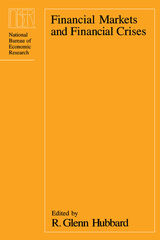 Financial Markets and Financial Crises
Edited by R. Glenn Hubbard
University of Chicago Press, 1991 Warnings of the threat of an impending financial crisis are not new, but do we really know what constitutes an actual episode of crisis and how, once begun, it can be prevented from escalating into a full-blown economic collapse?
Using both historical and contemporary episodes of breakdowns in financial trade, contributors to this volume draw insights from theory and empirical data, from the experience of closed and open economies worldwide, and from detailed case studies. They explore the susceptibility of American corporations to economic downturns; the origins of banking panics; and the behavior of financial markets during periods of crisis. Sever papers specifically address the current thrift crisis—including a detailed analysis of the over 500 FSLIC-insured thrifts in the southeast—and seriously challenge the value of recent measures aimed at preventing future collapse in that industry. Government economists and policy makers, scholars of industry and banking, and many in the business community will find these timely papers an invaluable reference.
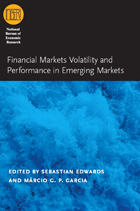 Financial Markets Volatility and Performance in Emerging Markets
Edited by Sebastian Edwards and Márcio G. P. Garcia
University of Chicago Press, 2008 Capital mobility is a double-edged sword for emerging economies, as governments must weigh the benefits of investment against the potential economic costs and political consequences of currency crises, devaluations, and instability. Financial Markets Volatility and Performance in Emerging Markets addresses the delicate balance between capital mobility and capital controls as developing countries navigate the convoluted global network of private investors, hedge funds, large corporations, and international institutions such as the International Monetary Fund.
A group of experts here examine rapidly globalizing financial markets with regard to capital flows and crises, domestic credit, international financial integration, and economic policy. Featuring detailed analyses and cross-national comparisons of countries such as Brazil, Argentina, Uruguay, and Korea, this book will shape economists’ and policymakers’ understanding of the effectiveness of restrictions on capital mobility in the world’s most fragile economies.
 Financial Missionaries to the World: The Politics and Culture of Dollar Diplomacy, 1900–1930
Emily S. Rosenberg
Duke University Press, 2003 Winner of the Society for Historians of American Foreign Relations Robert H. Ferrell Book Prize
Financial Missionaries to the World establishes the broad scope and significance of "dollar diplomacy"—the use of international lending and advising—to early-twentieth-century U.S. foreign policy. Combining diplomatic, economic, and cultural history, the distinguished historian Emily S. Rosenberg shows how private bank loans were extended to leverage the acceptance of American financial advisers by foreign governments. In an analysis striking in its relevance to contemporary debates over international loans, she reveals how a practice initially justified as a progressive means to extend “civilization” by promoting economic stability and progress became embroiled in controversy. Vocal critics at home and abroad charged that American loans and financial oversight constituted a new imperialism that fostered exploitation of less powerful nations. By the mid-1920s, Rosenberg explains, even early supporters of dollar diplomacy worried that by facilitating excessive borrowing, the practice might induce the very instability and default that it supposedly worked against.
"[A] major and superb contribution to the history of U.S. foreign relations. . . . [Emily S. Rosenberg] has opened up a whole new research field in international history."—Anders Stephanson, Journal of American History "[A] landmark in the historiography of American foreign relations."—Melvyn P. Leffler, author of A Preponderence of Power: National Security, the Truman Administration, and the Cold War "Fascinating."—Christopher Clark, Times Literary Supplement
 Financial Missionaries to the World: The Politics and Culture of Dollar Diplomacy, 1900-1930
Emily S. Rosenberg
Harvard University Press, 1999 Recently, a volatile global economy has challenged the United States to rethink its financial policies toward economically troubled countries. Emily Rosenberg suggests that perplexing questions about how to standardize practices within the global financial system, and thereby strengthen market economies in unstable areas of the world, go back to the early decades of this century. Then, dollar diplomacy--the practice of extending private U.S. bank loans in exchange for financial supervision over other nations--provided America's major approach to stabilizing economies overseas and expanding its influence.
Policymakers, private bankers, and the members of the emerging profession of international economic advising cooperated in devising arrangements by which U.S. banks would extend foreign loans on the condition that the countries hire U.S. experts to revamp financial systems and exercise some supervision. Rosenberg demonstrates that these arrangements were not simply technical and shows how they became central to foreign policy debates during the 1920s, when increasingly vocal critics at home and abroad assailed dollar diplomacy as a new imperialism. She explores how loan-for-supervision arrangements interrelated with broad cultural notions of racial destiny, professional expertise, and the virtues of manliness. An innovative, interdisciplinary study, Financial Missionaries to the World illuminates the dilemmas of public/private cooperation in foreign economic policy and the incalculable consequences of exercising financial power in the global marketplace.
Financial Policies and the World Capital Market: The Problem of Latin American Countries
Edited by Pedro Aspe Armella, Rudiger Dornbusch, and Maurice Obstfeld
University of Chicago Press, 1983 The essays brought together in this volume share a common objective: To bring a unifying methodological approach to the analysis of financial problems in developing, open economies. While the primary focus is on contemporary Latin America, the methods employed and the lessons learned are of wider applicability. The papers address the financial integration issue from three different perspectives. In some cases, a country study is the vehicle for an econometric investigation of a particular external linkage. In other cases, an individual country's experience suggests an economic model in which the stylized facts may be analyzed and developed. A third direction is unabashedly theoretical and formulates more general principles which are broadly applicable rather than country-specific.
|
|
